It seems we can’t find what you’re looking for. Perhaps searching can help.
Sign Up for newsletter!
Subscribe to get the latest eBook!
Hotline






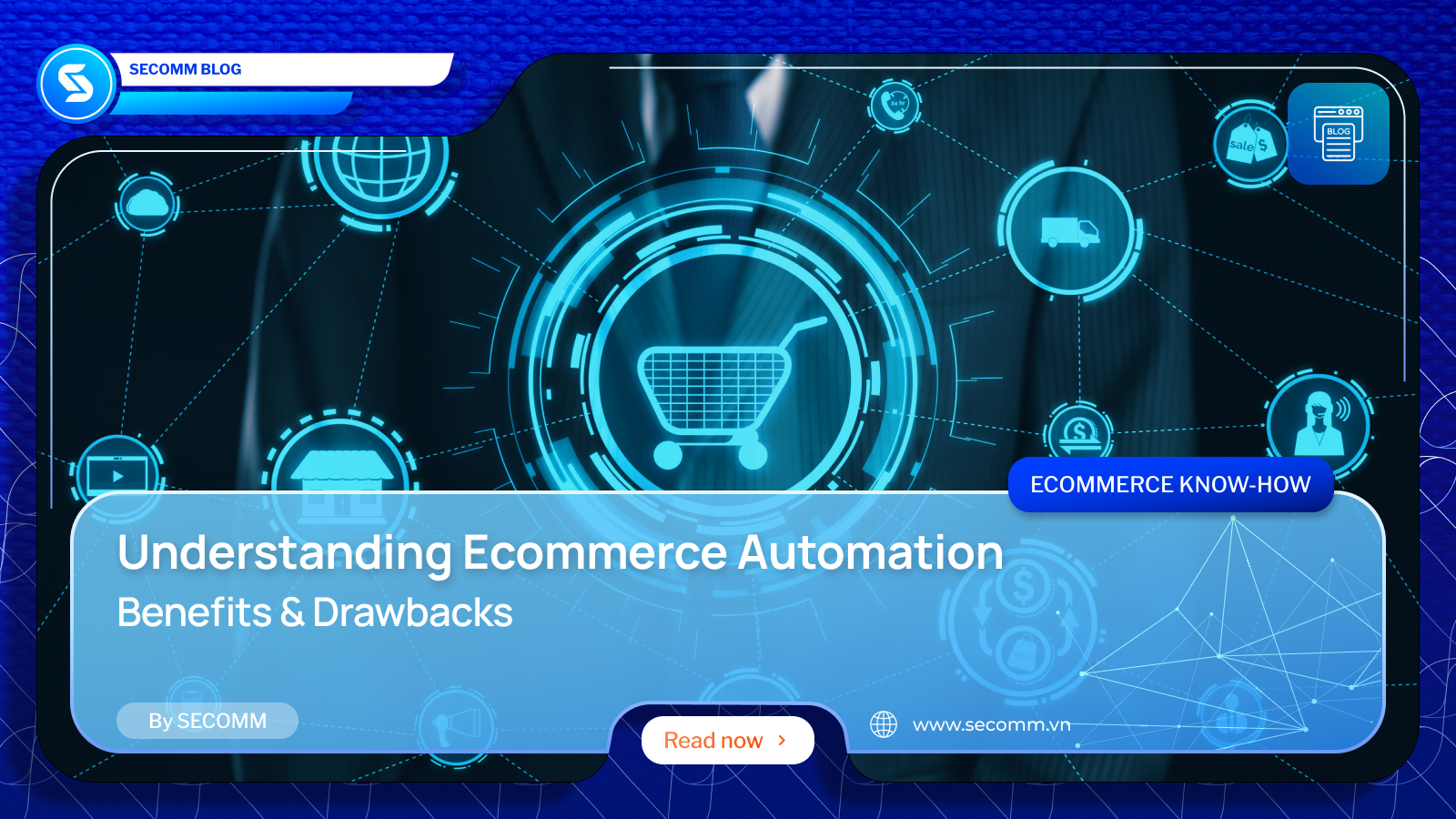
In today’s fast-paced digital world, eCommerce has become a crucial aspect of how businesses operate and grow. As global internet access and adoption rapidly increase, with over five billion internet users worldwide, the number of people making purchases online is ever-increasing. In 2024, retail eCommerce sales are estimated to exceed 6.3 trillion U.S. dollars worldwide, and this figure is expected to reach new heights in the coming years.
Knowing this, companies are constantly seeking ways to enhance efficiency, reduce errors, and provide a seamless customer experience. This is where eCommerce automation comes into play.
By leveraging advanced technologies and tools, businesses can automate repetitive tasks, streamline operations, and scale their efforts without the need for proportional increases in manual labor.
In this blog, we’ll dive into the concept of eCommerce automation, exploring its benefits and drawbacks to help you understand how it can transform your online business. Whether you’re a small startup or a large enterprise, understanding eCommerce automation can be a game-changer in optimizing your operations and staying competitive in the market.
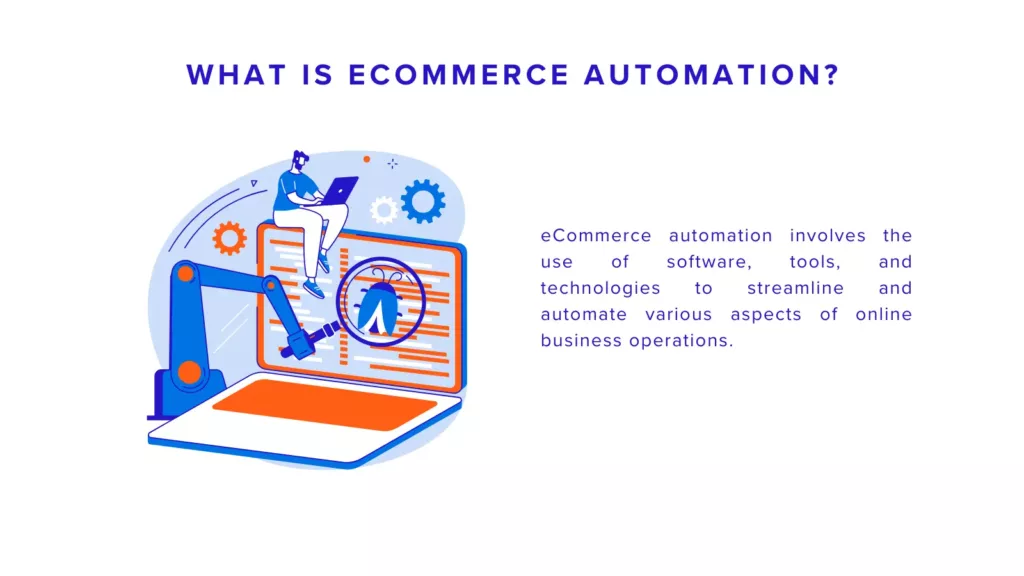
At its core, eCommerce automation involves the use of software, tools, and technologies to streamline and automate various aspects of online business operations. This includes a wide range of tasks, from inventory management and order processing to marketing campaigns and customer service.
Essentially, eCommerce automation aims to reduce the need for manual intervention in repetitive and time-consuming processes, allowing you to operate more efficiently and effectively. By automating routine tasks, you can free up valuable time and resources, enabling them to focus on strategic initiatives, innovation, and providing exceptional customer experiences. Whether it’s automatically updating inventory levels, sending personalized marketing emails, or providing instant customer support through chatbots, eCommerce automation empowers your team to work smarter, not harder, in today’s digital marketplace.
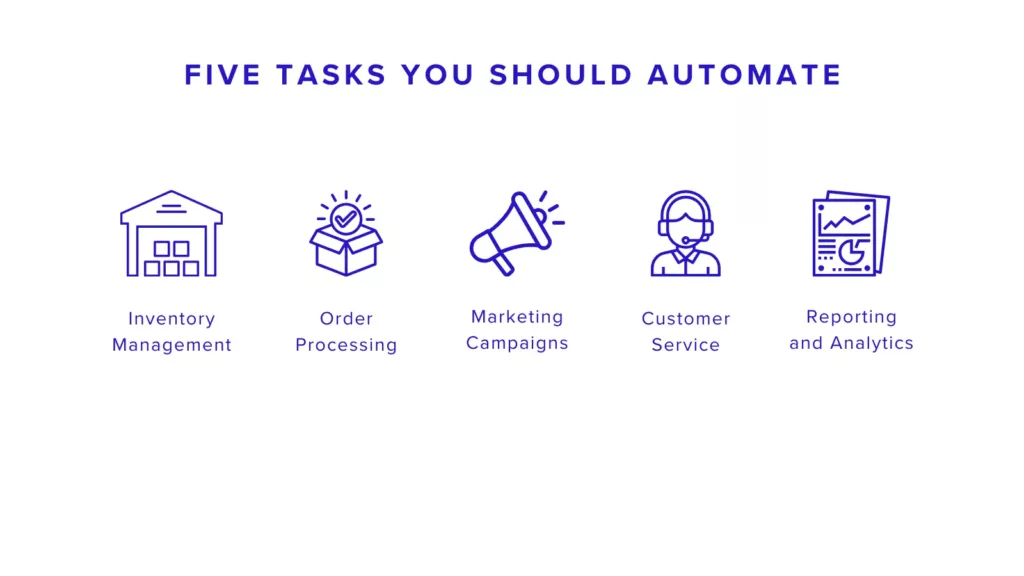
There are numerous tasks ripe for automation, but here are five crucial ones: inventory management, order processing, marketing campaigns, customer service, and reporting/analytics.
Imagine you run an online store selling various products. Keeping track of inventory levels manually can be time-consuming and prone to errors. With automation, you can set up systems that automatically update your stock levels whenever a purchase is made or new stock arrives. Additionally, you can configure alerts to notify you when certain items are running low, prompting you to reorder them before they run out.
When a customer places an order on your website, there are several steps involved in processing and fulfilling that order. Automation can streamline this process by automatically routing orders to the appropriate fulfillment center or warehouse. It can also generate packing slips and shipping labels, ensuring that orders are processed quickly and accurately. With automated order tracking, both you and your customers can easily monitor the status of their orders from placement to delivery.
Marketing is essential for promoting your products and attracting customers to your online store. Automation can help you save time and reach a larger audience by automating email marketing campaigns and social media posts. You can set up automated email sequences to welcome new subscribers, nurture leads, and recover abandoned carts. Similarly, you can schedule social media posts in advance, ensuring consistent engagement with your audience across different platforms.
Providing excellent customer service is crucial for building trust and loyalty with your customers. However, managing customer inquiries and support tickets manually can be overwhelming, especially as your business grows. Automation can help lighten the load by using chatbots and automated response systems to handle common inquiries and support requests. These systems can provide instant responses to frequently asked questions, route complex queries to human agents, and even offer 24/7 support, improving the overall customer experience.
To make informed decisions and track the performance of your online store, you need access to accurate data and analytics. Manually collecting and analyzing data from various sources can be time-consuming and prone to errors. Automation can simplify this process by automatically collecting data from your website, sales platforms, and marketing channels. It can then generate customized reports and dashboards, providing valuable insights into your sales performance, customer behavior, and marketing ROI. With automated reporting and analytics, you can make data-driven decisions to optimize your eCommerce operations and drive business growth.
By automating these five key tasks, you can streamline your eCommerce operations, improve efficiency, and focus your time and resources on growing your business and providing exceptional customer experiences.
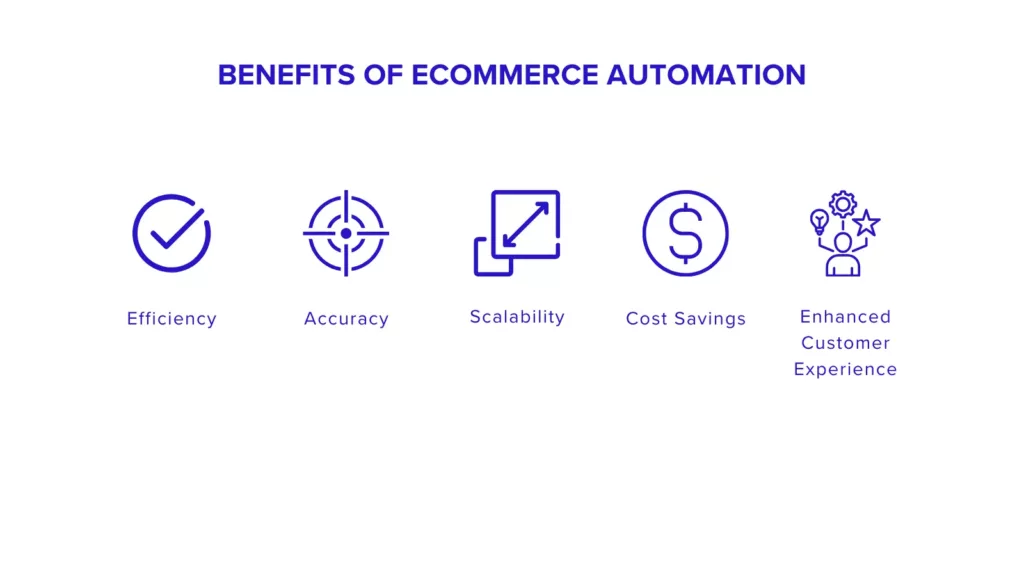
Adopting eCommerce automation can brings your business many benefits. Here are some of them
Automation streamlines your business processes by taking care of repetitive tasks, freeing up your time to focus on more strategic activities. Instead of manually updating inventory or processing orders, automation tools can handle these tasks quickly and efficiently, allowing you to operate more smoothly and effectively.
By reducing reliance on manual data entry and human intervention, eCommerce automation helps minimize the risk of errors. Whether it’s updating inventory levels or processing customer orders, automated systems can perform tasks with a high level of accuracy, ensuring that your business operations run smoothly and your customers receive the correct products on time.
As your eCommerce business grows, automation allows you to scale your operations without a proportional increase in workload. Whether you’re handling a handful of orders or thousands of transactions per day, automated systems can adapt to the increasing demands of your business, ensuring that you can meet customer needs efficiently and effectively.
While there may be initial investments required to implement automation tools and systems, the long-term cost savings can be significant. By streamlining your operations, reducing errors, and improving efficiency, eCommerce automation helps lower your overall operational costs, allowing you to allocate resources more effectively and invest in other areas of your business.
In today’s competitive eCommerce landscape, providing exceptional customer service is essential for building brand loyalty and driving repeat business. Automation plays a key role in enhancing the customer experience by providing quicker and more consistent service. Whether it’s responding to customer inquiries instantly with chatbots or delivering personalized marketing messages based on customer preferences, eCommerce automation helps create a seamless and enjoyable shopping experience for your customers, ultimately leading to higher satisfaction and loyalty.
By leveraging the benefits of eCommerce automation, you can streamline your operations, reduce costs, and deliver a superior customer experience, ultimately driving growth and success in the competitive online marketplace.
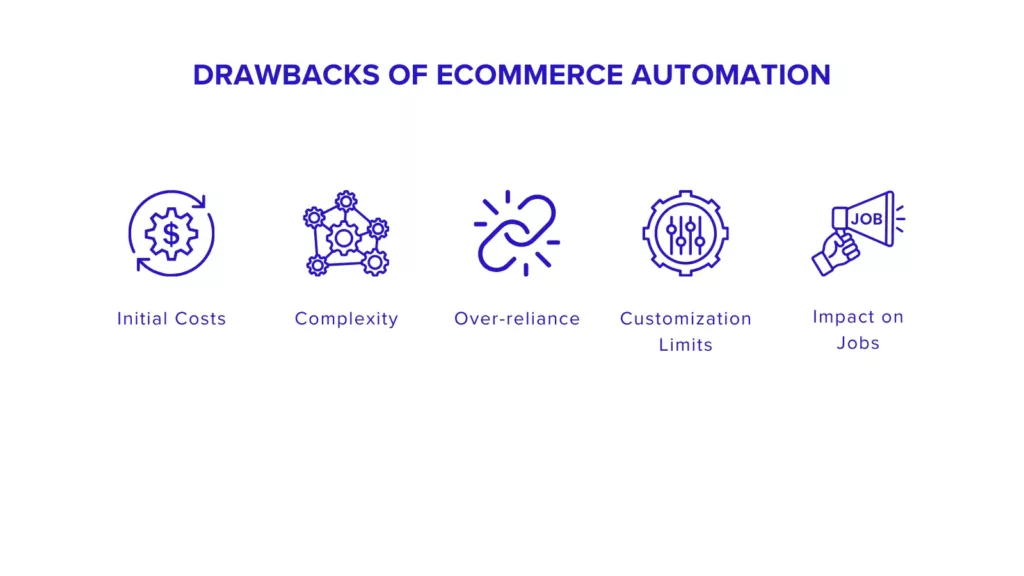
While eCommerce automation offers numerous benefits, there are also some drawbacks to consider.
Implementing eCommerce automation systems can incur significant upfront expenses. You may need to invest in software licenses, hardware infrastructure, and training for employees to effectively use these systems. For enterprises with limited financial resources, or don’t want to invest too much in this aspect, these initial costs can be a barrier to adoption.
Adopting eCommerce automation often involves navigating complex systems and technologies. You may encounter challenges in integrating automation tools with your existing workflows and processes. Additionally, employees may require time and training to familiarize themselves with the new systems, leading to potential productivity disruptions during the transition period.
While automation can enhance efficiency and streamline operations, your team risk becoming overly dependent on technology. Reliance on automated systems may leave you vulnerable to disruptions such as technical failures or system downtimes. Without proper contingency plans in place, these disruptions could significantly impact business operations and customer satisfaction.
Off-the-shelf automation solutions may not always fully align with the unique needs and requirements of every business. Customizing and tailoring automation tools to fit specific business processes can be challenging and time-consuming. You may find yourself constrained by the limitations of pre-built automation solutions, hindering your ability to fully optimize your eCommerce operations.
One of the most significant concerns surrounding eCommerce automation is its potential impact on employment. As your business automate repetitive and manual tasks, there is a risk of job displacement for workers whose roles are replaced by automated systems. This could lead to workforce reductions and require you to invest in reskilling and retraining programs for affected employees.
By understanding and addressing these drawbacks, you can make informed decisions about the extent to which you adopt eCommerce automation, mitigating potential challenges and maximizing the benefits of automation for your operations.
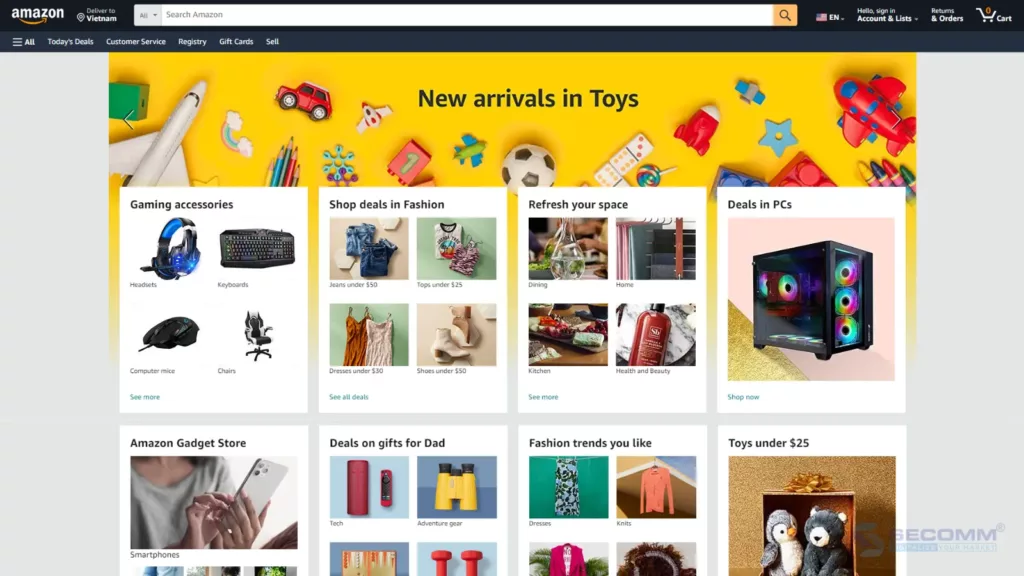
Background: Amazon, founded by Jeff Bezos in 1994, has evolved from an online bookstore to one of the world’s largest eCommerce platforms. With a vast array of products and a global customer base, Amazon’s success lies in its ability to innovate and optimize its operations continuously.
Automation Implemented: Amazon has heavily invested in automation across various aspects of its eCommerce operations.
Results: Amazon’s automation efforts have yielded several significant benefits:
Background: Sephora is a leading global beauty retailer known for its wide range of cosmetics, skincare, and fragrance products. With a strong presence both in physical stores and online, Sephora has built a reputation for offering high-quality products and exceptional customer service.
Automation Implemented: Sephora has leveraged automation to enhance its personalized marketing efforts, catering to the unique preferences of individual customers.
Results: Sephora’s automation efforts have yielded several positive outcomes:
Final Words
eCommerce automation offers significant benefits like increased efficiency and enhanced customer satisfaction, but it also poses challenges such as initial costs and job displacement. However, by carefully implementing automation tools and strategies, businesses can streamline operations and drive growth. Case studies of companies like Amazon and Sephora demonstrate the transformative impact of automation on eCommerce success.
Ready to take your eCommerce empire to the next level? Contact SECOMM today!
 2
2
 2,262
2,262
 0
0
 1
1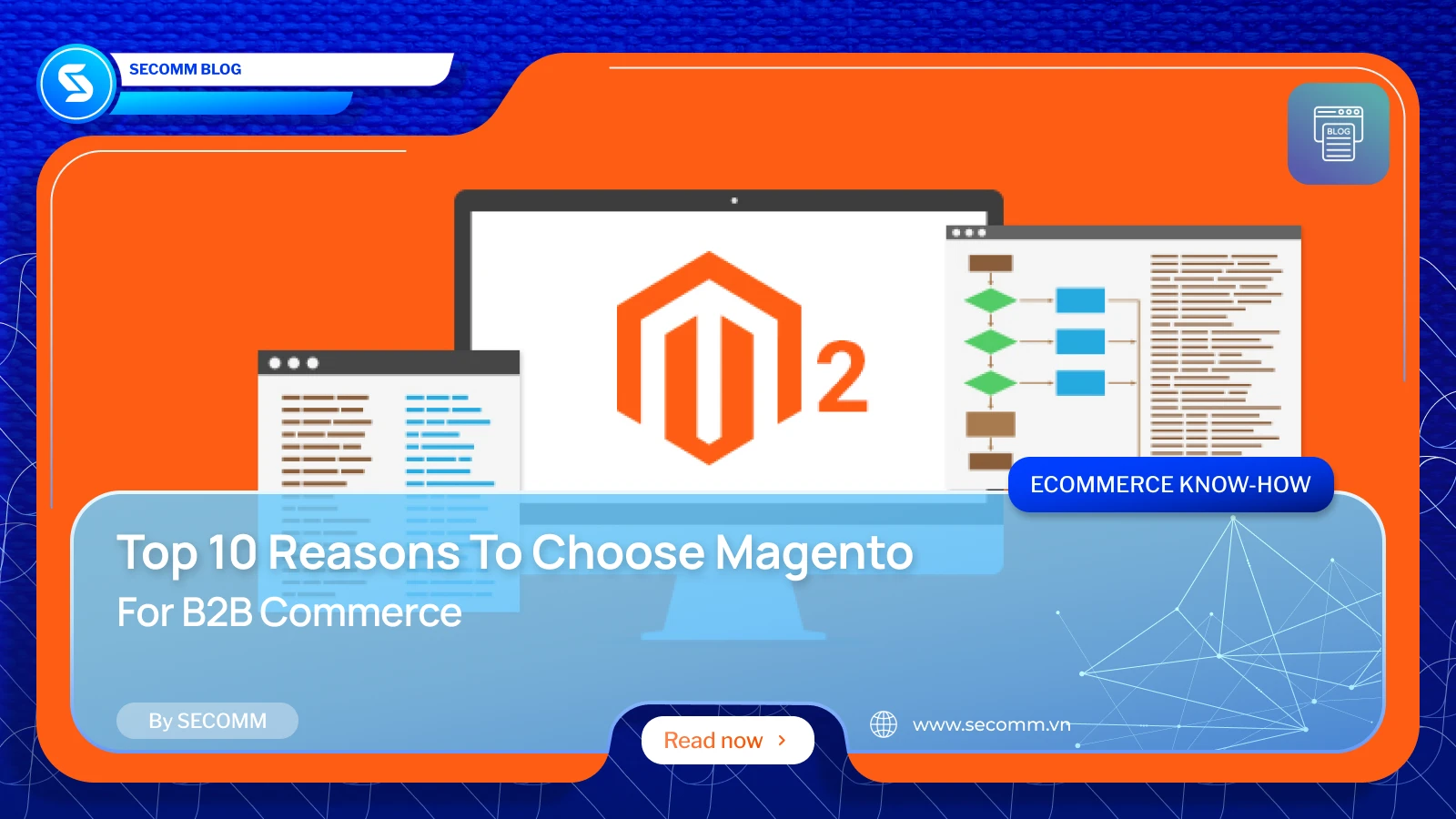
Over the past decade, Magento has solidified its position as one of the leading eCommerce platforms in the market. With its robust capabilities, the platform serves not only B2C businesses but is also a popular choice for enterprises.
By combining Magento’s strength with the specific requirements of B2B Commerce, you can leverage this platform’s powerful benefits. In the following part of the article, let’s explore 10 reasons why Magento is the ideal choice for deploying this great business model.
Business-to-business commerce (B2B Commerce) refers to the buying and selling of goods or services between businesses rather than between a business and end consumers (B2C). In the B2B environment, transactions often occur on a large scale and involve large orders, long-term contracts, and strategic partnerships.
This business model has distinct characteristics and requirements compared to B2C Commerce. In the B2B world, businesses typically have more complex demands regarding product management, order management, customer management, and compatibility with enterprise resource planning (ERP), customer relationship management (CRM), and other systems.
Additionally, the business model often requires features such as order confirmation, complex payment processes, batch ordering, and wholesale pricing. For B2B enterprises, choosing a suitable eCommerce platform is crucial to ensuring business efficiency and delivering the best user experience for their partners and customers.
Magento is a powerful and flexible eCommerce platform developed by Magento Inc., a subsidiary of Adobe. Launched in 2008, it quickly became one of the top choices for you looking to build and operate professional online stores.
It allows you to create custom eCommerce websites. This platform provides a range of features, including product management, order management, payment integration, customer management, and many others, enabling you to easily manage and operate your online stores efficiently.
It is built on open-source code, meaning that you can access and customize the platform’s source code based on specific technical requirements.
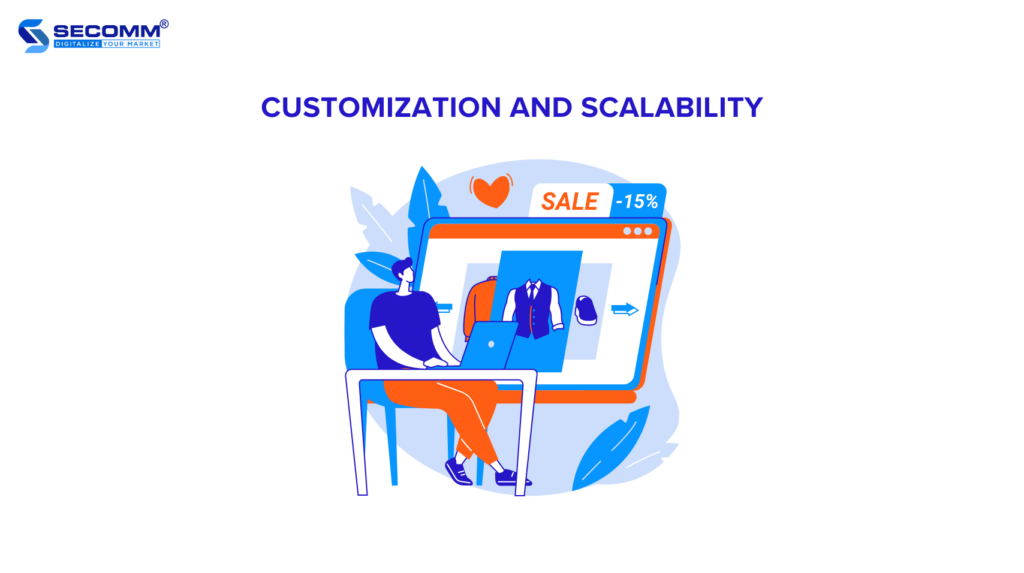
Magento’s open-source platform characteristic enables businesses to easily and effectively expand their business scale. This is particularly important as businesses grow and must enhance the system’s scalability.
Additionally, the platform provides high customization capabilities, allowing businesses to adjust to their specific business needs flexibly. This also means that the shopping experience can be customized to become unique and tailored to the target customers.
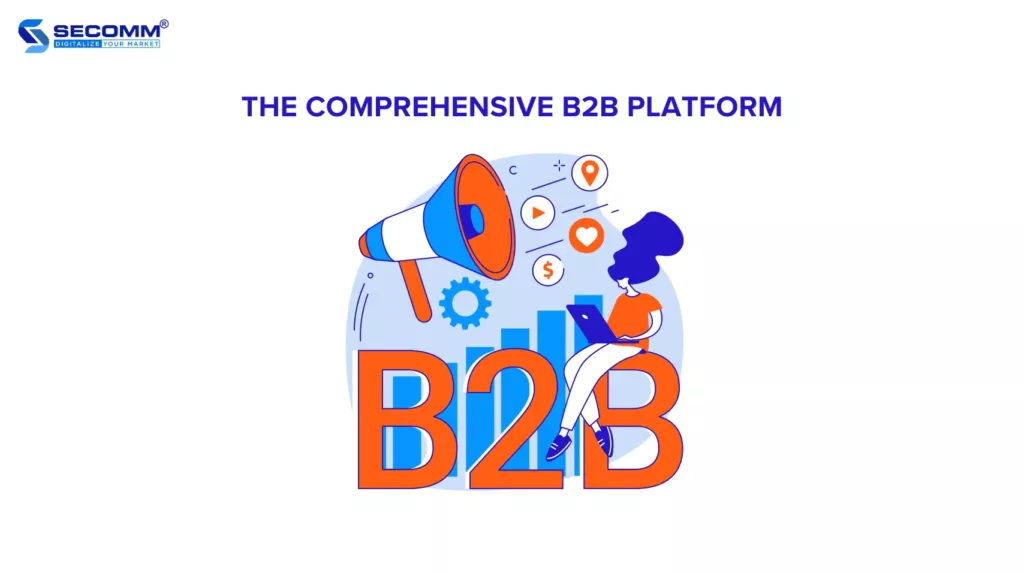
In addition to offering built-in Magento B2B features, the platform allows businesses to seamlessly and quickly integrate with many third-party applications and systems, thereby creating a comprehensive and automated eCommerce system. Some integrated systems may include:
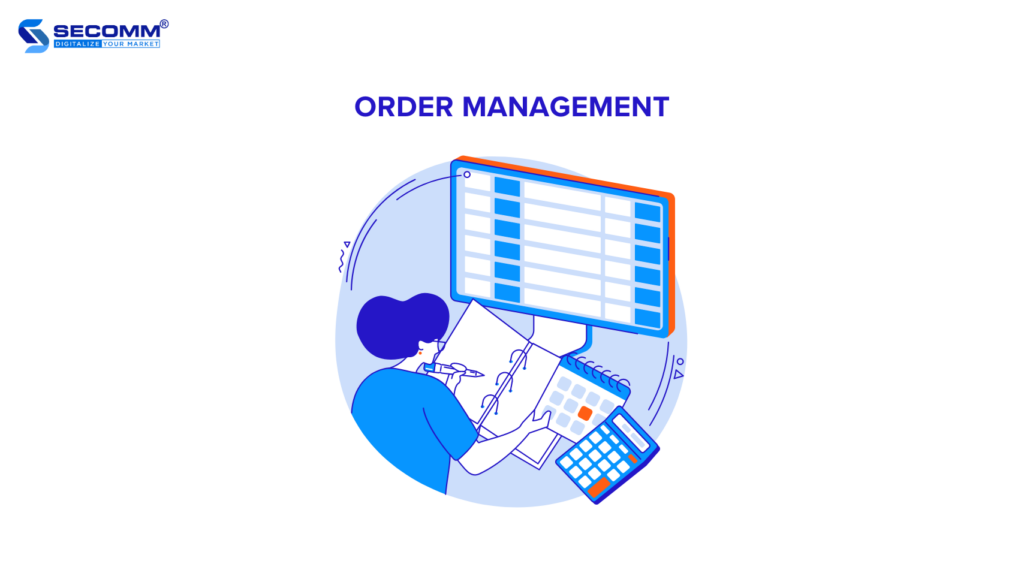
Magento B2B provides a variety of order management features, from creating and editing orders to tracking and processing orders efficiently. This helps B2B businesses easily monitor and manage their orders accurately and consistently.
Additionally, it offers tools and features that allow tracking and analysing their orders’ performance. From generating overview reports to tracking order history and purchasing trends, the eCommerce model deployed, you can better understand your activities and make informed strategic decisions.
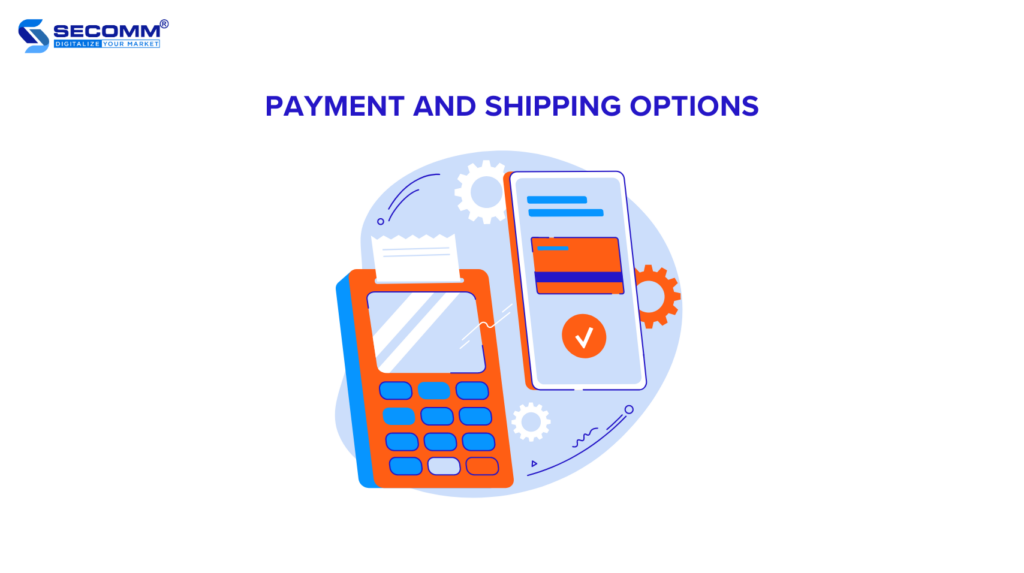
Implementing Magento B2B allows you to offer more payment methods to customers, from online payments through electronic payment gateways to cash on delivery (COD).
Additionally, you can integrate various payment gateways through Magento, such as PayPal, Stripe, Authorize.Net, and many more. This ensures security and convenience in the payment process for both businesses and customers.
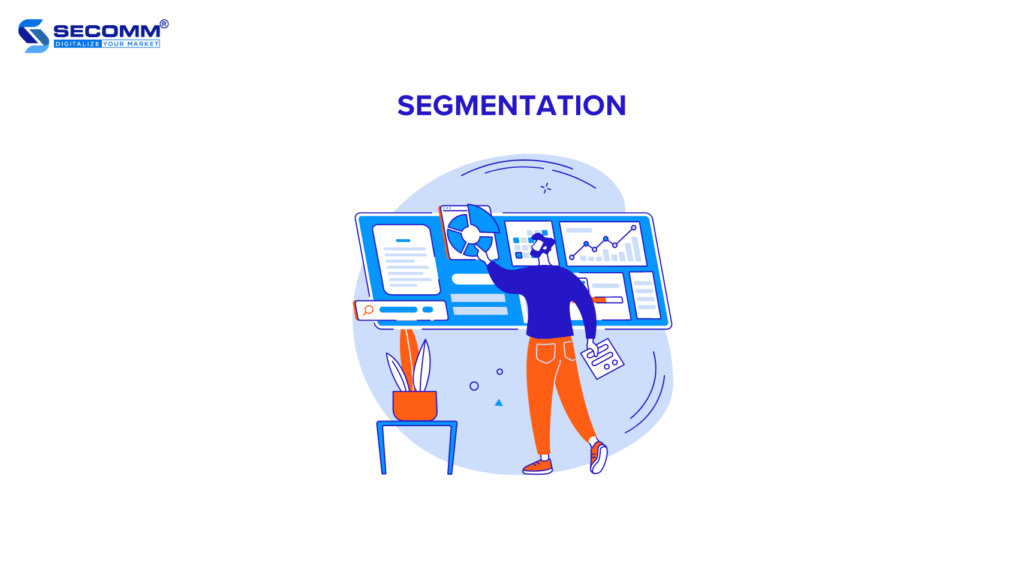
Magento B2B provides features and tools to implement customer segmentation strategies effectively. Among these, the most notable is the Advanced Reporting feature, which provides a dashboard for tracking and analyzing sales data.
With this feature, businesses can segment customers and customize experiences based on web browsing behavior, purchase history, and various other criteria.
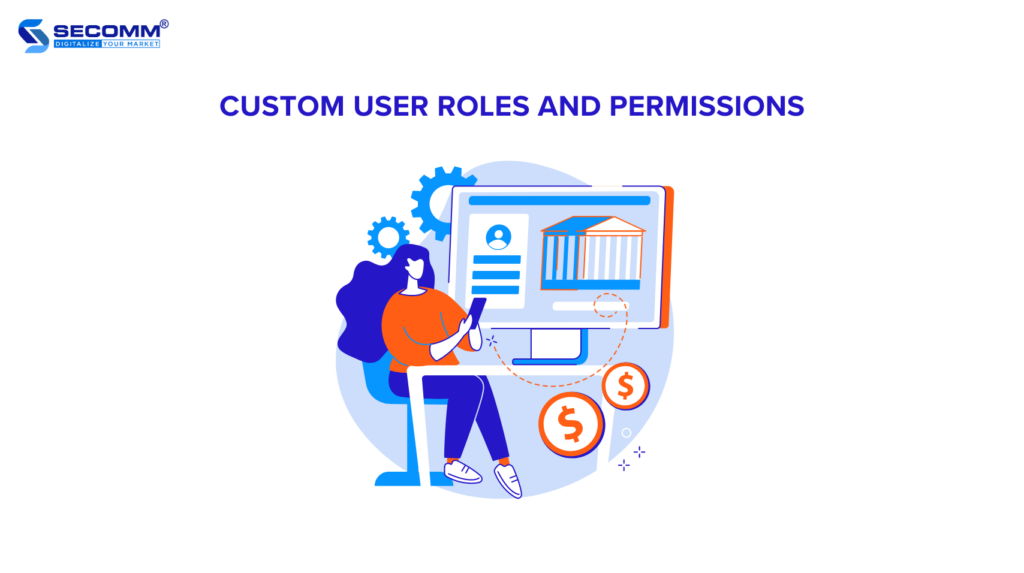
Customizing user roles and permissions is an important part of optimizing the B2B purchasing process. This feature allows B2B customers to create multiple accounts with different contact details for purchasing, ordering, quoting, negotiating, and payment. Additionally, Magento B2B allows sellers to create and assign admin accounts to manage specific customers.
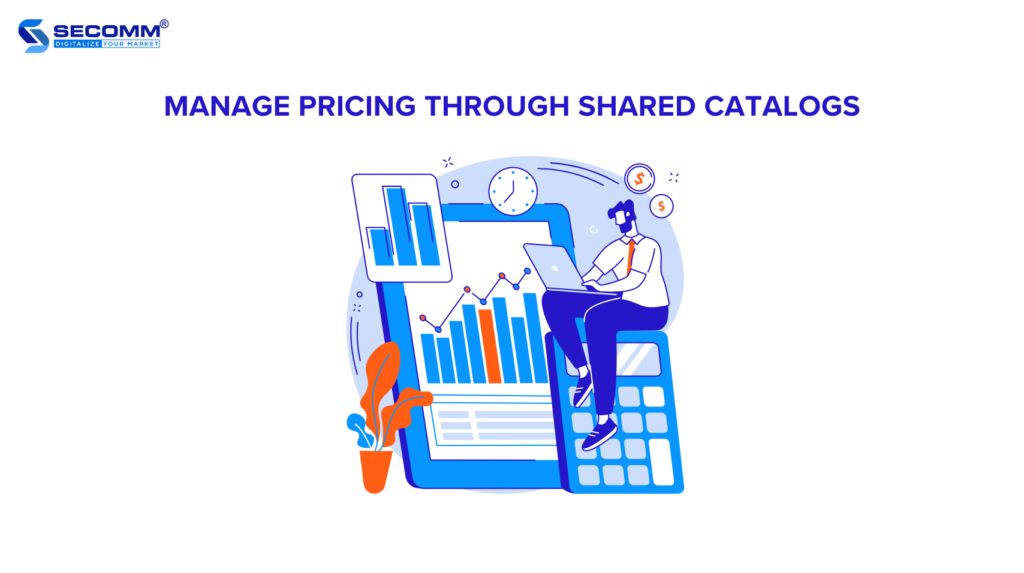
In B2B Commerce, Magento helps manage quotations through shared catalogs, which effectively provides product information and prices to B2B partners and customers. These catalogs can be created based on criteria such as product type, product group, or other suitable business needs.
Within each shared catalog, administrators can define prices and special conditions for each product or product group. This helps create customized quotations that meet the specific requirements of each customer.
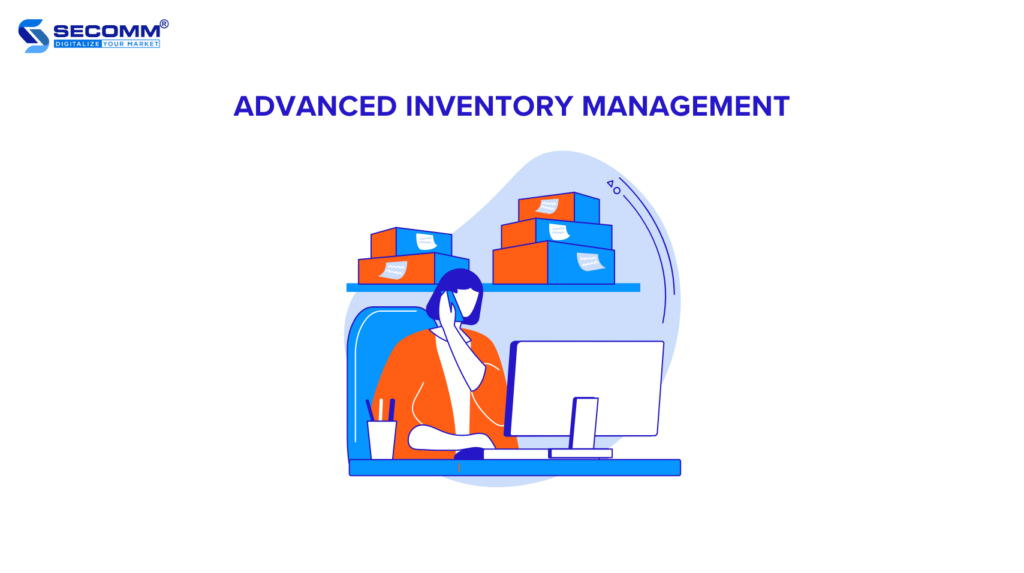
Inventory management is a challenging task for businesses implementing B2B Commerce. The eCommerce platform provides advanced features to effectively manage and control your inventory levels. These features allow administrators to track inventory quantities and forecast future inventory needs.
Additionally, Magento B2B helps manage special types of inventory such as damaged goods, special inventory items, or batch inventory.
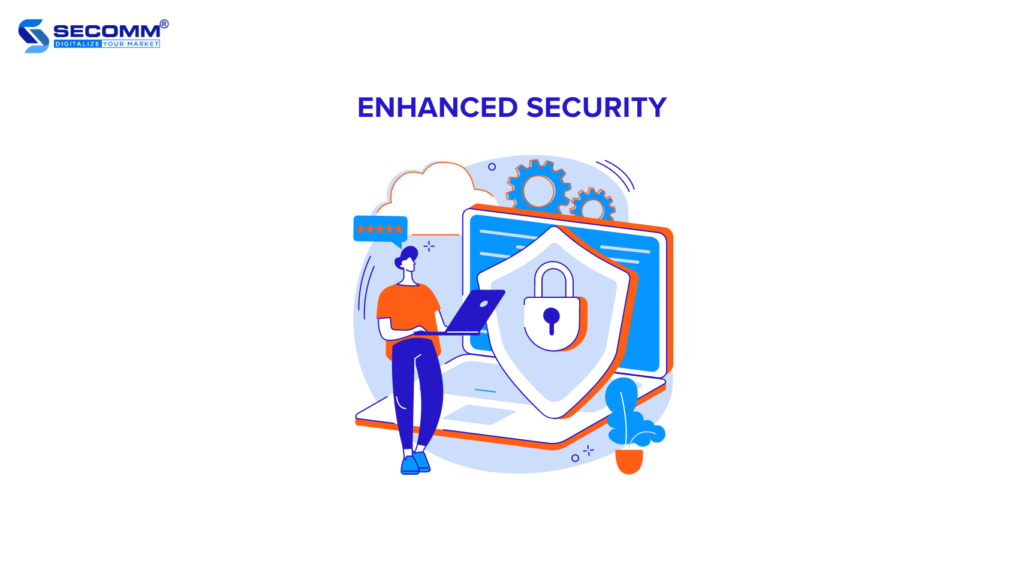
Security is an important issue when building and developing online stores in general. Magento provides many advanced features to help B2B businesses to secure their eCommerce systems. Among these, PCI Compliance, 2FA, WAF, DDoS protection, and preventing CSRF and XSS attacks are notable.
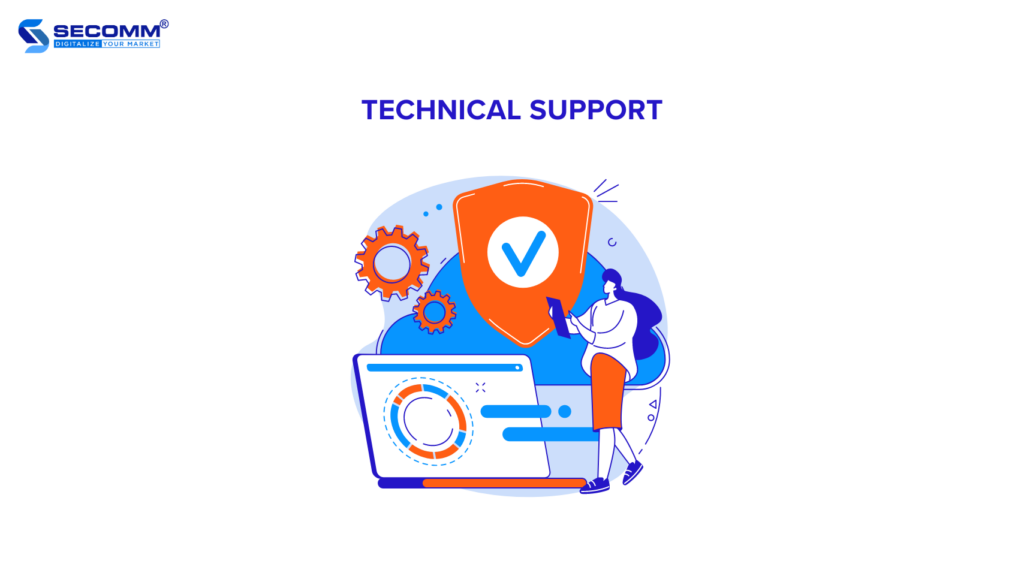
Technical support plays a crucial role in maintaining and operating an efficient online store. Magento B2B provides tools and support services to help users address technical issues and optimize the performance of their eCommerce websites.
This includes expert support via phone, email, or online. Additionally, Magento has a large and vibrant community of developers, experts, and end-users. You can search and ask questions on the forum to receive assistance from the community.
In the context of the increasingly developing and fiercely competitive eCommerce market, using a powerful eCommerce platform is extremely important to ensure the success. With its unique features and superior flexibility, Magento has proven to be a top choice for building and developing B2B stores.
Need more deep advice? Contact SECOMM or call (+84)28 7108 9908 now!
 2
2
 3,731
3,731
 0
0
 1
1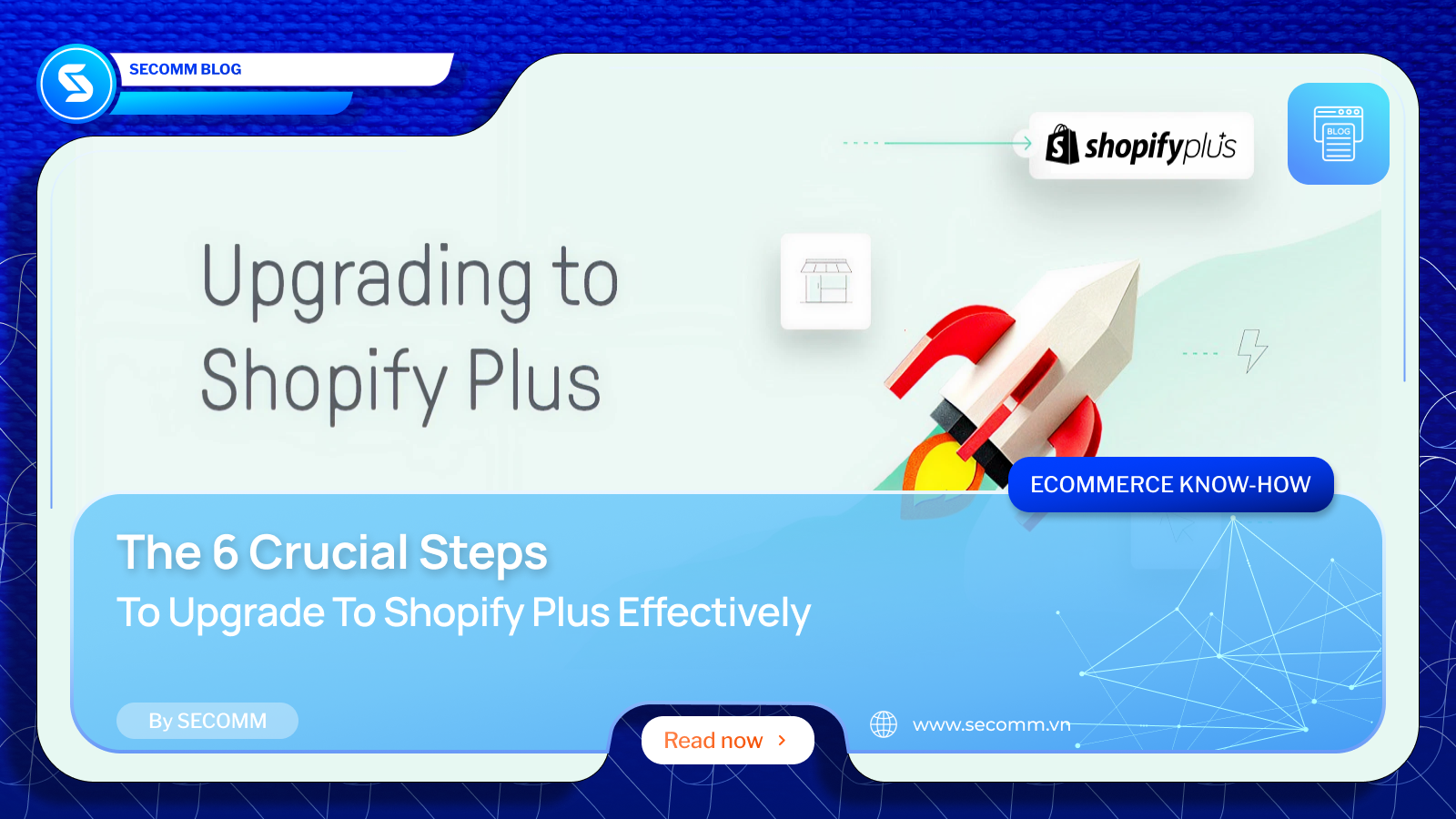
Upgrading to Shopify Plus is a strategic decision for growing ecommerce enterprises. Many merchants have encountered the challenges and opportunities this upgrade brings along their journey.
From optimizing business performance to expanding operations globally, upgrading to Shopify Plus isn’t just a technical step but also an opportunity to transform ecommerce activities into a springboard for market breakthroughs.
In this article, let’s explore the steps to upgrade to Shopify Plus and some critical considerations.
This is the premium version of the Shopify platform, specially designed to meet the needs of large and rapidly growing ecommerce businesses. With Shopify Plus, you can experience many powerful features and services that help optimize operations, expand scale, and enhance customer experiences.
One notable aspect of Shopify Plus is its flexibility and ease of customization. You can leverage features such as multi-store management, integration with ERP and CRM systems, creating multilingual and multi-channel websites, as well as adjusting interfaces and features according to your specific needs.
In particular, Shopify Plus provides a secure and easily scalable infrastructure that is capable of handling large volumes of traffic and online transactions robustly. With Plus, you can ensure that your website operates smoothly and seamlessly, even during peak shopping seasons.
Upgrading from the standard versions of the Shopify platform to the Plus version is a significant milestone in the transformation of ecommerce businesses. Below are eight benefits and also eight main reasons driving businesses to undergo the transition:

Shopify Plus offers a range of powerful features and tools to customize and expand ecommerce websites flexibly and efficiently. These include customizing checkout pages, personalizing customer experiences, and customizing product displays.
Additionally, you can utilize some exclusive solutions, such as LaunchPad, Shopify Scripts, and Shopify Functions, to customize shopping experiences and automate sales processes.
High traffic volumes will require a large amount of bandwidth to maintain a stable website. Shopify Plus allows you to access unlimited bandwidth, 200TB of storage, and unlimited staff accounts to handle large transaction volumes efficiently.
Upgrading to Shopify Plus can help optimize transaction costs. If you use Shopify Payments, transaction fees are the lowest in all Shopify pricing plans but will be customized based on geographical regions. Conversely, Plus merchants must pay 0.2% per transaction for security and compliance costs.
In the Plus version, you’ll be provided with tools and solutions to build a Headless ecommerce website. Through the Hydrogen + Oxygen solution, you can leverage the power of Headless architecture to create more customized and flexible customer experiences.
Shopify Plus provides features and tools to expand your B2B operations. The recent Shopify Editions Winter ’24 update introduced new features to optimize B2B Commerce activities.
From Headless B2B and advanced order management to integrated payment systems and unique features for B2B customers, Shopify Plus helps you streamline your operations and enhance customer relationships.
With Shopify Plus’s multilingual and multi-channel capabilities, you can efficiently expand your operations to international markets. Shopify Plus provides tools and features to customize websites according to each market’s needs, from handling currencies to managing orders and shipping.
The Plus merchants can utilize the exclusive POS Pro system for free. With advanced features, POS Pro allows seamless integration of multi-channel sales operations into the website, enables unlimited staff account access, and provides professional retail reports. This helps enhance customers’ shopping experience and optimize your offline and online sales activities.
When upgrading, you can expect more in-depth customer support services, especially in terms of consultation and technical support by a team of experts. Through hotlines, emails, and live chat, you can access the 24/7 support team.
Additionally, to help clients better understand this platform, Shopify offers a free learning program called Shopify Plus Academy. There, you can access detailed tutorials on setting up stores, customizing store interfaces, and much more.
You currently on one of Shopify’s standard pricing plans may consider upgrading to Shopify Plus under the following circumstances:
Before deciding to upgrade to Shopify Plus, there are four important steps that businesses need to take to ensure a smooth and effective upgrade process:
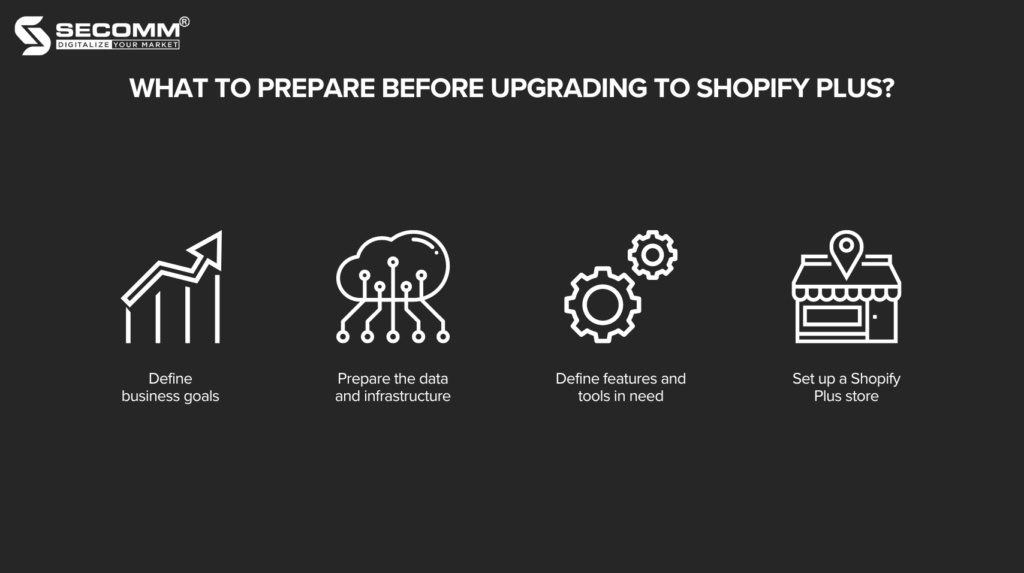
Firstly, you have to clarify your needs and wants. This includes evaluating the current and future growth of the business, as well as the necessary features to meet specific needs.
Next, you’ll need to prepare data and technical infrastructure for the transition process. This may involve backing up current data, checking the compatibility of current applications and features, as well as ensuring that the technical infrastructure is robust enough to satisfy your requirements.
Finally, you’ll identify the specific features and services you desire from Plus. This may include considering features such as multi-store management, integration with ERP and CRM systems, multi-language and multi-currency support, as well as special features like deploying Headless Commerce and accessing POS Pro systems.
Setting up a Plus store will differ from deploying previous standard pricing plans. Plus usage fees start from $2,300 per month, and this price isn’t fixed but customized based on each case’s specific needs. Therefore, you’ll need to contact the Shopify Plus team for advice. When collaborating with a Shopify Plus agency, the developer will work with the platform to provide a specific pricing quote.
Below are six specific steps for the entire process of upgrading your ecommerce website system from a lower version to Shopify Plus:
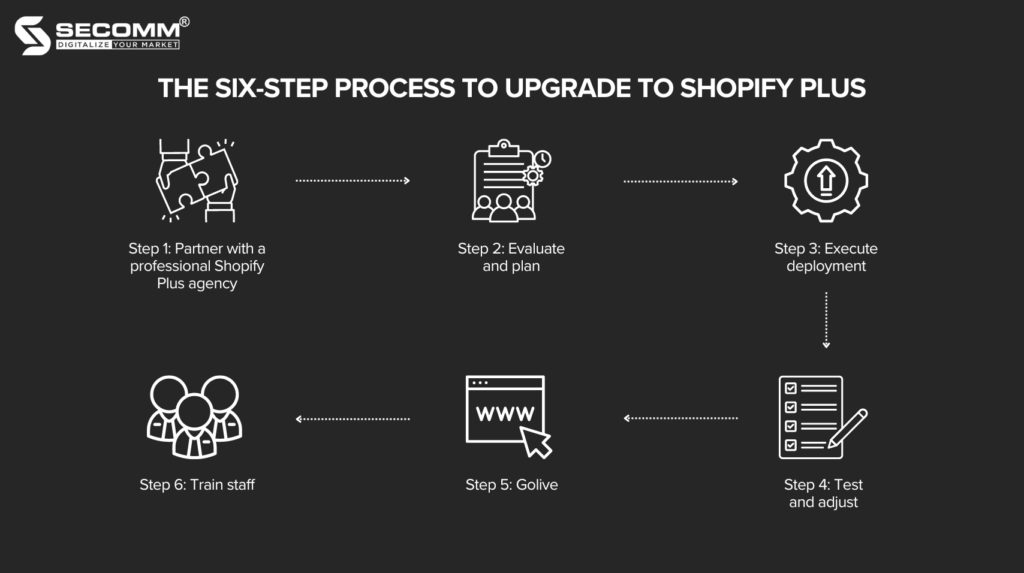
The first and most important step is collaborating with experienced teams specialising in Shopify Plus to optimize the upgrade process and post-operation, especially concerning costs.
To select a suitable Shopify Plus development partner, you should consider previous Shopify Plus projects they have completed, how they identify and solve problems in each project, and feedback from previous clients regarding those projects.
The next step is equally important as it determines the effectiveness of the conversion and future operations. You and your development partners need to clarify business goals, identify necessary features and data to be transferred, and develop a specific deployment schedule based on these goals.
You’ll also need to ensure data backup and updates are safely conducted to avoid data loss during the conversion process.
After assessment and planning, proceed with upgrading to Shopify Plus. The development partner will set up and configure new features, migrate data from the old platform to the new one, and test compatibility to ensure the website operates smoothly.
After deployment, test and adjust the Shopify Plus website to ensure all features and functions work correctly. The development partner’s QA/QC team will collaborate with you to check the quality of the website experience as actual end-users and correct any issues that arise.
Once testing is complete, the new ecommerce website will be launched into the market, and promotional campaigns will be deployed to attract initial traffic and orders.
Finally, employees should be trained to use and manage the new website on the Shopify Plus platform. You’ll provide detailed instructions on new features and how to use them to optimize the performance. Additionally, since Plus has unlimited staff accounts, personnel allocation should be reasonable and planned accordingly.
While upgrading to Shopify Plus can be complex, it significantly benefits business growth. From high flexibility and customization to scalability and deep customer service, Shopify Plus is the perfect choice for expansion.
Various insights and a systematic 6-step deployment process make the upgrade process more manageable. However, to increase efficiency and maintain the stability of the new website, businesses need a professional development partner to accompany them.
Contact SECOMM or call us at (+84)28 7108 9908 to plan your deployment today!
 2
2
 5,043
5,043
 0
0
 1
1
IT outsourcing in Australia is emerging as one of the most rapidly growing and attractive fields in the information technology market. As technology projects become increasingly complex and diverse, Australian businesses are increasingly serious about finding highly skilled outsourcing partners to address technical challenges and product development.
In this article, let’s explore the top 10 IT outsourcing firms in Australia, what makes them stand out in this field, and the key criteria for selecting a potential partner.
In recent years, the Australian IT outsourcing sector has undergone remarkable development, reflecting the boom of the information technology field in the country’s economy.
According to Statista, the projected market revenue for IT outsourcing in Australia in 2024 is expected to reach $14.49 billion, with a CAGR of 10.99% from 2024 to 2028. This indicates substantial prospects and expansion potential.
One crucial factor driving this growth is the emphasis on quality and efficiency. Australian IT outsourcing firms have heavily invested in workforce development and infrastructure to ensure they can deliver high-performance services and meet their clients’ increasingly complex technical requirements.
Furthermore, technological innovation has significantly contributed to this impressive growth. Adopting new technologies such as artificial intelligence, machine learning, and blockchain has opened up numerous opportunities for IT outsourcing firms to provide breakthrough and effective solutions for their clients.
When deciding on a partner to use IT outsourcing services in Australia, you must consider various criteria to ensure the partner can provide services that meet their needs. Below are four key criteria for choosing the right Australian IT service provider.
You need to ensure that the Australian IT company has experience and expertise in the field they are interested in. For example, shopping applications can be developed on the iOS operating system using the Kotlin language. The experience and deep knowledge of the IT outsourcing firms in a specific technology and industry will determine whether they are a potential partner.
This is the next important factor to consider. You need to check whether the IT outsourcing firm has high-quality standards and whether they have good experience in providing solutions and services to similar clients. Reviewing portfolios and engaging in direct consultations will help businesses evaluate more easily.
Social Proof is quite useful in this case. Before making a final decision, you can check reviews, feedback, and gather opinions from customers.
Finally, you need to consider the issue of pricing that the IT outsourcing firm offers, as well as the overall project costs for collaboration. Ensure that the price they offer is suitable for the business budget and that they can provide optimal solutions to meet the project’s requirements.
The companies listed below are all top names in the IT outsourcing field, with extensive experience and knowledge. They provide the highest-quality services and solutions to meet customers’ diverse needs in complex business environments.
Over the past ten years, SECOMM has become a leading provider of eCommerce solutions in Vietnam for its clients’ general and specific information technology projects. SECOMM is committed to providing clients with a team of skilled professionals capable of quickly adapting to the technological advancements of the era.

Seasia Infotech is a leading software development company in Australia. It provides custom software solutions and mobile application development. The company also offers IT outsourcing services, including developing a dedicated IT team for a specific project.
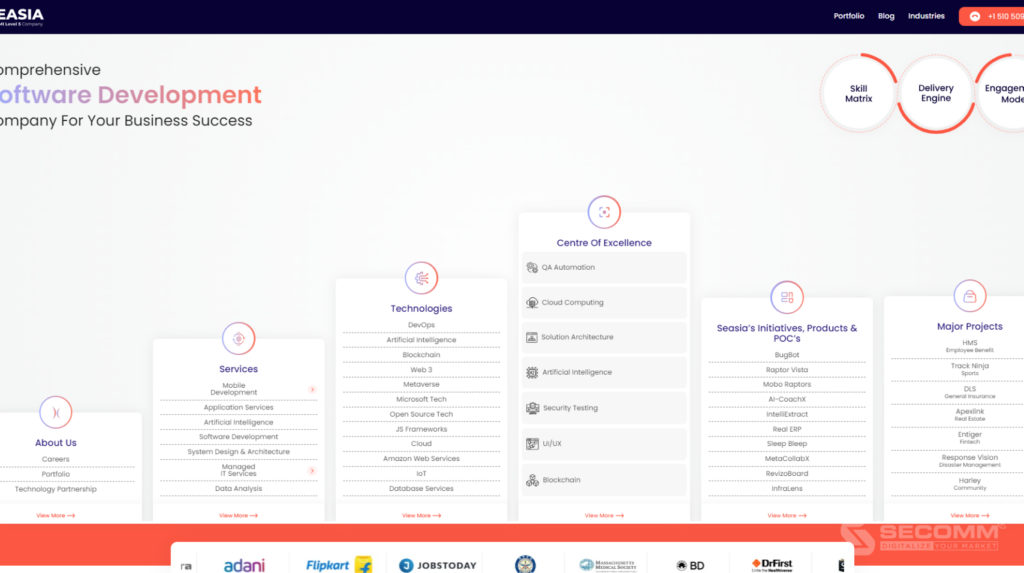
OpenXcell is one of the leading companies in the field of mobile application and software development in Australia. Its personnel and IT team are professional and outstanding. OpenXcell also ensures experience, skills, and knowledge to meet the specific requirements of the project.

Offshore Business Processing specialises in IT outsourcing services, including data processing, digitalization, and human resource management. Over the years in the market, the company has become a reliable partner of many leading businesses in Australia
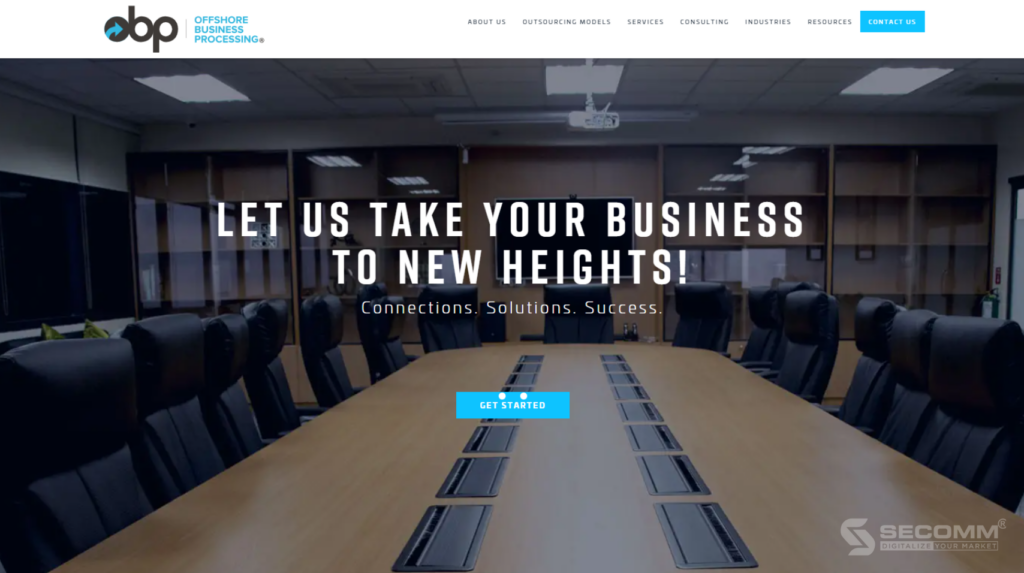
KMS Solutions is a well-known name in the Australian IT outsourcing industry. This company offers various information technology services, from software development to IT infrastructure management.
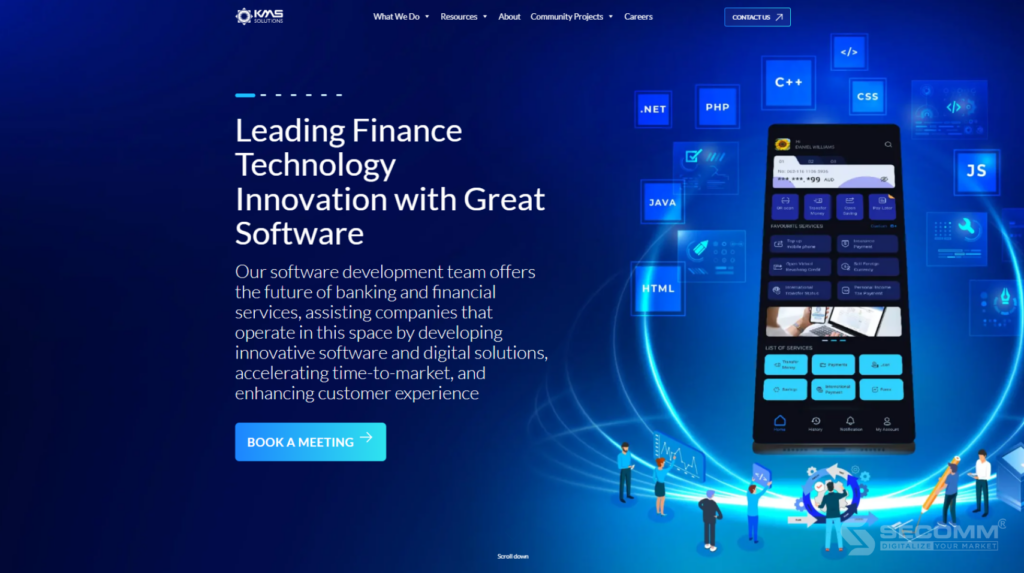
Ontik Technology is a pioneering company providing information technology solutions and custom software for Australian businesses. As IT outsourcing is becoming increasingly popular in Australia and Asian countries, Ontik Technology expands its services with a high-quality team of professionals.
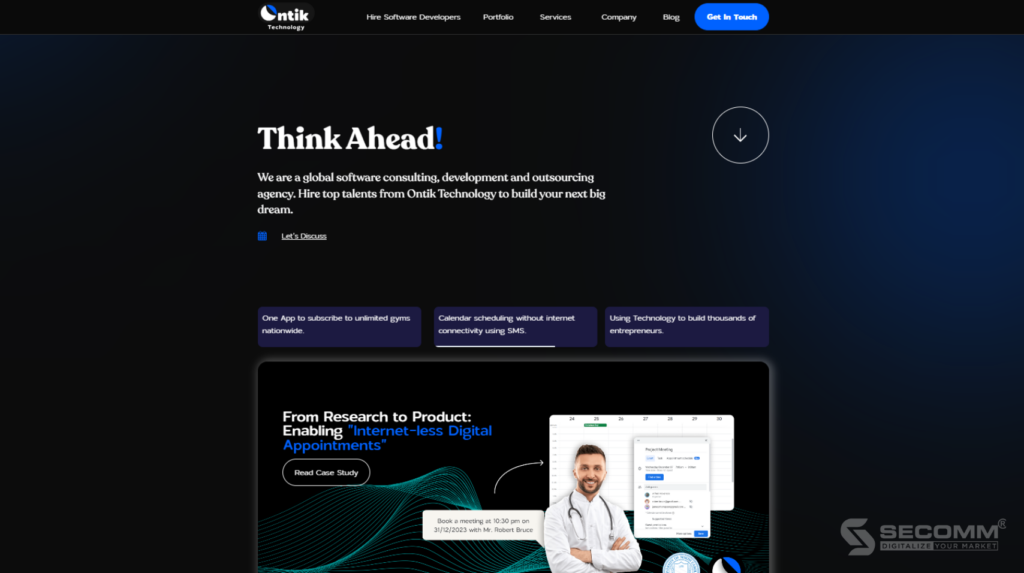
In addition to providing professional IT outsourcing teams, AIS Technolabs also offers Australian businesses custom software solutions, mobile applications, and web development services.
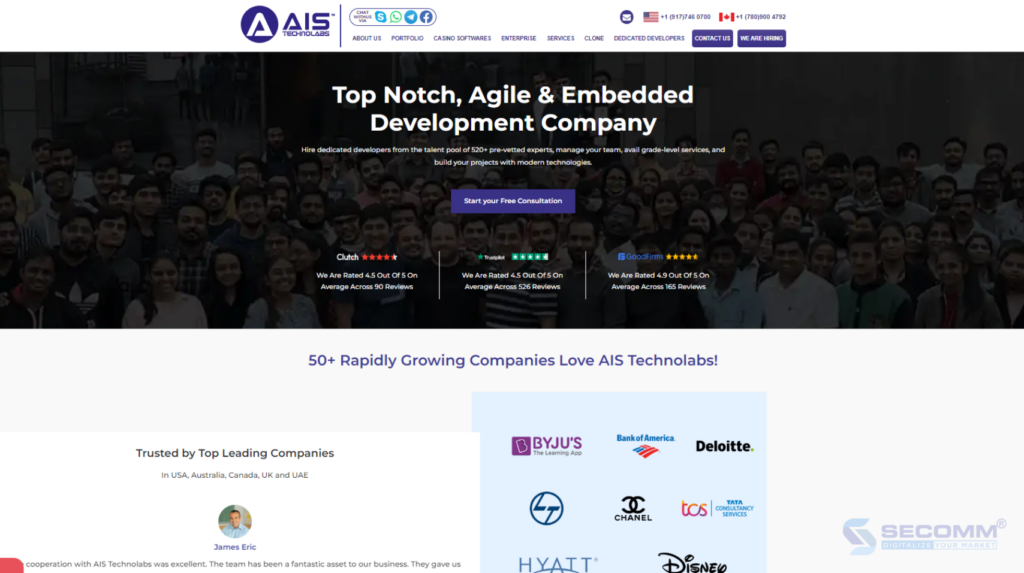
pwrteams possesses a highly skilled IT team in various aspects such as app development, software, website building, SaaS application deployment, QA, and Testing. With reasonable pricing, pwrteams has assisted Australian businesses with over 200 professional IT teams for many years.
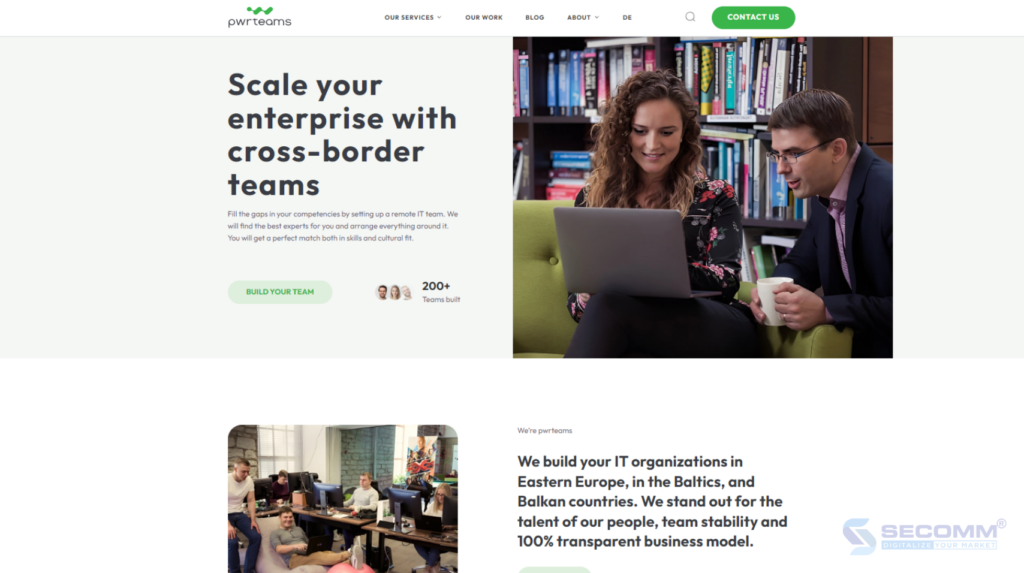
Intogreat Solutions is a renowned provider of IT consulting services and software outsourcing in Australia. Additionally, you can seek professional IT outsourcing solutions at Intogreat Solutions.
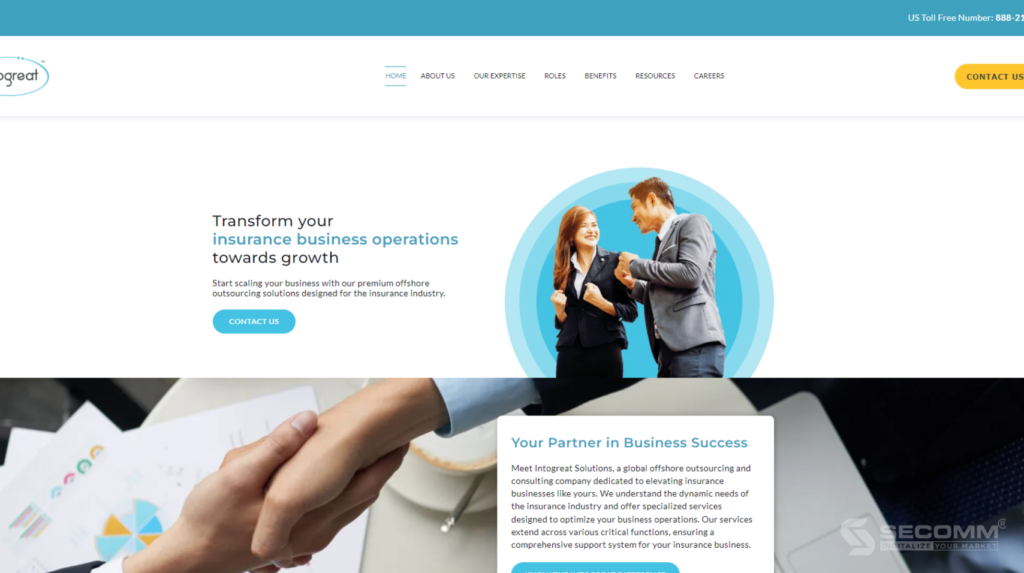
Similar to its brand name, this company provides outsourcing services for all IT-related services. All IT Services has offered reasonable and customized pricing based on the project scale and specific needs of businesses.
In an increasingly competitive and evolving information technology market like Australia, choosing the right IT outsourcing partner is key to achieving success and sustainable development for businesses. The above list has provided a diverse set of reputable and reliable partners, from software development companies to security services and IT infrastructure management providers.
Need advice or help building a professional IT team? Contact SECOM or call (+84)28 7108 9908 now!
 3
3
 3,874
3,874
 4
4
 3
3
Business-to-business (B2B) eCommerce is becoming increasingly important in the modern business world. In this arena, businesses interact and conduct transactions with each other through eCommerce platforms.
When it comes to this field’s growth potential, Bobby Morrison, Shopify’s Chief Revenue Officer, confidently asserts that B2B eCommerce will be the next significant opportunity for businesses of all scales in 2024 and the years that follow.
Read more: What’s new Shopify Editions Winter ’24?
Business-to-business (B2B) eCommerce is a form of commercial transactions between businesses through eCommerce platforms. In this model, businesses don’t focus on selling directly to end consumers (as in B2C commerce); instead, they prioritize creating value for fellow business partners.
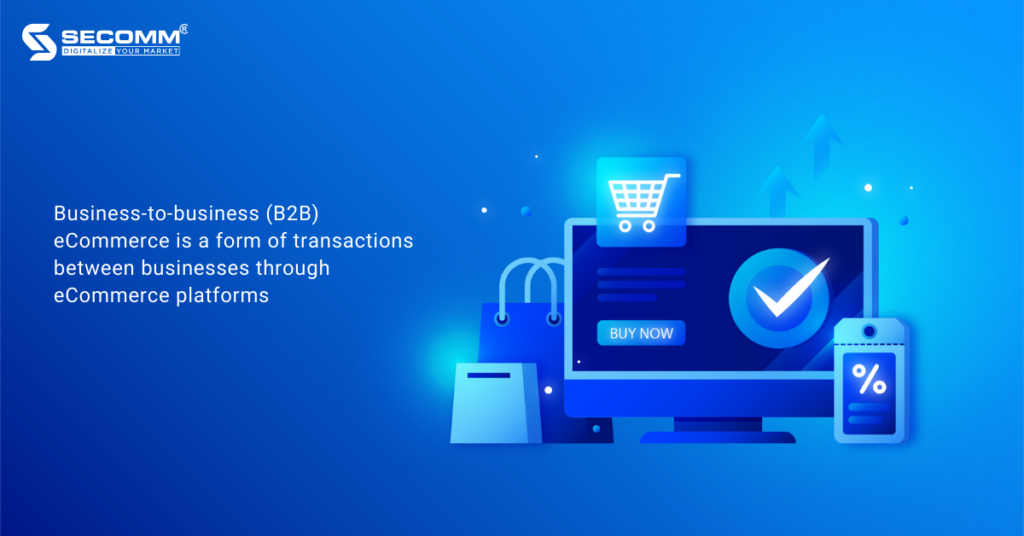
B2B eCommerce transactions may involve the exchange of goods and services, the sharing of information, and collaboration on big projects. Such interactions commonly occur between businesses operating within the same industry or along the same supply chain.
In the realm of B2B eCommerce, these transactions often have prominent scales, and high values, and are typically carried out through reliable online transaction management systems, databases, and platforms.
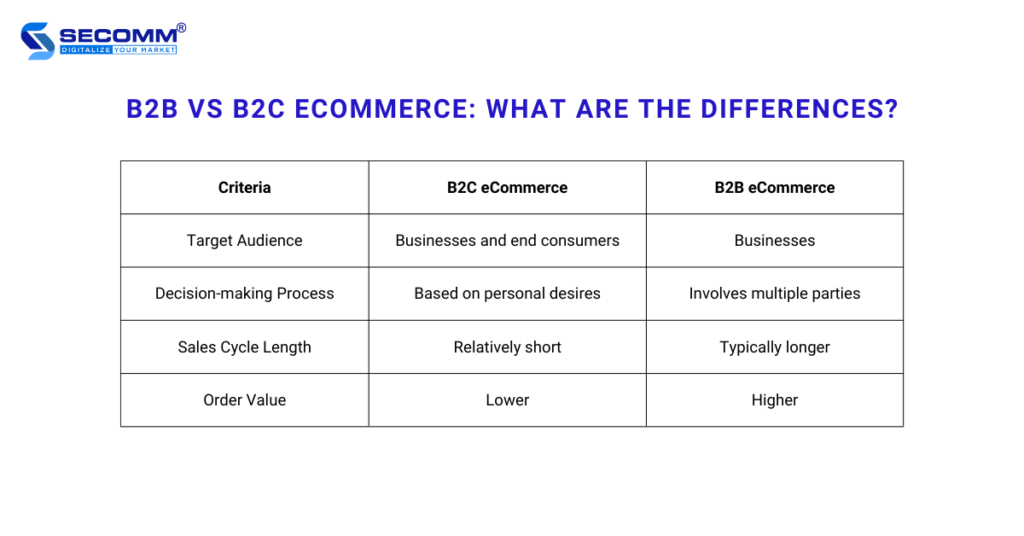
In B2B eCommerce, businesses often use several common models to interact and conduct transactions. Here are four main models:
B2B eCommerce is rapidly developing, and various online platforms are emerging to help brands implement this business model efficiently. Here are three popular platforms that B2B brands commonly use to build eCommerce websites. Each brand will choose the most suitable depending on the scale, objectives, and budget.
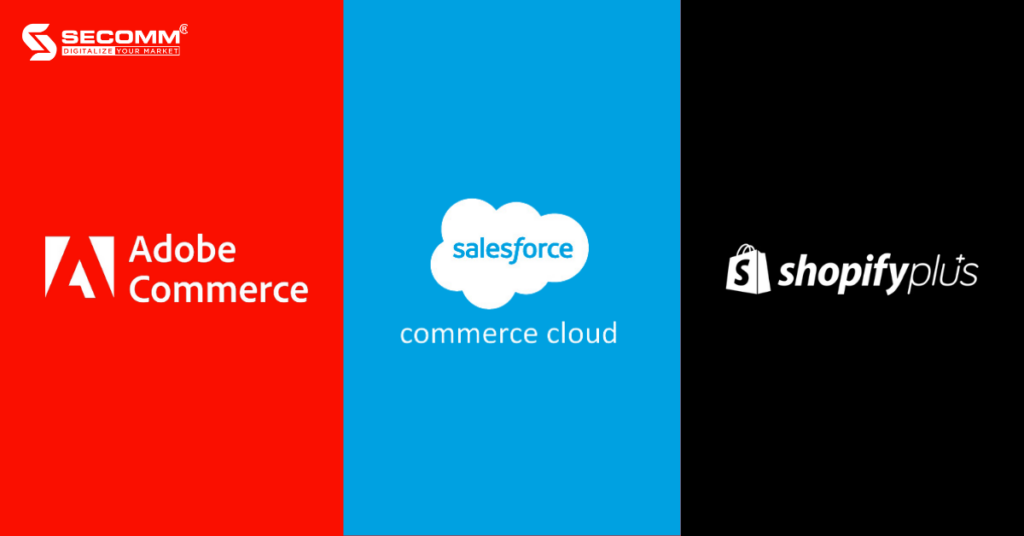
Pros:
Cons:
Pros:
Cons:
Pros:
Cons:
Read more: Top 5 B2B eCommerce platform
Booklinen is a trusted online marketplace specializing in premium bed linens. Established in 2014 with a focus on end consumers, the brand later diversified into the B2B sector as demand for larger-quantity orders grew.

Leveraging the B2B on Shopify solution, Booklinen created a visually appealing and user-friendly B2B eCommerce website, addressing the intricate needs of B2B sales operations. Furthermore, the brand can offer customers a personalized online shopping experience based on their buying behaviour, aiming to boost interaction and conversion rates.
Launched in 2015, Kulani Kinis aims to offer budget-friendly swimwear without compromising on superior quality and style. With a strong desire to expand wholesale operations like retail, Kulani Kinis has built an intuitive, user-friendly B2B eCommerce website similar to its retail site.

The B2B website enables wholesale customers to easily place orders from its extensive portfolio of over 800 products.
A notable feature is the custom collection page with a slider displaying the quantity available for all swimwear sizes. This allows customers to add multiple sizes and large quantities of products to their cart seamlessly, enabling them to enhance their shopping experience without leaving the collection page.
eJuices is a well-known brand in producing and supplying high-quality electronic liquids. The brand focuses on using safe and high-quality ingredients, ensuring that each eJuice bottle delivers excellent flavour and meets the highest safety and health standards in the vaping industry.
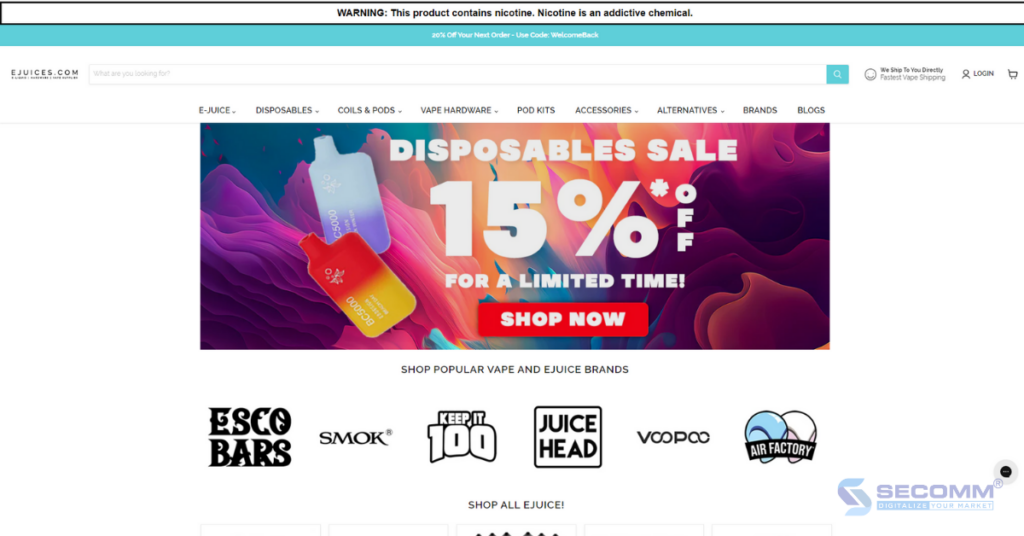
In addition to implementing a B2C model, eJuices is recognized as a genuine B2B eCommerce business. The brand has efficiently addressed inventory challenges, optimising its business operations while providing significant value to retail partners and enhancing collaborative relationships.
Build Your first b2b e-commerce website today!
Comprehending and effectively applying B2B eCommerce in your business strategy will undoubtedly open up promising new opportunities. B2B eCommerce is the key to unlocking continuous possibilities in the rapidly changing world. It isn’t just a passing trend; it presents a significant opportunity for every business’s growth and development.
If your company is considering establishing an eCommerce website and refining strategies to serve B2B customers, contact SECOMM or call the hotline (+84)28 7108 9908 today. Together, we can shape your business’s effective and sustainable future.
 2
2
 3,338
3,338
 0
0
 1
1
Fashion eCommerce has been booming worldwide for many years, and Australia is no exception. According to IBISWorld, the online revenue for women’s fashion alone in the Kangaroo country reached over $1.8 billion in 2023, marking a 1.1% increase compared to the same period in 2022.
Let’s explore the top 10 most prominent fashion eCommerce websites in Australia.
For a considerable period, The ICONIC eCommerce website has been recognized as a premier shopping hub for fashion enthusiasts in Australia and New Zealand. On this platform, shoppers can conveniently discover various products from well-known global brands like Levi’s, Adidas, Lacoste, Polo Ralph Lauren, and others.
The ICONIC website is designed to make it easy for customers to navigate products, make purchases, and track their orders. Beyond delivering a distinctive online shopping experience, The ICONIC also regularly updates fashion trends and provides valuable information for its customers.
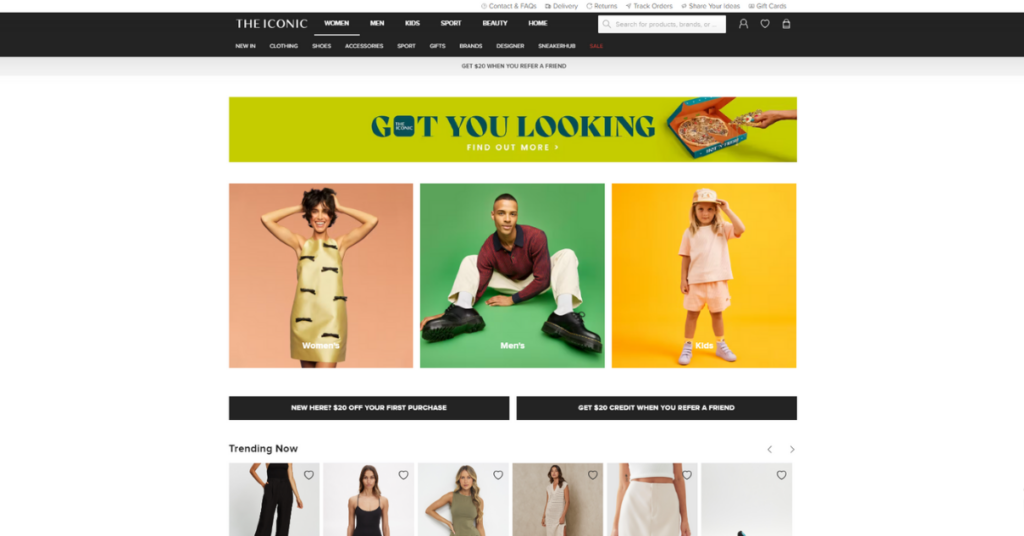
Established in 1991 in Australia, Cotton On offers a diverse range of fashion products for men, women, and children, including footwear, accessories, lingerie, and even home furnishings and interior decor in some stores. Cotton On has a widespread network of physical stores across the globe, including the UK, the US, and Canada.
Therefore, the brand has invested in an eCommerce website system to cater to various customer demographics in different markets. Additionally, Cotton On implements a customer loyalty program and various enticing promotional campaigns to attract and retain customers.

Established in 2006 in Australia, Forever New focuses on designing and producing women’s fashion collections, offering customers products with a luxurious and feminine style. Since then, the brand has rapidly grown and expanded into various markets.
The Forever New eCommerce website is built using Magento and customized with many advanced features to optimize the online shopping experience for customers. Similar to many other popular fashion retailers, Forever New implements various promotional programs and enticing offers to delight its customers.
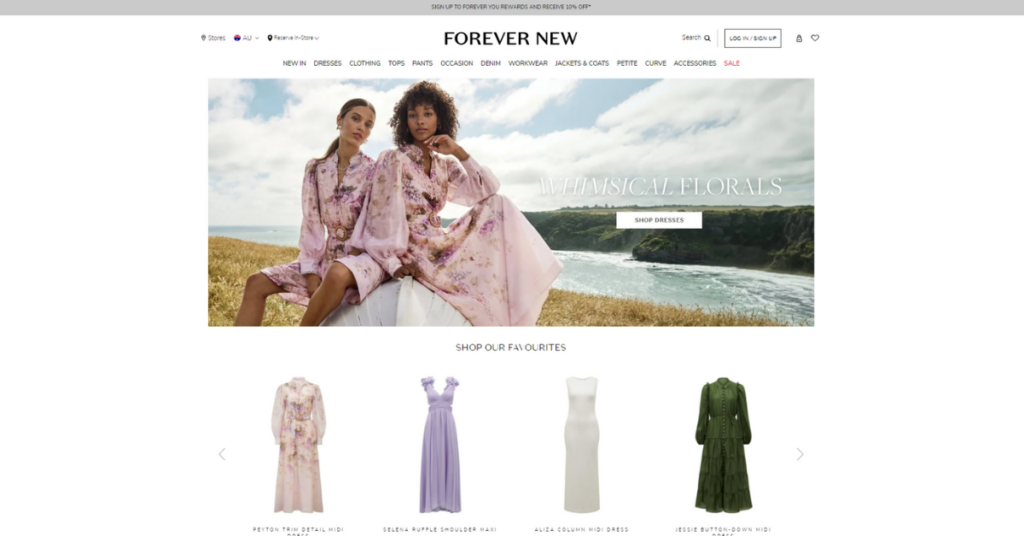
Bonds is a renowned fashion brand in the Australia and New Zealand region, offering a wide range of products for men, women, and children in diverse styles and sizes. The Bonds eCommerce website not only showcases the brand’s sophistication through a visually appealing user interface but also provides intelligent search features, secure payment processes, and detailed product information.
This approach helps Bonds retain its existing customer base while also capturing the interest of newcomers looking to experience the brand’s comfort and distinctive style.
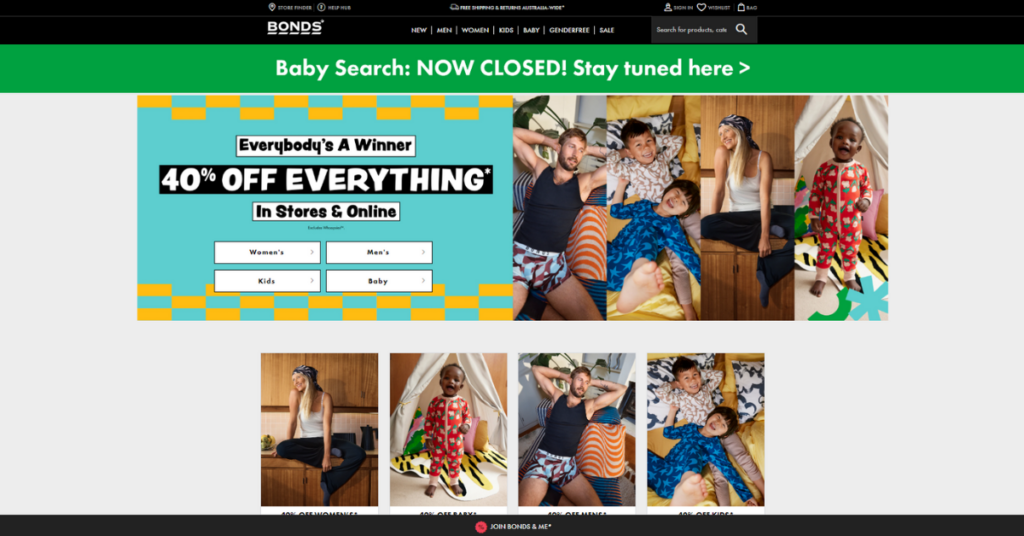
Present in the Australian market for over 80 years, Sussan has won the hearts of consumers through a blend of modern style and comfort. Today, Sussan stands as an icon in the country’s fashion industry with unique outfits that emphasize the creativity and confidence of women.
Sussan’s fashion eCommerce website is customized and optimized on the Magento platform, providing customers with a unique shopping experience. The website simplifies the checkout process and integrates multiple third-party payment methods to increase choices for customers while streamlining the shopping process and reducing cart abandonment rates.
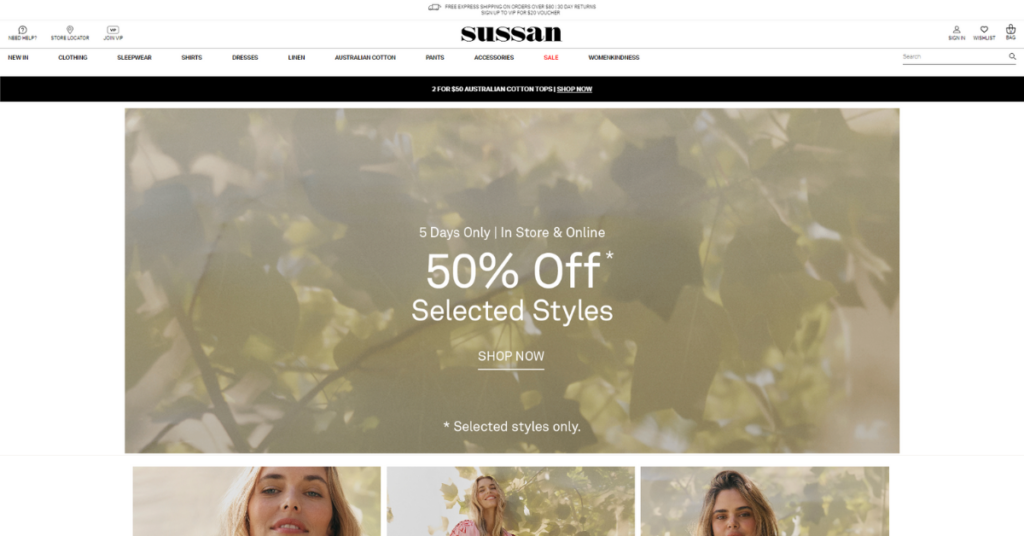
Kathmandu is known as a giant in the field of clothing and equipment for outdoor activities and adventure sports. This brand has played a significant role in making the outdoor life of Australians more exciting and comfortable.
The Kathmandu eCommerce website is developed using Magento, providing customers with a rich and easily customizable experience that can be expanded based on the business’s needs. Some notable features of the Kathmandu website include options for product sizes and colors, product comparisons, finding the nearest store, one-page checkout, and more.
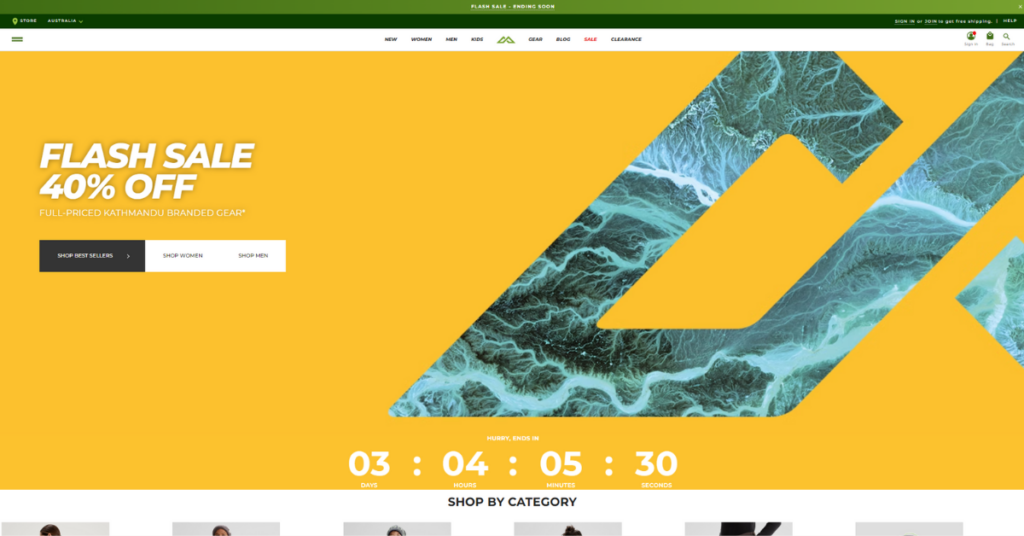
Established in 1990, Glue Store is a longstanding fashion chain in Australia. The brand specializes in offering products from top global brands such as Adidas, Nike, Stanley Tumblers, UGG, and various other streetwear labels.
In addition to its nationwide chain of stores in Australia and New Zealand, Glue Store provides customers with an online shopping experience through an eCommerce website built on Shopify. Glue Store has also developed a loyalty program allowing customers to accumulate points for purchases, redeemable for vouchers or gifts.
Additionally, customers can subscribe to Glue Store’s email newsletter for updates on the latest products and promotions. News and gifts will be tailored separately for male and female customers.

Sportsgirl is a fashion brand that emphasizes creativity and diversity in its collection of women’s fashion. With 70 years of history, Sportsgirl has become a popular shopping destination, inspiring individual style by combining the latest fashion trends with unique elements.
Sportsgirl has built an eCommerce website with Magento to provide an optimal customer experience, allowing for easy customization of features and system expansion to align with market development and trends. Additionally, Sportsgirl offers customers attractive deals, including discounts, buy one get one free promotion, free shipping, gift card giveaways, and a variety of payment methods.
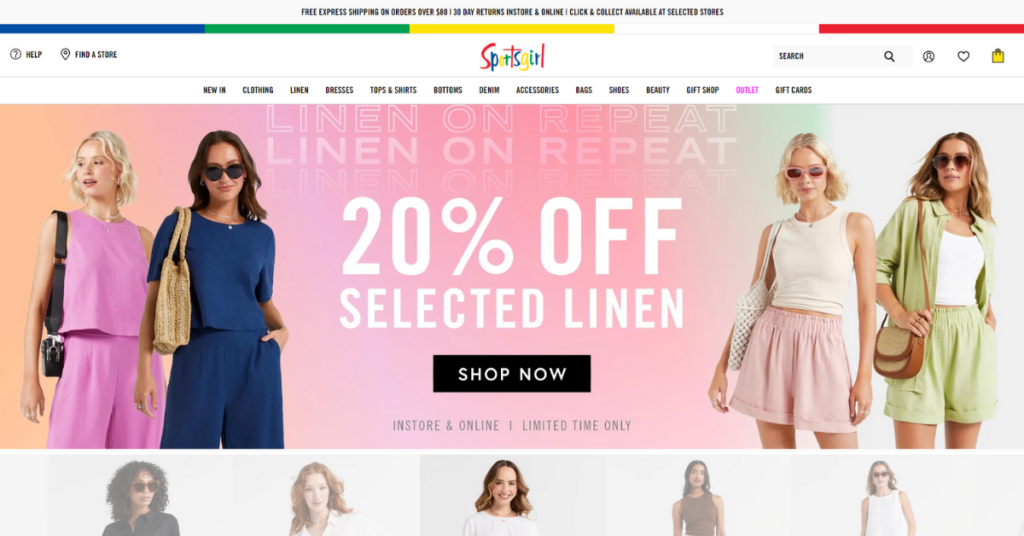
Styles Tread is a well-known shoe brand from Australia, specializing in providing products that offer comfort and premium style to consumers worldwide. Any pair of shoes in Styles Tread’s collection reflects sophistication in design and a commitment to providing a stylish and comfortable experience for the wearer.
The eCommerce fashion website of Style Tread focuses on minimalistic yet unique design elements to deliver the best customer experience, from browsing products to adding items to the cart and completing the payment process. Everything is streamlined to shorten the shopping time, encourage customers to make decisions quickly, and reduce the cart abandonment rate.
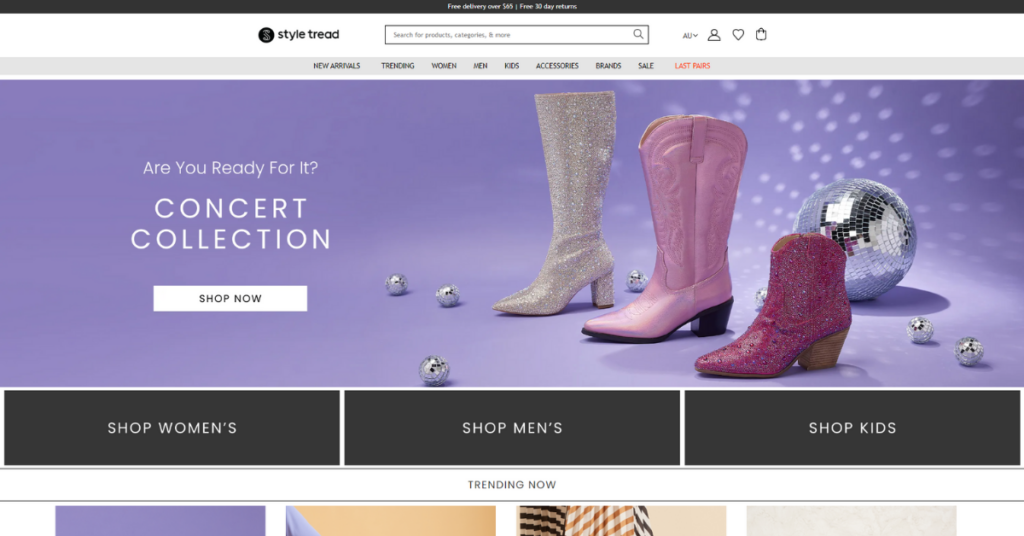
Pretty Little Thing is known as a famous Australian fashion brand specializing in creating trendy and modern outfits for young women. The combination of the latest fashion trends, product quality, and good value has helped Pretty Little Thing build a large fan base and maintain its position in the international fashion industry.
The eCommerce website of Pretty Little Thing uses a color palette of pink, white, and black with a design focus on minimalism and emphasis on user experience. Therefore, the brand deploys various unique features such as Smart Filtering & Searching, Image Search, Product Size Selection, Related Product Display, and Quick View Cart.
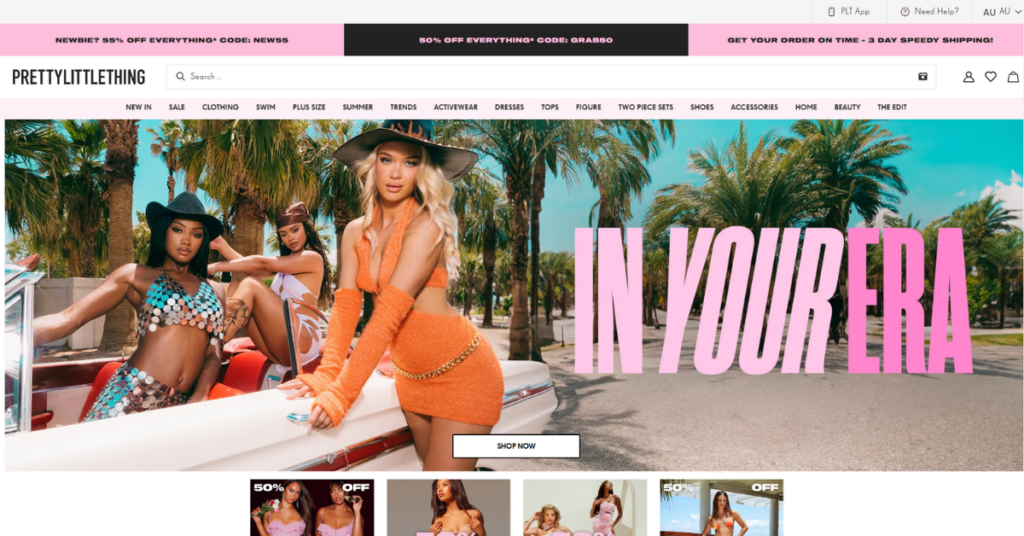
Here are the top 10 leading fashion eCommerce websites in Australia that have quickly adapted to the increasing demands in the consumer trend of online shopping.
With extensive experience in developing eCommerce websites for numerous Australian clients, SECOMM possesses a team of highly experienced experts with advanced technical skills and a profound understanding of the Australian eCommerce market.
Contact SECOMM or call the hotline (+84)28 7108 9908 for a detailed consultation!
 2
2
 4,771
4,771
 0
0
 1
1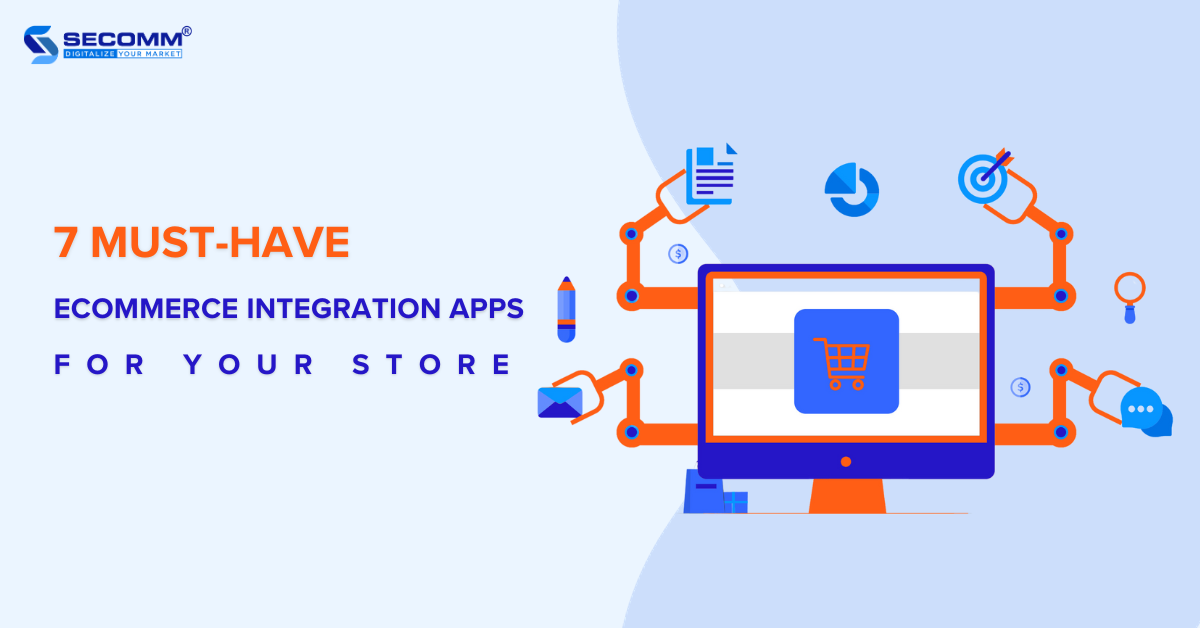
Several crucial factors impact the efficiency of running an online store. Among these, effectively implementing eCommerce integrations plays a key role in helping you streamline your operations and reduce risks.
Below are 7 essential integrations that you should include in your eCommerce website.
PIM (Product Information Management) is one of the common eCommerce integrations. The PIM system is used to collect, organize, and manage product information, including details such as product descriptions, images, prices, product attributes, customer reviews, and ratings.
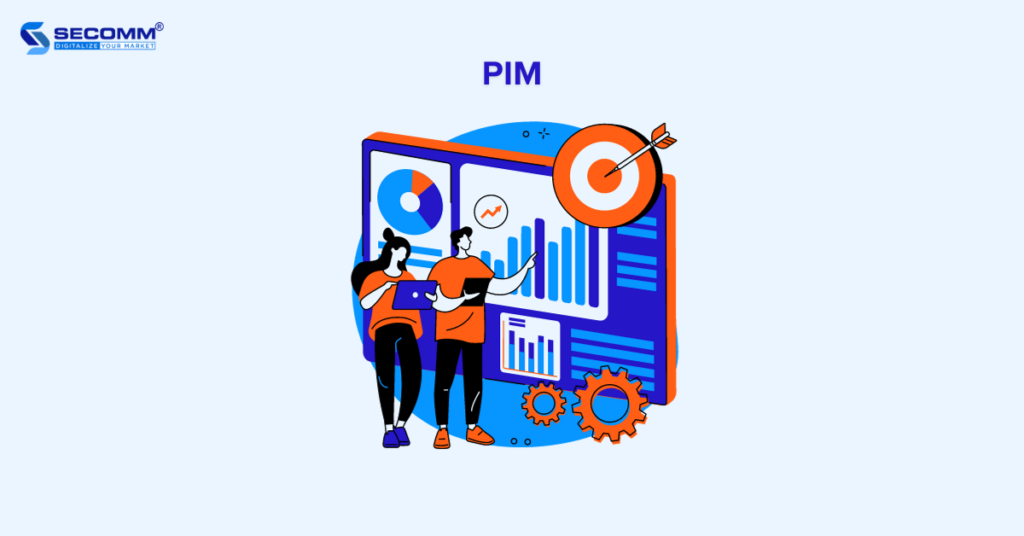
This tool helps you manage product information across diverse platforms, making it easier for customers to choose their desired products. Plus, PIM helps you save time compared to manual data entry, thereby reducing personnel costs.
Take Akeneo PIM, for instance; it is an open-source platform tailored for managing product information effectively. Akeneo is also flexible enough to seamlessly integrate with various systems such as ERP, CRM, POS, and popular eCommerce platforms like Magento, Shopify, and WooCommerce.
Currently, Akeneo offers three main PIM plans, including:
The Order Management System (OMS) helps you process orders in various channels.
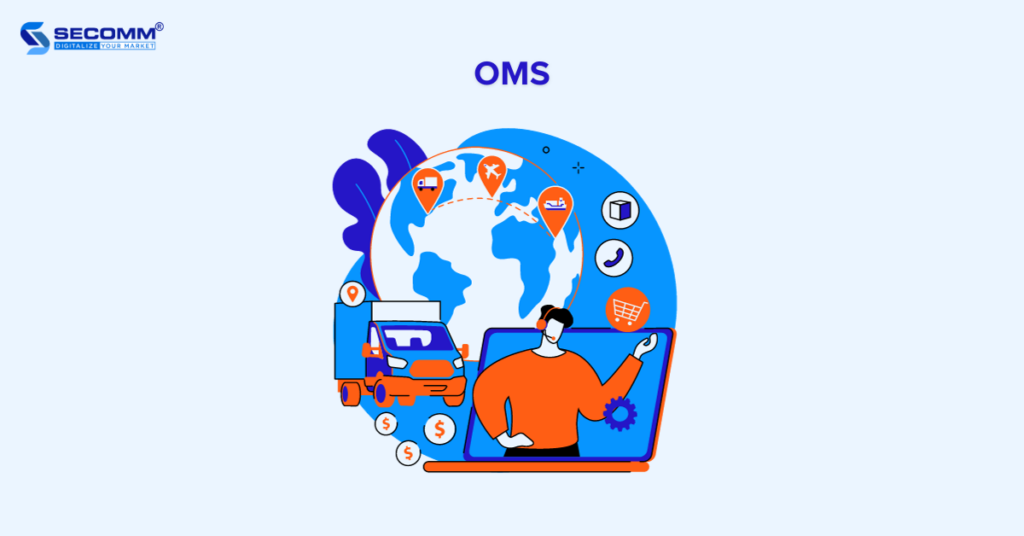
This eCommerce integration not only helps businesses efficiently manage orders, optimizing the customer experience, but also collects and analyzes data at peak and off-peak sales times, as well as for specific orders, top-selling items, and consumer behavior.
So, you’ll easily adjust their business strategies and manage inventory effectively.
For example, Fabric OMS is a Distributed Order Management (DOM) system designed to help you streamline the order processing process, including online purchases at the store (BOPIS), delivery to the store, and in-store order fulfillment.
Fabric’s order management solution helps you integrate and manage the entire order process on a single interface. You can optimize your order processing, minimize inventory discrepancies, and free up resources for other important tasks.
The Warehouse Management System (WMS) will help you manage the flow of goods, inventory, and shipping to facilitate sales and order fulfillment.
By automating order processing and optimizing the layout of goods in the warehouse, WMS accelerates order processing, reduces order preparation time, and enhances the ability to quickly respond to customer demands.
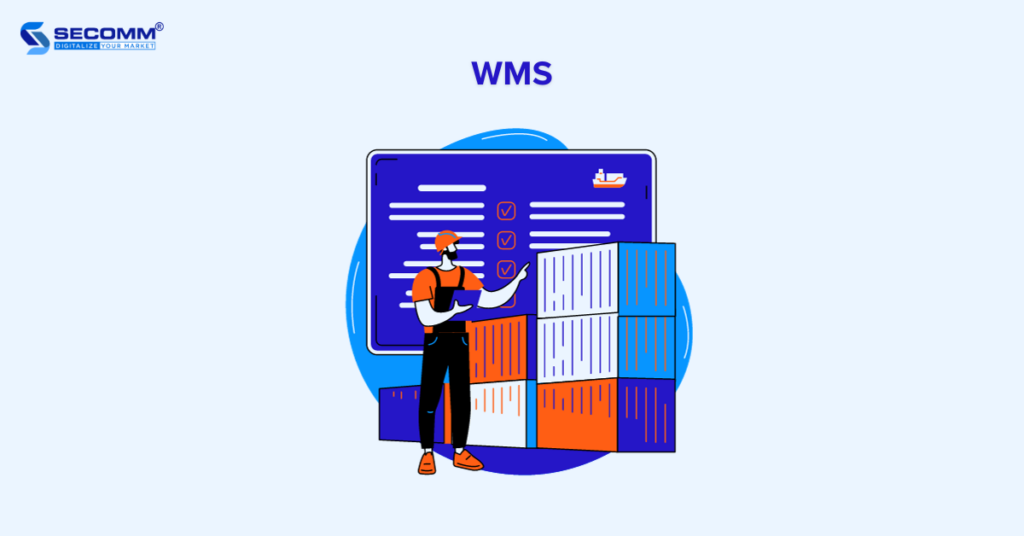
For example, Oracle Warehouse Management Cloud (WMS) is one of the eCommerce integrations that offers a cloud-based warehouse management system. It is well-suited if you’re looking for effective warehouse inventory management.
It automates warehouse processes such as receiving, storage, order processing, and shipping, particularly well-suited for a wide range of business scales. It also seamlessly integrates with ERP, CRM, and other supply chain solutions.
POS (Point of Sale) is a system that includes both hardware and software components, or it can be as straightforward as a point-of-sale device like a computer, tablet, smartphone, or receipt printer.
POS helps you manage and execute sales transactions, calculate payments, generate receipts, manage inventory, handle customer relations, and provide crucial sales-related information.
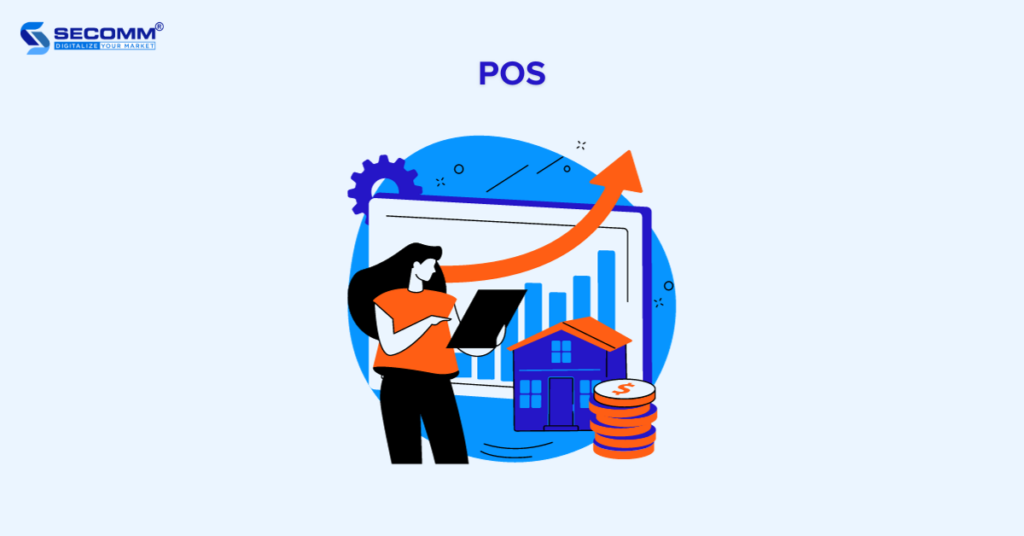
For instance, the Square POS system, developed by Square, has garnered the interest of numerous large businesses globally due to its free features. However, each transaction conducted through the POS incurs a fee of 2.6% and 10 cents for each tap, dip, or swipe.
For the “Buy Now Pay Later” model, the fee is 6% and 30 cents. Additionally, Square provides tailored POS packages for businesses with revenues surpassing $250,000.
Xem thêm:
CRM (Customer Relationship Management) helps you organize and manage customer information, including contact details, purchase history, and interactions. So, you’ll easily tap into customer needs and preferences, optimizing the shopping experience and increasing order conversion rates.
Moreover, CRM allows internal departments to interact and work on a unified and automated system, saving time and costs.
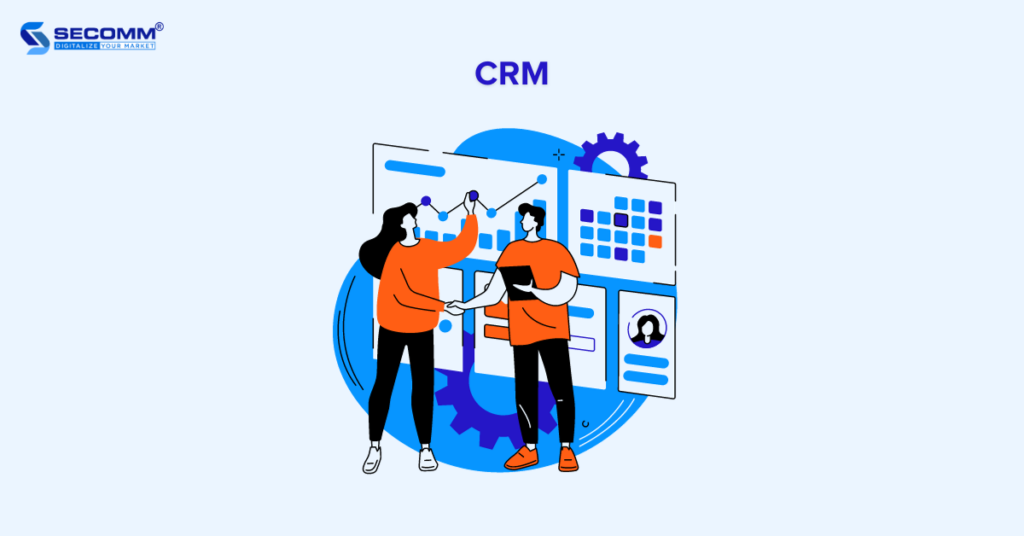
For example, Dynamics 365 Sales is one of the CRMs developed by Microsoft. With its intuitive interface, easy setup, and flexible customization capabilities, you can manage and enhance the efficiency of the sales process.
the system provides a “Real-time Insight” feature to deliver real-time insights from sales calls, such as customer emotions and sentiments. This helps businesses assess and strategize for their sales teams.
Currently, the system offers three plans:
Learn more:
Instead of relying on separate, isolated software systems lacking interdepartmental cohesion, ERP (Enterprise Resource Planning) integrates all software into a unified system.
The ERP eCommerce integration helps you manage all organizational activities, from inventory control and orders to financial planning and customer interactions.
You’ll maximize time efficiency, minimize costs, boost business productivity, and reduce unnecessary workforce.
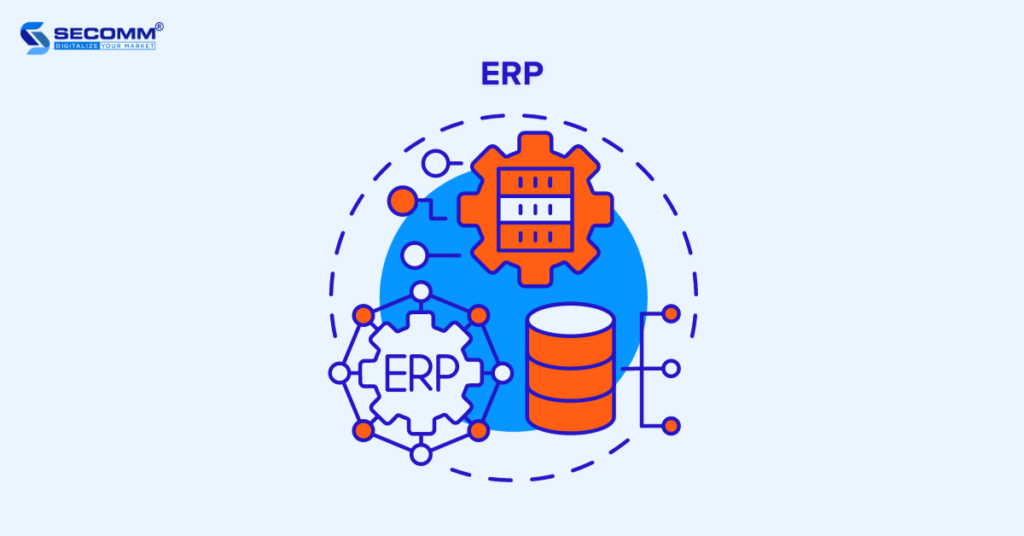
For example, Oracle ERP is one of the top global ERP software known for its outstanding features for operational efficiency.
Currently, Oracle provides three different plans tailored to specific needs:
Learn more: 6 best enterprise ERP software
Business Intelligence (BI) helps you analyze data from various sources such as eCommerce websites, POS systems, CRM, and other data sources. Plus, you’ll gain a deeper understanding of customer behavior, shopping trends, and factors influencing sales performance.
By using BI, you can also predict shopping trends to formulate specific strategies, while simultaneously monitoring financial performance, including forecasting sales figures, profits, and other financial indicators. This helps you allocate resources accurately.
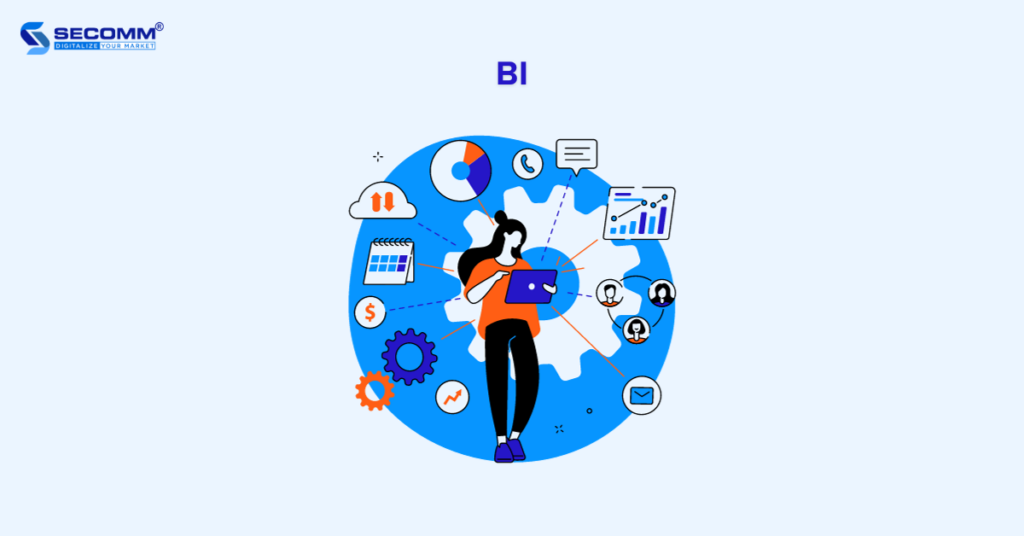
For example, Tableau is a widely used BI tool suitable for various individuals and organizations. With a user-friendly interface that requires minimal technical knowledge, Tableau allows users to easily create reports and visualize data.
The ability to connect and integrate data from various sources, including cloud data, and transform it into visually appealing charts and graphs, makes it easy for users to analyze trends and information
Deploy eCommerce integrations today!
Above are 7 popular eCommerce integrations to build your eCommerce website and enhance your online presence. You’ll choose your best-suited systems depending on the strategy, estimated budget, and business direction.
With profound knowledge of the eCommerce industry and experience in deploying integrations for all sizes of businesses, SECOMM is committed to proposing cost-effective solutions to develop your high-performing eCommerce system.
Contact or call directly on the SECOMM hotline (02871089908) to get started today!
 2
2
 4,095
4,095
 1
1
 1
1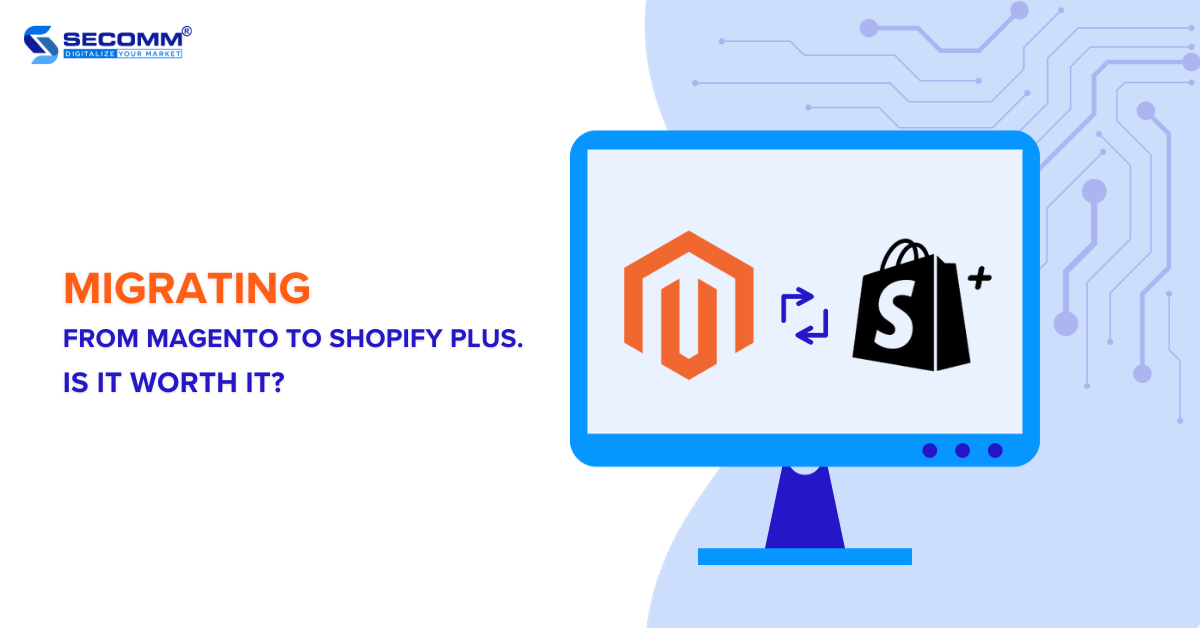
Migrating from Magento to Shopify Plus is a strategic decision that many businesses are considering. While Magento holds a prominent position in the eCommerce market, the ongoing trend of switching to Shopify Plus has raised questions about its reasons, prompting a comparison between the two platforms. Join us in exploring these aspects in this article.
Learn more: Adobe Commerce vs Shopify Plus
Magento is an open-source eCommerce platform with over 140,000 active websites and was acquired by Adobe in 2018. It offers many advanced features, allowing you to tailor your eCommerce websites.
It has two versions: Magento Open Source, a free option to download and install on your servers, and Adobe Commerce (formerly Magento Enterprise), a paid version with premium features such as Adobe’s hosting and security services.
Shopify Plus stands out as Shopify’s advanced SaaS eCommerce platform tailored for large and rapidly growing enterprises. With high scalability, it can handle surges in traffic and sales volumes reaching billions of dollars.
By leveraging Shopify Plus, you can benefit from a robust infrastructure that facilitates easy customization and centralized management of multiple stores, brands, languages, and currencies through a dashboard.
Also, the platform offers a range of superior solutions to enhance eCommerce operations, including Shop Pay, Shopify Flow, LaunchPad, Shopify Scripts, and more.
Many businesses opt to move away from the Magento platform in pursuit of a more optimal solution for their eCommerce websites. However, the following two reasons are widely regarded as the most prevalent.
After launching the Magento 2 (M2) version, the company has declared they’ll no longer support the Magento 1 (M1) version. This means that if you’re using the older version, you won’t receive security updates, bug fixes, and technical assistance.
So, the platform encourages their customers to upgrade to M2 to ensure continued technical support, enhanced security, and access to a variety of new and advanced features.
However, the upgrade process is complex, requiring significant investment in terms of cost and time for source code and interface customization. It may force you to halt your eCommerce operations.
In case you want to keep operating M1 alongside the update process, there’s a potential risk of disrupting system operations, causing significant disruptions to the customer experience, and ultimately affecting sales.
Moreover, there’s also a potential risk of compatibility issues, as some features and modules initially built on M1 may require significant customization to operate effectively on M2.
Faced with these risks, some businesses opt not to upgrade but rather switch to an alternative eCommerce platform. Frequently, these businesses turn to SaaS platforms that offer robust technical support and readily available solutions.
Learn more: M1 vs M2
Some businesses that have upgraded and used M2 for a while have realized that it may not be the best choice. Developing and maintaining a M2 website requires high technical expertise, especially if you want to integrate and customize specific features.
If you don’t have a sufficiently professional technical team or inefficiently collaborate with deployment partners, the customization process is even more complex.
Plus, while the open-source platform offers high scalability, it lacks flexibility. So, if you don’t set up and build your system properly, it may get issues during peak shopping times, leading to crashes and interruptions.
This, in turn, customers to be unable to access the website for purchases, causing significant harm to your brand.
Learn more: The costs of building a Magento eCommerce website
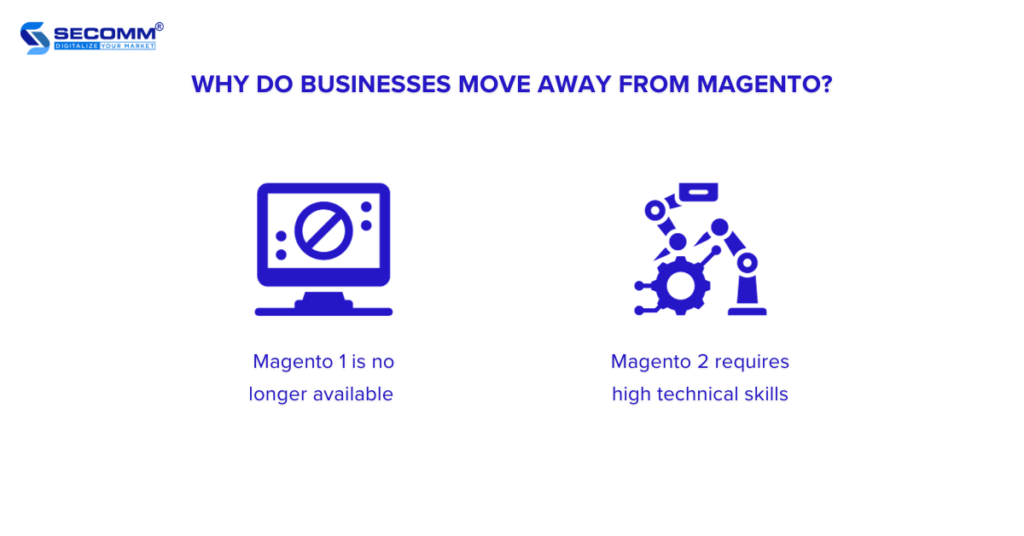
Learn more: 15 reasons why you should migrate to Shopify Plus
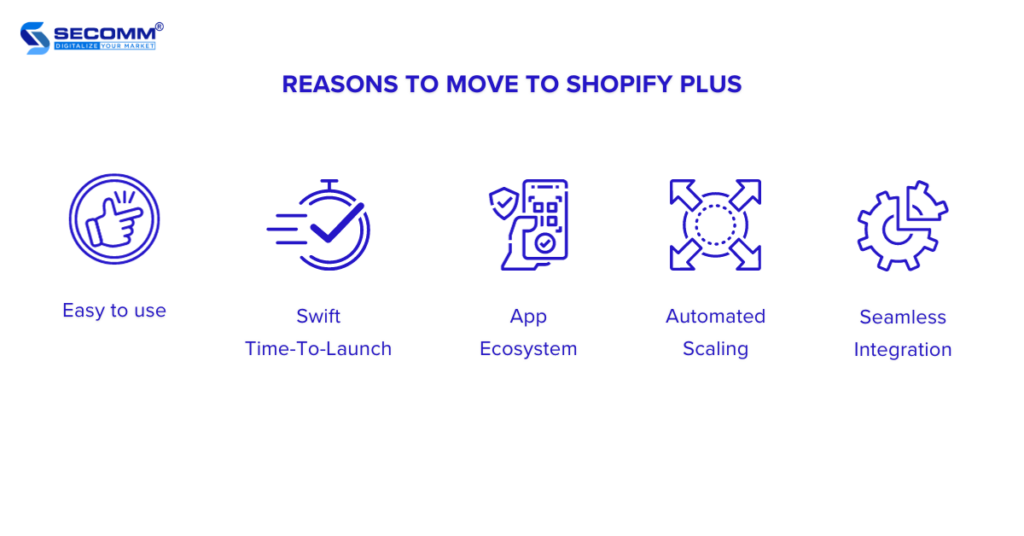
Below are some brands that have previously embraced eCommerce using Magento and switched to Shopify Plus to reduce technical complexities and costs.
Gymshark, a UK-based brand specializing in sportswear and fitness fashion, has emerged as a prominent and favored global sportswear brand since its inception in 2012.
Facing a website crash during the bustling Black Friday shopping season, Gymshark, previously on Magento, made the strategic decision to switch to Shopify Plus.
Despite time and financial investments in repairing and maintaining the system, there was no guarantee of long-term effectiveness.
Upon switching to Shopify Plus, Gymshark capitalized on available solutions such as Shopify POS to elevate both online and offline shopping experiences. The implementation of Shopify Scripts, an exclusive tool for the ‘Plus’ merchants, allowed them to customize and optimize the checkout process.
By using this advanced SaaS platform, Gymshark significantly boosted conversion rates and sales, particularly during major year-end shopping events. This success has firmly established Gymshark as one of the fastest-growing brands globally.

Founded in the United States in 2013, Bombas is a brand specializing in the manufacturing and retail of socks. Renowned for its “buy one, donate one” approach, Bombas pledges to donate a pair of socks to those in need for every pair sold.
Bombas faced website crashes on its previous Magento platform, occurring during Shark Tank program airings and major shopping events like Black Friday and Cyber Monday. These disruptions led to substantial financial losses and incurred significant fees for system repairs over an extended period.
To capitalize on the seamless scalability offered by Shopify Plus, Bombas moved away from the previous. The Bombas website remained resilient during significant year-end shopping events.
The brand not only recouped its investment quickly but also witnessed a remarkable 300% surge in sales compared to the same period the previous year.

Jack Rogers, an iconic American brand specializing in footwear and fashion accessories, has enjoyed widespread recognition globally for an extended period. The brand is not only distinguished for its use of the highest-quality materials in crafting sophisticated and luxurious footwear but also for its global prestige.
After running on the Magento platform for a while, Jack Roger’s eCommerce website started experiencing issues. Each minor update incurred significant time and costs, leading to the decision to switch to Shopify Plus. This move aimed to find a cost-effective solution for operations and maintain the overall stability of the system.
Jack Rogers implemented Shopify Flow to automate both operational and sales processes. The brand also integrated various third-party applications such as Smile, Gorgias, and more to augment the eCommerce efficiency.
Learn more:

Below are some notes to consider during the platform migration process.
There are several methods to migrate data to the Shopify Plus system, such as automated migration, manual migration, and data import/export. You can choose one of these methods or deploy all of them to streamline the migration process and enhance data accuracy.
Customer data
Product data
Transaction data
Switching an eCommerce platform in general and specifically migrating from Magento to Shopify Plus is a complex process that demands detailed planning, precision, and an investment in both budget and time, along with technical expertise.
Therefore, solution architects need to strategize to redesign the system, encompassing system architecture, infrastructure, technology, performance monitoring tools, etc.
When deciding to switch to Shopify Plus, there are some things related to website optimization you need to keep in mind. The URL structure of the two platforms differ, so you should check the navigation of all web pages to ensure the preservation of SEO value and user redirection to the correct pages.
During the platform migration process, a temporary decrease in rankings on search engines like Google or Bing is normal and not a cause for concern. These search engines may take a few days to process the new website and update essential indices.
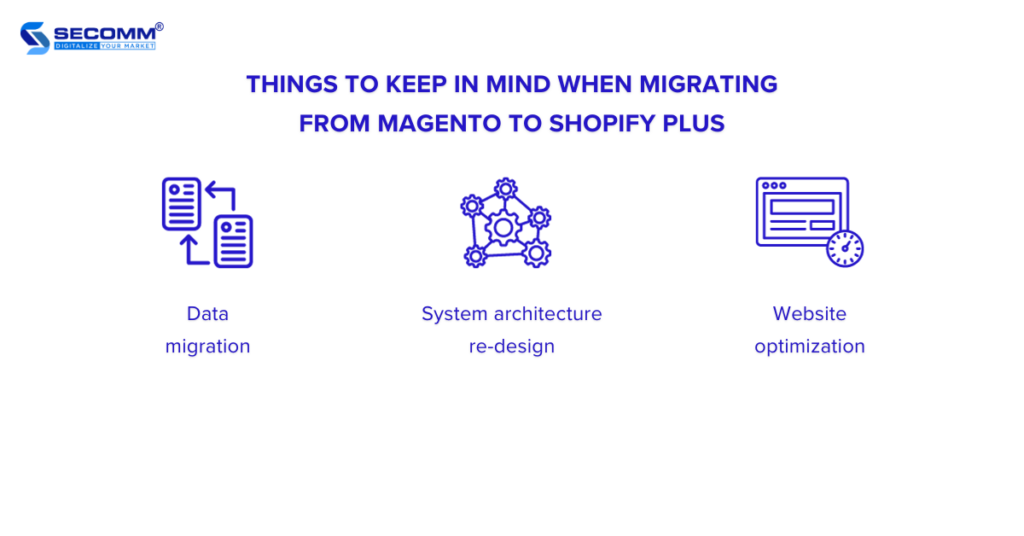
Lately, Shopify Plus has emerged as the preferred choice for businesses making the move from the Magento world.
Having extensive experience in developing eCommerce websites on both eCommerce platforms, and successfully executing the Shopify Plus migrations, SECOMM has become a reliable technology partner for many large enterprises such as Vinamilk and Suzuverse.
Contact SECOMM or call directly at the hotline (028 7108 9908) to start the project of the Magento to Shopify Plus platform migration process tailored to your business.
 2
2
 5,029
5,029
 0
0
 1
1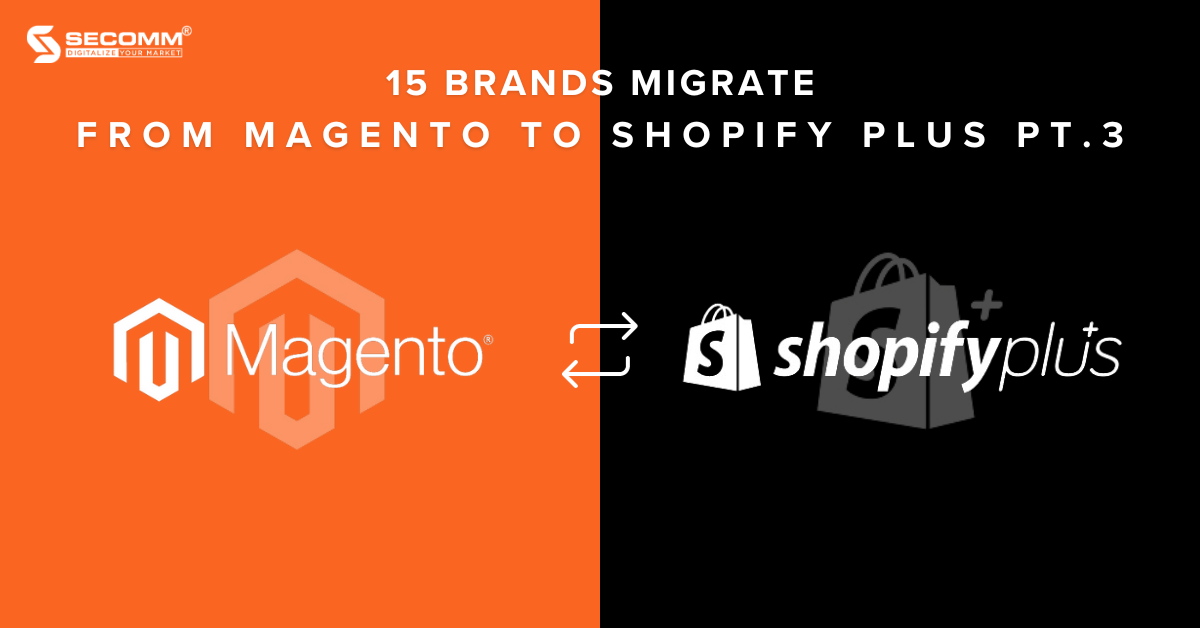
Building upon the narratives in parts 1 and 2, this third part invites you to delve into the stories of the remaining brands within the series of 15 that migrate from Magento to Shopify Plus. Explore how this strategic decision has led to their success in terms of sales and paved the way for sustainable growth in the future.
Learn more:
Beard & Blade is a wholesale business specializing in providing products for hair styling, beard care, and beauty and skincare for men. The brand is known for offering high-quality products tailored for men who aim to maintain their appearance and well-being.
Beard & Blade’s wholesale website was initially built and developed on the Magento eCommerce platform. However, according to the Beard & Blade team, operating the wholesale system on this platform proved to be challenging and required numerous manual tasks.
This resulted in time loss, and the overall cost for their wholesale system to operate on Magento was a considerable amount. Therefore, the brand decided to revamp its platform with Shopify Plus.
After considerable efforts, Beard & Blade’s Shopify Plus wholesale website for men’s products was officially launched.
By utilizing Shopify Plus’s dedicated solutions for wholesalers, Beard & Blade was able to automate inventory management, customize product pricing, and set discount levels based on the quantity of products ordered.
In contrast to the previous operational experience on Magento, wholesale orders on Shopify Plus are processed consistently, without interruptions, and without requiring manual tasks, thus avoiding disruptions to the customer experience.
Since the launch of the new website on Shopify Plus, Beard & Blade’s wholesale revenue has increased by 100%, and the average order value (AOV) for wholesale is five times higher than the retail AOV.

Milligram is a fashion and stationery brand headquartered in Melbourne, Australia. The brand primarily focuses on producing and providing stationery products, including notebooks, pens, and bags made from premium materials with unique designs.
Initially, Milligram built its eCommerce website on the Shopify platform, and later, in pursuit of brand growth, switched to using the Magento platform. After a while, as Milligram expanded its scale with more offline stores, the Magento website system started to operate slowly, and the backend database was overloaded.
Errors and delays occurred during updates, causing disruptions beyond the normal timeframe. Therefore, Milligram returned to Shopify, but this time opting for the advanced version – Shopify Plus.
Leveraging the available solutions of Shopify Plus, Milligram built and customized advanced features, such as an enhanced search function, to provide an optimal shopping experience for customers.
The platform transition from Magento to Shopify Plus was swift and smooth. Milligram easily executes promotional campaigns, uploads products without requiring technical skills, and finds managing and operating the Shopify Plus system more straightforward compared to Magento.
This allows Milligram to focus wholeheartedly on sales, marketing, and enhancing customer relationships.

Eden Park is a prestigious fashion brand originating from France, renowned for its high-end sportswear and fashion products. The brand specializes in providing premium sports and fashion items, with their collections often combining a blend of comfortable and luxurious styles.
In 2021, Eden Park turned its attention to Shopify when contemplating entry into the U.S. market. Moreover, at that time, Eden Park’s eCommerce website faced numerous operational issues.
Bastien Borget, the eCommerce Director of Eden Park, admitted that the business spent approximately 80% of its time operating the Magento website, yet the system consistently experienced errors, and the maintenance incurred substantial costs.
During Black Friday, the Magento website crashed due to overload from a sudden surge in traffic. At that point, Eden Park decided to revamp its platform with Shopify Plus, utilizing solutions within the Shopify ecosystem such as Shopify Payment and Shopify Flow.
Additionally, the superior integration capabilities of Shopify Plus allowed Eden Park to seamlessly integrate with third-party applications like Klaviyo, Gorgias, and Babak.
Eden Park’s Shopify Plus eCommerce website took less than 2 months to launch. One year after the introduction of the new website, Eden Park’s revenue increased by 30%, and the conversion rate rose by 48%.
The solutions provided by Shopify Plus alleviated the operational burden for Eden Park, allowing the business to allocate more time to marketing and sales rather than website maintenance, contributing to impressive business results.

Jack Rogers is a renowned footwear and fashion accessories brand headquartered in New York, USA. The brand is known for producing stylish sandals with traditional designs and premium materials, making Jack Rogers an icon of aristocratic fashion.
For a prominent fashion brand like Jack Rogers, utilizing a website as a potential sales channel remains crucial. However, the Jack Rogers website operating on the Magento platform began experiencing errors after a certain period.
Tasks such as repairs, changes, system operations, or running marketing campaigns consumed a significant amount of time for the technical team, leading to higher costs for Jack Rogers.
Moreover, inventory management posed challenges, with overselling issues occurring, and inaccuracies in the system’s quantity calculations resulting in revenue loss and a suboptimal customer experience.
Therefore, the Jack Rogers team sought to simplify their system, implement automation processes, and reduce technical burdens to focus on more critical business tasks.
The migration from the Magento platform to Shopify Plus helped Jack Rogers address these challenges. The new Jack Rogers website leveraged Shopify Flow solutions to automate operational, marketing, and sales processes, saving considerable time and labor compared to the manual processes of the previous Magento website.
Jack Rogers also utilized Shopify Plus Certified App applications to enhance the customer experience, including Returnly, Smile, Gorgias, and others.
During the Covid-19 social distancing period, Jack Rogers’ Shopify Plus website became the primary sales channel for the brand, experiencing a 60% increase in website traffic and a 30% increase in conversion rates.

Skin Inc is a skincare brand based in Singapore, specializing in providing personalized skincare products based on scientific principles and advanced technology. The brand is renowned for creating diverse and high-quality skincare products, particularly serums and unique skincare items.
With pride in their personalized products, Skin Inc also aimed to build an optimal online shopping experience with a high degree of personalization for customers. However, the business lacked the tools to achieve this.
Each time the technical team made a few changes, the website system immediately slowed down, lagged, and sometimes even had to temporarily suspend operations, causing disruptions to customer shopping.
This issue occurred frequently, especially during major year-end shopping seasons, resulting in substantial losses for Skin Inc, amounting to thousands of dollars.
Therefore, Skin Inc needed an alternative eCommerce solution that could be easily customized to deliver the best customer experience. Skin Inc transitioned from Magento to Shopify Plus and swiftly found solutions to enhance the customer experience.
With multi-store management features, Skin Inc could create multiple versions of eCommerce websites to tailor the experience for different customer segments in various markets.
In addition, Skin Inc implemented Shopify Flow and LaunchPad solutions to automate operational and sales processes. The seamless integration capabilities of Shopify Plus enabled Skin Inc to easily integrate with third-party applications to enhance marketing campaigns and customer loyalty programs.
As a result, this renowned beauty brand was able to reduce operational time by 50% and increase conversion rates by 200%.

So, SECOMM has gathered insights from 15 representative brands that courageously stepped out of the “Magento world” to revamp their eCommerce websites with Shopify Plus. These brands prioritize customer experience and streamlined processes, inspiring others to confidently opt for platform migration.
Contact SECOMM or call directly at (+84)28 7108 9908 for advice and implementation of the eCommerce migration process from Magento to Shopify Plus today!
 25
25
 4,786
4,786
 0
0
 1
1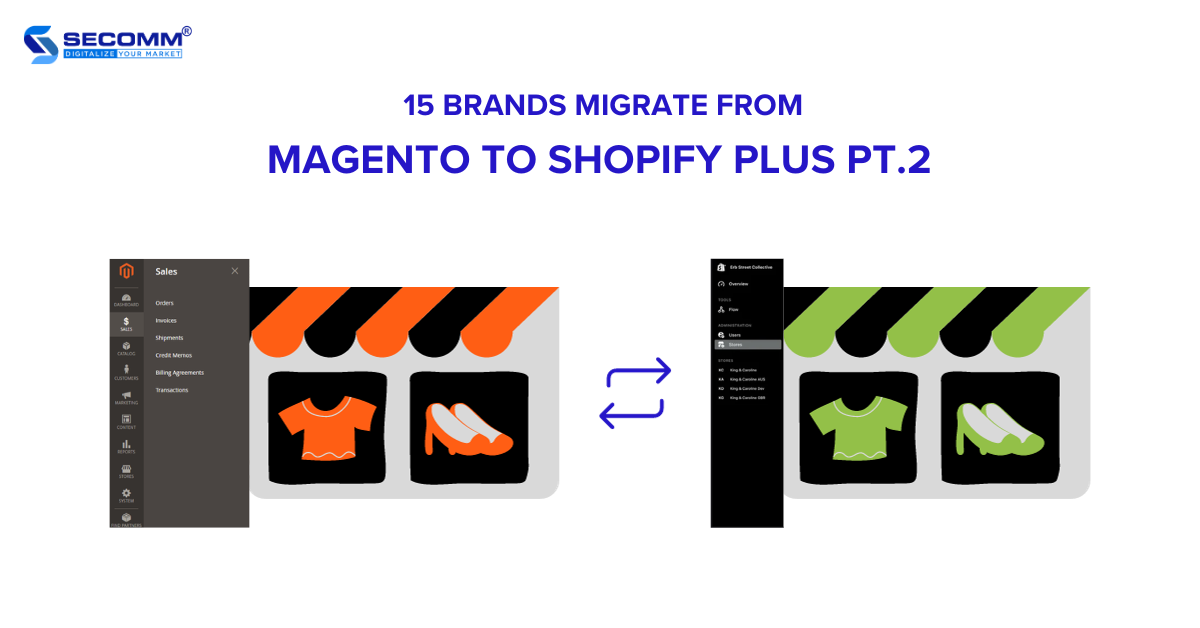
When it comes to brands that migrate from Magento to Shopify Plus, it’s good to read their success stories in sales behind. In the second part of this series, let’s continue to delve into more brands that chose to migrate their eCommerce platforms from Magento to Shopify Plus, and explore how this decision paved the way for boundless success.
Originally established as a wholesaler distributing high-quality underwear through pharmacies, Boody later identified new growth opportunities by venturing into online sales for environmentally conscious fashion enthusiasts.
Boody initially deployed an eCommerce website on the Magento platform, but the absence of a dedicated technology team severely limited management, operations, and customization capabilities.
Also, inconsistencies between the frontend on mobile devices and laptops, utilizing different technological solutions, resulted in a non-uniform user experience and inefficient use of system resources.
To address these challenges and pursue goals of international expansion, Boody sought a platform that could alleviate the burden of management and operations while providing a consistent customer experience.
The fashion brand switched from Magento to Shopify Plus, promptly implementing automated solutions for processes such as email and security checks using Shopify Flow. Boody also adopted Shopify Payments to facilitate online transactions without the need for integration with third-party payment service providers.
The platform overhaul with Shopify Plus significantly enhanced the operations. Leveraging the robust integration capabilities of Shopify Plus, Boody seamlessly integrated with third-party systems to strengthen customer relationships, including platforms like Klaviyo, Gorgias, and Odoo.
Benefiting from the flexibility and solutions offered by Shopify Plus, Boody developed a customized eCommerce website without requiring extensive technical expertise. This allowed the Boody team to focus on multi-channel sales strategies and international expansion.
Shortly after the platform transition, Boody rapidly expanded into 10 international stores, witnessing a 70% increase in online sales and a 5% rise in conversion rates. With Shopify Plus, Boody is realizing its mission to become the world’s most beloved sustainable underwear brand.
Learn more: 15 brands migrate from Magento to Shopify Plus Pt.1

Alessi is a renowned Italian brand specializing in the design and manufacturing of high-quality household and interior decoration products. The brand was established in 1921 and has since become one of the icons of Italian art and design.
Alessi pays attention to every detail in product design while relying on third-party units to enhance the aesthetics of its website design.
However, the Magento eCommerce platform, which Alessi had been using for a long time, suddenly announced the end of support for older versions, obliging merchants to upgrade to a higher version.
Faced with the complex and time-consuming upgrade process, Alessi decided to seek an alternative solution.
Moreover, the outbreak of the Covid-19 pandemic in Italy and across Europe prompted Alessi to make necessary changes to maximize online sales. The business executives aimed to re-establish the platform within just 12 weeks.
In reality, Boody achieved the goal in less than 3 months by completing the e-commerce platform transition from Magento to Shopify Plus.
Since implementing Shopify Plus, Alessi has seen a 233% increase in page views, a 109% increase in conversion rates, a 222% increase in transaction volume, and a 210% increase in total online revenue.
Alessi can now rest assured that customers will have an engaging shopping experience on the website, reflecting the true brand image that the business has spent a century building.

Rebecca Minkoff, a renowned high-end fashion brand from the United States, is well-known for its handbags, footwear, and fashion accessories. The brand’s products often embody a blend of alluring, practical, and creative styles.
Rebecca Minkoff not only focuses on creating aesthetically pleasing fashion items but also consistently leverages technology to provide customers with novel shopping experiences over the past decade.
In addition to this, the customer’s online shopping experience on the brand’s eCommerce website is a particular area of emphasis. The migration from the Magento eCommerce platform to the Shopify Plus platform is also part of Rebecca Minkoff’s strategy.
Utilizing solutions available within the Shopify Plus ecosystem, coupled with robust and seamless integration capabilities, has enabled this fashion brand to implement 3D and AR (Augmented Reality) technologies.
These technologies aim to enhance customers’ unique, detailed, and realistic views of products, ranging from styles to materials.
According to the company, individuals interacting with 3D models are 44% more likely to add that model to their shopping carts compared to those who do not interact. Among visitors who engage with 3D models, they have a 27% higher likelihood of placing an order compared to non-interacting individuals.
Rebecca Minkoff notes that when customers view a product in AR, their likelihood of making a purchase increases by 65%.
This positive step in eCommerce has significantly contributed to business growth. According to Rebecca Minkoff, 65% of customers interacting with AR products tend to make purchasing decisions swiftly, and with 3D technology, this figure is 27%.

Established in 2012 in the United Kingdom, Blakely is a unisex fashion brand known for its youthful and dynamic style. Blakely’s product range includes t-shirts, hoodies, sweaters, leggings, jeans, and fashion accessories. The brand aims to provide high-quality, beautifully designed, durable products that align with current fashion trends.
Blakely’s eCommerce website was initially built on the Magento platform. However, the system frequently experienced crashes, especially during peak shopping periods like Black Friday, affecting customer shopping experiences and the brand’s revenue.
Another concern for Blakely with the previous platform was its limitations in integrating with third-party applications, posing challenges in reaching target customers and efficiently managing customer data to drive real growth. Furthermore, the lack of tools for data management led to issues in the personalization and localization of the customer experience.
Therefore, after careful consideration, Blakely decided to migrate from the Magento platform to Shopify Plus. With the implementation of Shopify Plus, Blakely successfully launched two additional eCommerce websites specifically catering to EU and U.S. customers, enabling the brand to sell more efficiently in international markets.
Blakely also utilized Shopify Plus’s available themes and seamlessly integrated with third-party tools to not only provide an optimal shopping experience for customers but also support effective data management.
Switching to Shopify Plus brought about significant positive changes for Blakely in terms of sales. Specifically, the conversion rate increased from 1.4% to 2.6%, and the EU store witnessed an impressive 30% growth since its launch. Global sales increased by 49%, with a 130% increase in sales in the U.S. and a 60% increase in sales in the EU.

Peepers is a fashion brand specializing in reading glasses and sunglasses with its main headquarters located in Michigan, USA. The brand is known for blending modern design with quality, offering high-quality products at affordable prices.
Despite several redesigns that consumed considerable time and budget, Peepers’ Magento website failed to meet expectations.
The brand aimed to enhance page loading speed and provide customer-centric features, but the costs associated with each change or system update on Magento proved to be a significant expense for Peepers.
Therefore, Peepers made the switch to Shopify Plus to leverage the platform’s flexible customization capabilities with a more cost-effective approach than Magento.
Furthermore, offering a customized payment experience enhances the security of customers’ personal and payment information, thereby increasing customer trust when shopping on the Peepers website.
Since transitioning from the Magento platform to Shopify Plus, this fashion brand has witnessed a 30% increase in conversion rates and a 20% increase in the average order value (AOV).

Here are the next 5 brands in the series re-platform from Magento to Shopify Plus. While Boody’s motivation for the switch is to ease the burdens of management and operations, Alessi, in contrast, seeks to avoid the expenses and time involved in upgrading to a higher platform version.
Rebecca Minkoff, however, aims to capitalize on the existing ecosystem of Shopify to implement 3D and AR technology solutions for their eCommerce website.
Similarly, Blakely and Peepers overhauled their platforms to streamline operational time and costs, leveraging the advanced integration capabilities of Shopify Plus to deliver a distinctive customer experience.
Throughout SECOMM’s process of executing platform migration, the pivotal factor determining success is a detailed and well-structured conversion plan.
Contact SECOMM or directly call the hotline at (028 7108 9908) to collaborate on devising the optimal plan for the platform migration.
 2
2
 5,264
5,264
 0
0
 1
1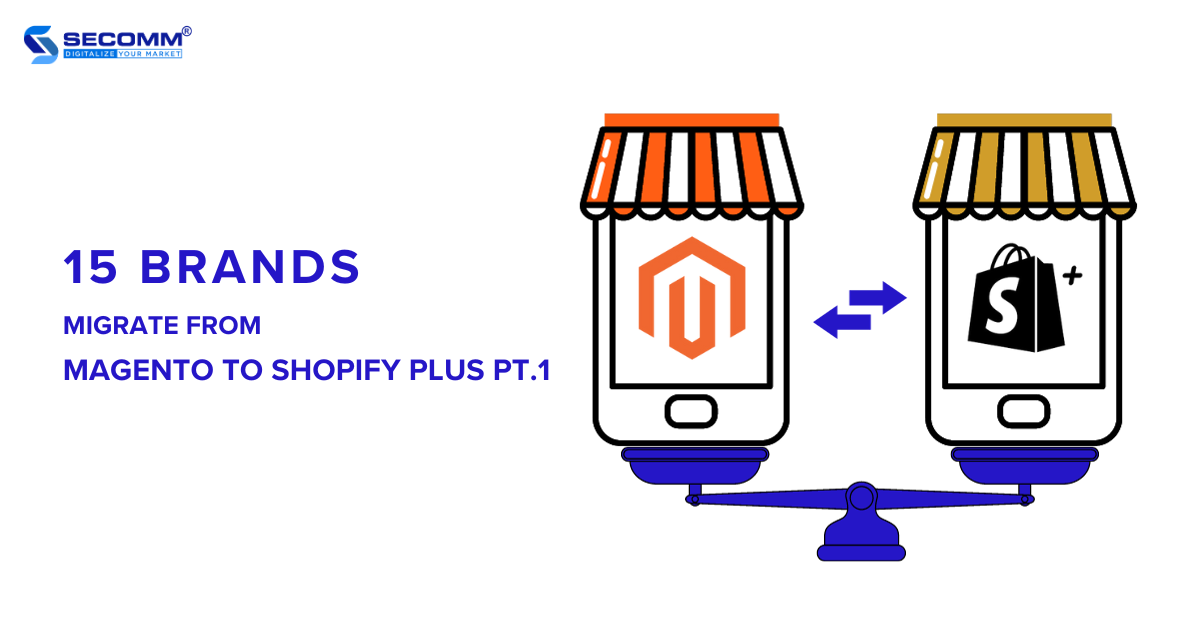
Magento is known as the ‘golden standard’ for many eCommerce businesses. With its scalability and flexible customization, Magento can provide a unique shopping experience.
However, the complexity of deploying, managing, and maintaining the system has led many brands to step out of the ‘Magento world’ in search of more optimal solutions. Shopify Plus is one of the popular choices today for streamlining the migration.
Let’s delve into why the following five brands opted to migrate from the Magento platform to Shopify Plus for their eCommerce websites, and how this strategic decision has contributed to increased conversion rates and sales.
Learn more: 15 Reasons You Should Migrate to Shopify Plus
Established in 2012, Gymshark, a renowned athletic wear retail brand, adopted Shopify Plus. However, before making the switch, the brand had built and developed its eCommerce website using Magento.
For a fashion retailer, year-end shopping seasons, especially Black Friday, represent opportunities for sales growth. Simultaneously, Gymshark’s rapid expansion since its inception required more from a platform capable of managing spikes in traffic and consistently scaling with its business objectives.
Dissatisfied with the existing system, the Gymshark team faced not only the time-consuming setup and operation but also significant costs – amounting to thousands of dollars – for repairing and maintaining the system that crashed precisely during the Black Friday event.
According to Ben Francis, the founder of Gymshark, the eCommerce website was down for about 8 hours, resulting in an estimated damage of over £100,000.
Therefore, Gymshark overhauled its platform with Plus, leveraging Shopify POS and Shopify Script solutions to bridge the gap between offline and online shopping experiences. They enhanced these shopping experiences with custom code snippets at the checkout page.
With these tools, Gymshark only needed to customize based on its specific needs and goals. In contrast, developing such features on Magento could have consumed considerable time and budget.
The platform switch to Shopify Plus helped Gymshark achieve a retail turnover of £41 million and garner over 5.1 million social media followers in 2017, propelling the business to become one of the fastest-growing brands globally.

Arising from an inspiring founding narrative, Bombas, a U.S.-based sock manufacturer and retailer, committed to donating a pair of socks for each pair sold to those facing homelessness. The company garnered successful funding on Shark Tank in 2013, capturing the interest of both investors and American consumers.
However, the joy quickly turned to dismay when Bombas secured a deal with investor Daymond John, and their Magento eCommerce website suffered not one but two crashes—first during the initial airing and then during the subsequent rerun of the episode.
Compounding the issue, the most disastrous moment for Bombas occurred when their Magento website collapsed amid the peak shopping season of Black Friday and Cyber Monday (BFCM).
The system failure hindered customers from completing transactions, resulting in Bombas incurring significant financial losses, additional expenses, and extended downtime for system repairs.
Therefore, Bombas needed a more reliable eCommerce platform that could effectively address the issues they encountered, leading them to choose Shopify Plus.
The infrastructure of Shopify Plus facilitated Bombas in effortlessly and seamlessly expanding their system. Moreover, the eCommerce website system consistently withstood the demands of major shopping events like BFCM and reruns of the Shark Tank program.
Despite the substantial cost of migrating from Magento to Shopify Plus, Bombas swiftly recovered the investment, generating $17.2 million in revenue during the first year of Shopify Plus deployment—a 300% increase compared to the same period the previous year.
The positive outcomes of transitioning to the Shopify Plus platform are evident not only in financial metrics but also in how Bombas has bolstered its reputation and image in the eyes of customers, delivering a premium shopping experience.

In 2010, from the beaches of Costa Rica, two young entrepreneurs, Griffin Thall, and Paul Goodman, started Puravida Bracelets with a mission to collaborate and provide better income opportunities for bracelet artisans in Costa Rica and around the world.
The Puravida Bracelets story gained attention on social media as customers became curious about the close-to-nature lifestyle in South America, particularly in Costa Rica. Over time, the brand expanded its product portfolio to include necklaces, anklets, earrings, and hair ties.
Similar to many other businesses, Puravida Bracelets began its eCommerce journey with the Magento platform.
However, both Thall and Goodman were ambitious young entrepreneurs who desired rapid growth and development for their bracelet brand. Therefore, the challenge was to scale the eCommerce website system while ensuring the most optimal deployment costs.
This led Thall and Goodman to deploy Shopify Plus to find a solution to seamlessly integrate and combine various tools and applications to manage business operations more efficiently, provide a more engaging shopping experience, and increase sales.
The decision to switch from the Magento platform to Shopify Plus helped Puravida Bracelets increase retail revenue by 50% compared to the same period the previous year. Email sign-ups increased by 350%, and email revenue quadrupled compared to before the platform revamp.

PittaRosso is a renowned footwear retail brand from Italy with over 150 retail stores across Europe. The brand’s goal is to provide customers with an omnichannel shopping experience and implement several enhancements for its eCommerce website.
However, issues related to poor website performance, leading to suboptimal product pages on search engines, made PittaRosso hesitate before deciding to pursue the next goal with Magento. The complexity, time, and budget associated with Magento led PittaRosso to revamp its platform with Shopify Plus.
Simultaneously, they implemented a headless architecture for the eCommerce system and redesigned the SEO architecture and content strategy.
The footwear brand customized the frontend and integrated the CMS platform into the Shopify Plus backend to improve page loading speed, user experience, and SEO results. PittaRosso’s strategic shift coincided with the significant growth of eCommerce spurred by the Covid-19 pandemic, boosting the business’s eCommerce sales in 2021.
By 2022, the sales figures even surpassed expectations, with a 37% increase in net profit compared to the same period the previous year.
Building on this success, PittaRosso implemented payment integrations and automation to optimize multichannel sales operations and the overall shopping experience.
Re-platforming from Magento to Shopify Plus helped the business maintain a steady annual increase in conversion rates, sales, and notably, Black Friday Cyber Monday (BFCM) sales.
Learn more: What is Headless Shopify?

After six years of using Magento, the world’s largest retailer of military surplus and collectibles, IMA, fell victim to a hacker attack that resulted in the theft of a considerable amount of customer credit card information.
This incident led to IMA facing substantial fines from VISA, and Alex Cranmer, the Vice President of IMA, criticized Magento for its delayed notification to merchants about this security vulnerability.
IMA spent over $50,000 and three months rectifying security flaws in its system. Shortly after, Magento announced the discontinuation of support for older versions, implying that IMA needed to upgrade to a higher version, incurring potentially tens to hundreds of thousands of dollars in expenses and an extended timeline for completion.
In response, IMA decided to replatform from Magento to Shopify Plus, seeking a more secure solution for IMA’s system and enhancing the customer experience. Besides security and customization, some unique solutions such as Shopify Flow and LaunchPad significantly boosted IMA’s profit margins.
The costs associated with platform usage, maintenance, operations, and updates were notably reduced compared to deploying Magento.
Cranmer admitted to being complacent, thinking that Shopify was only suitable for individuals selling a small volume of products.
However, the Plus version surprised him with its specialized solutions and features designed explicitly for large, unlimited-growth businesses on their journey.

Here are five brands that have witnessed a remarkable change in sales by migrating to Shopify Plus. An important point to note is that while Magento provides high scalability and customization, the process demands a substantial budget and an extended deployment timeline.
Additionally, there is a need for technical expertise to determine when and how the system should expand. Sometimes, businesses may even face security vulnerabilities, as in the case of IMA.
On the other hand, Plus provides flexible customization with optimized costs, a faster time to market, and simplified maintenance and updates, following the platform’s rules.
Through accumulated experience in numerous eCommerce platform migrations, SECOMM is not only a solution provider but also a reliable partner for every business on its eCommerce journey.
Contact SECOMM or call directly on the hotline (028 7108 9908) for professional advice on planning the migration from Magento to Shopify Plus, unlocking unlimited development opportunities in the digital age.
 2
2
 5,626
5,626
 0
0
 1
1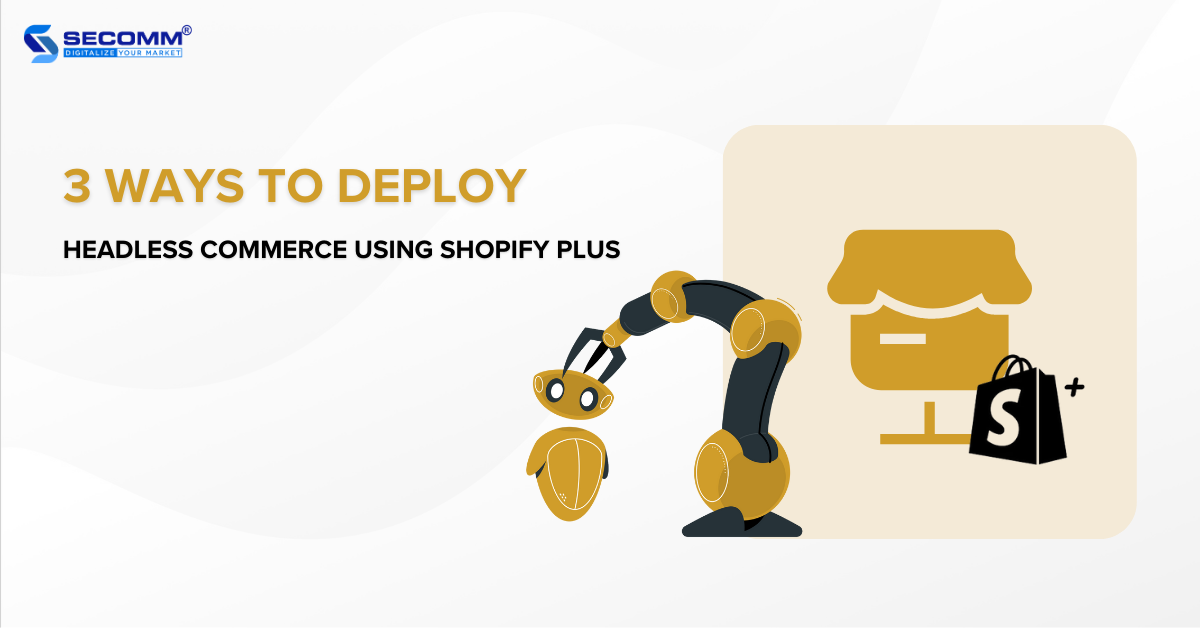
Freedom in creativity and technical flexibility have ushered eCommerce into a new era with the Headless Commerce trend. In this scenario, Shopify Plus shines with its exceptional solutions that have positioned numerous businesses at the forefront of this trend.
Learn more: Brands go Headless with Shopify Plus
The combination of Shopify Plus infrastructure and the Headless architecture opens up various ways for businesses to create unique and customizable shopping experiences for their customers. Below are three common methods for implementing Headless Commerce with Shopify Plus.
The Shopify Storefront API is a GraphQL-based API – a query language for APIs. It enables businesses to connect the frontend of their website to the backend of Shopify, facilitating easy access to data and eCommerce functionalities. Therefore, businesses can use the Storefront API to create unique and personalized customer experiences across various digital channels.
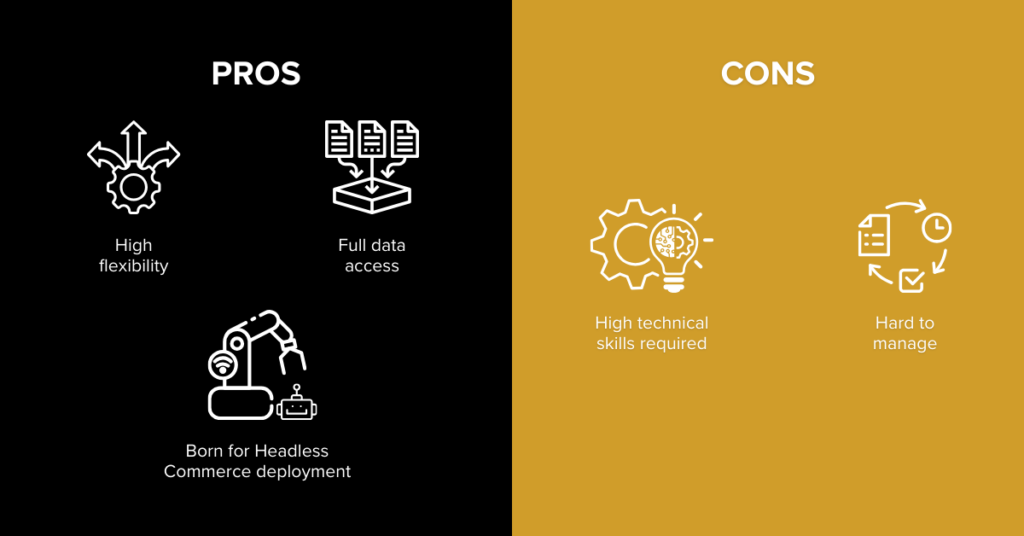
High flexibility: The Storefront API allows you to create independent websites. Instead of adhering to the constraints of pre-built themes, you can flexibly design product pages, homepages, and shopping carts in a style that accurately reflects your brand. The Storefront API also ensures flexibility in integrating with third-party systems while easily adapting the website to embrace new design trends.
Full data access: Through the Storefront API, you can access every aspect of the Shopify Plus database, including detailed information about products, orders, and customer data. This helps manage, monitor, assess trends, and optimize eCommerce data accurately.
Born for Headless Commerce deployment: Embracing the Headless Commerce model, which decouples the frontend and backend, allows for significant flexibility in eCommerce development and operations. The Storefront API is strategically optimized to seamlessly connect Shopify Plus’ backend with diverse frontends, ensuring a cohesive user experience across various channels and devices.
High technical skills required: Deploying Headless Shopify Plus using the Storefront API is a complex process that demands in-depth knowledge of the Shopify Plus platform, programming languages, and frameworks, as well as problem-solving skills to quickly address technical requirements. Particularly, you need to understand the data structure of Shopify, including how customer data, product information, and transactions are organized and stored within the system.
Hard to manage: The flexibility of the Storefront API complicates the process of managing and maintaining the system. While the flexibility of the Storefront API allows to customize every aspect of the eCommerce website, from the homepage to the checkout process, these custom configurations need to be well-managed. When there are too many custom configurations, updates may lead to compatibility issues within the overall system.
The Shopify Hydrogen + Oxygen solution was introduced in 2021, and designed for large enterprises implementing Headless Commerce with Shopify Plus. Specifically, Hydrogen is a React-based framework – a popular framework for building user interfaces, enabling businesses to construct unique and visually appealing storefronts.
On the other hand, Oxygen is a global hosting solution capable of storing custom content. Shopify Oxygen is backed by Shopify’s infrastructure with over 100 server locations positioned worldwide. You don’t need to worry about finding third-party hosting providers or managing technical issues.
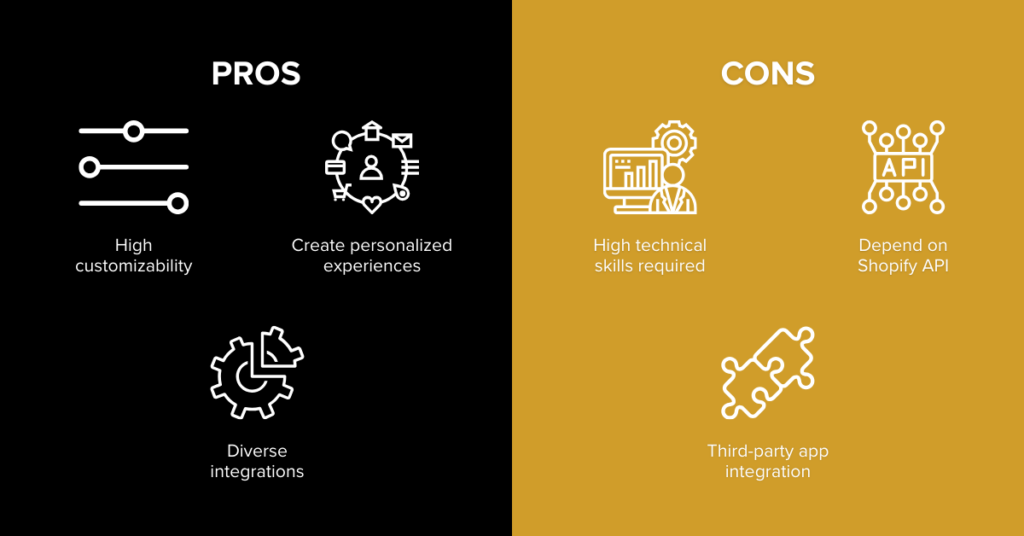
High customizability: Shopify Hydrogen allows you to customize the Headless website interface and implement necessary extensions. This means that merchants can use the latest technologies to build a Headless eCommerce website without worrying about impacting the system’s functionality.
Create personalized experiences: The Shopify Hydrogen solution offers high flexibility and customization, enabling you to implement Headless Commerce with this solution to easily create and deliver personalized shopping experiences for customers.
Diverse integrations: To help you create a seamless omnichannel experience, Shopify provides the capability to integrate the Headless Hydrogen website with various third-party applications such as Klaviyo, Gorgias, etc., as well as Headless CMS systems like Contentful, Sanity, Builder.io, etc.
High technical skills required: Shopify Hydrogen is a technically intensive solution and doesn’t have a drag-and-drop builder. Therefore, the process of implementing Headless Commerce with Shopify Hydrogen will demand a high level of technical expertise from the business.
Depend on Shopify API: This solution is developed exclusively for Shopify’s API. This means that the Hydrogen framework can only be used to build the Shopify website interface.
Third-party app integration: While Shopify allows you to easily integrate with 3rd-party apps and CMS, if you want to use a CMS or app for your online store that isn’t compatible with the Hydrogen framework, you’ll need to integrate it through a middleware app.
The third method to adopt Headless Commerce with Shopify Plus is by using Shopify’s latest solution – Commerce Components. This is a modular component tech stack developed by Shopify specifically for large enterprises aiming to build Headless eCommerce websites. Shopify Commerce Components offer 30 components, encompassing core features across various business aspects such as Cart, Checkout, Data, Shipping, and more.
You can integrate these components based on deployment needs to create a customized solution for your Headless Shopify website. Since its launch, many world-leading businesses, including Mattel, JB Hifi, Glossier, Coty, Steve Madden, Spanx, and Staples, have utilized this new tech stack from Shopify.
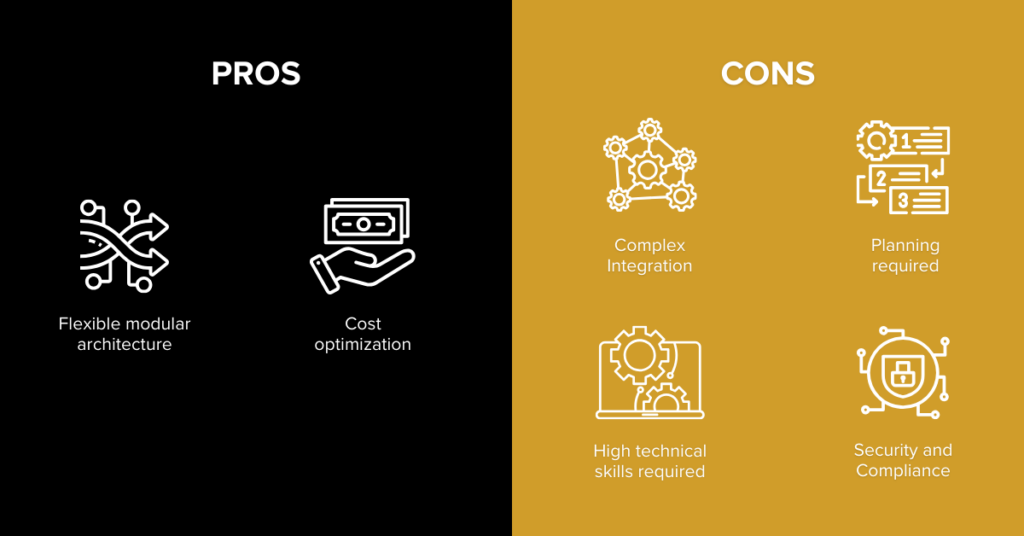
Flexible modular architecture: Commerce Components with a modular architecture provide unlimited API connections. This means you can integrate and use an unlimited number of components, while also easily adding, removing, and customizing these components without fear of affecting the system.
Cost optimization: Commerce Components have a pricing model based on the number of components used, meaning businesses pay for exactly what they use. Additionally, the cost of Commerce Components is billed annually, making it easier for businesses to accurately predict the fees they will incur.
Complex Integration: The process of integrating multiple components can be complex and time-consuming. Businesses need to ensure that the components operate independently and seamlessly within the same system efficiently.
Planning required: To ensure the effective operation of the components on the system, you need to meticulously plan which eCommerce components will be integrated, choose suppliers, deployment solutions, and deployment stages.
High technical skills required: Building and maintaining a Headless website system using the Commerce Components solution will demand a certain level of technical expertise and knowledge of integration and technology. You can invest in developing an in-house technical team or collaborate with highly specialized agencies.
Security and Compliance: Each provider for each eCommerce component will have its security protocols and compliance rules. You must ensure compliance with these rules when integrating their components, while also ensuring that this compliance doesn’t impact the operation of the remaining components and the entire system.
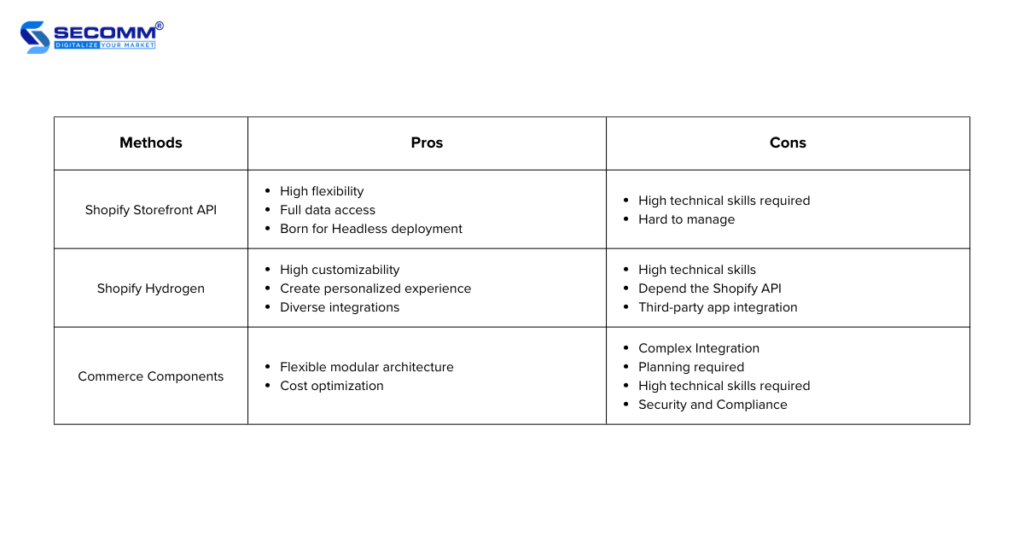
Choose your best-fit Headless Commerce deployment!
On the journey of building a Headless eCommerce website with Shopify Plus, choosing the deployment method is a crucial decision to ensure system flexibility and performance while providing the optimal customer experience.
If you need detailed guidance or want to explore how Shopify Plus can support your Headless deployment strategy, please contact SECOMM or call directly at (+84)28 7108 9908 to receive advice and assistance from our experts in choosing the right Headless Shopify Plus deployment method for the business model and goals.
 2
2
 3,102
3,102
 0
0
 1
1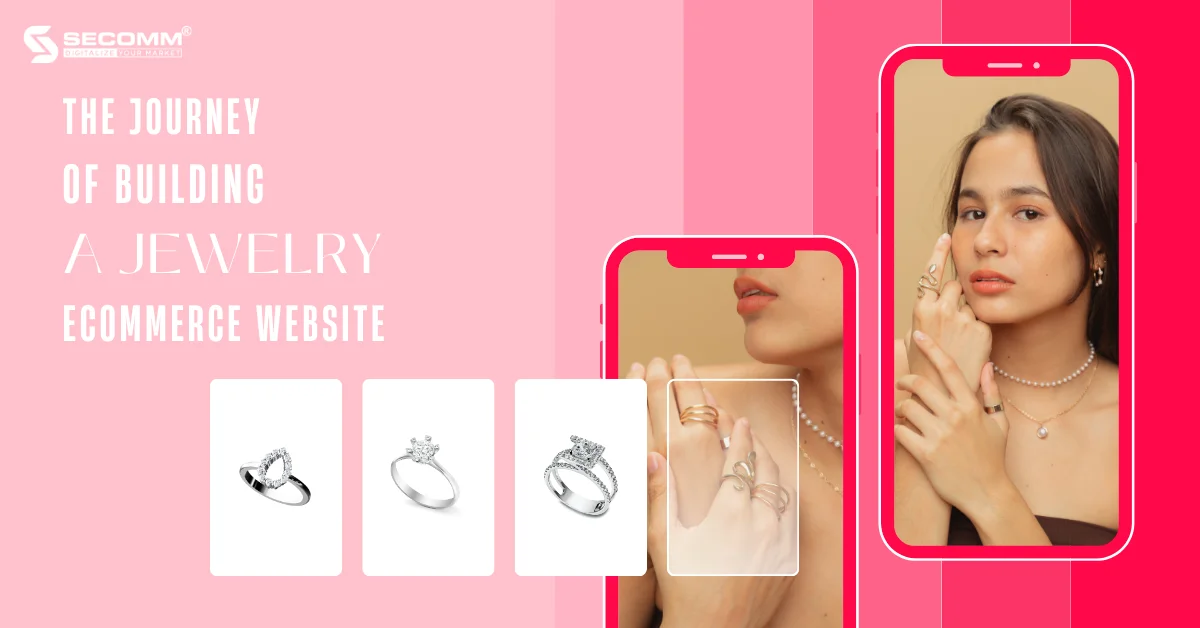
According to Grand View Research, the global jewelry eCommerce market is predicted to reach USD 117.8 billion by 2027, with a CAGR of 12.2% from 2022 to 2027. According to Research and Markets, the United States is the largest jewelry eCommerce market in the world, with expected revenue of USD 45.6 billion by 2027. Other regions, including China, India, and Southeast Asia, are also experiencing rapid growth.
Several jewelry brands have successfully implemented eCommerce early on and achieved unexpected success, such as Cartier, Tiffany & Co., PNJ, ANA LUISA, Missoma, etc. The common characteristic of these brands lies in comprehensive eCommerce websites that cater to customers’ needs for purchasing jewelry and gemstones.
For more information:
With nearly 10 years of experience in eCommerce, SECOMM has outlined the common journey of building jewelry eCommerce websites in Vietnamese businesses.
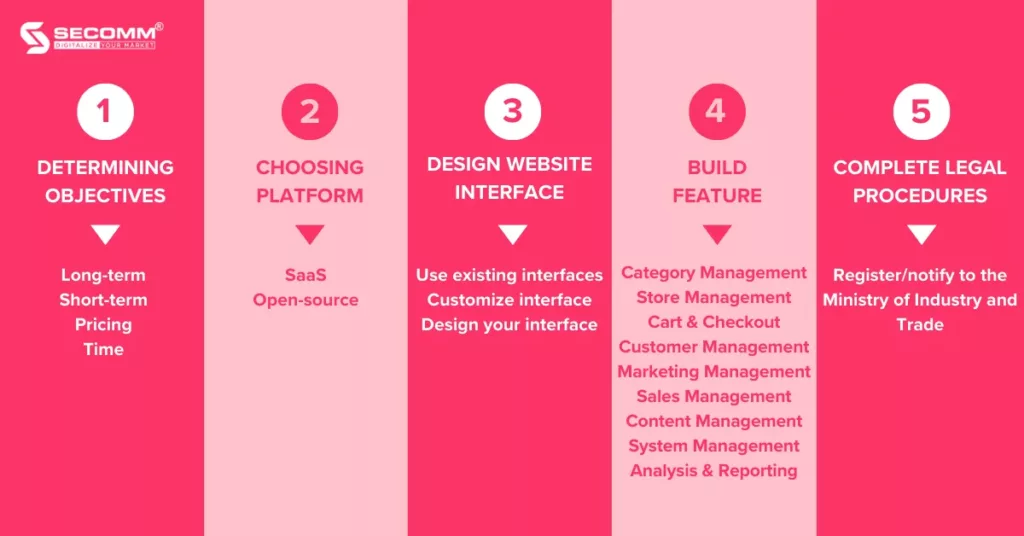
Firstly, businesses in the jewelry industry need to clearly define their goals and prioritize each of these goals when planning the development of an eCommerce website.
In the long-term vision, businesses may be interested in building and strengthening their brand presence in the online market, exploring the potential of online customers, and optimizing business operations from online to offline.
For short-term objectives, businesses may prioritize monitoring and analyzing customer behaviour on the website, assessing the effectiveness of online marketing campaigns to improve sales performance.
When setting objectives, the timeframe is also a crucial factor. Businesses may choose to deploy quickly to penetrate the eCommerce market or even opt for a gradual deployment to have time for testing, evaluation, and adaptation to this large and competitive market.
Currently, two popular types of platforms support the development of eCommerce websites: SaaS (Software as a Service) and open source.
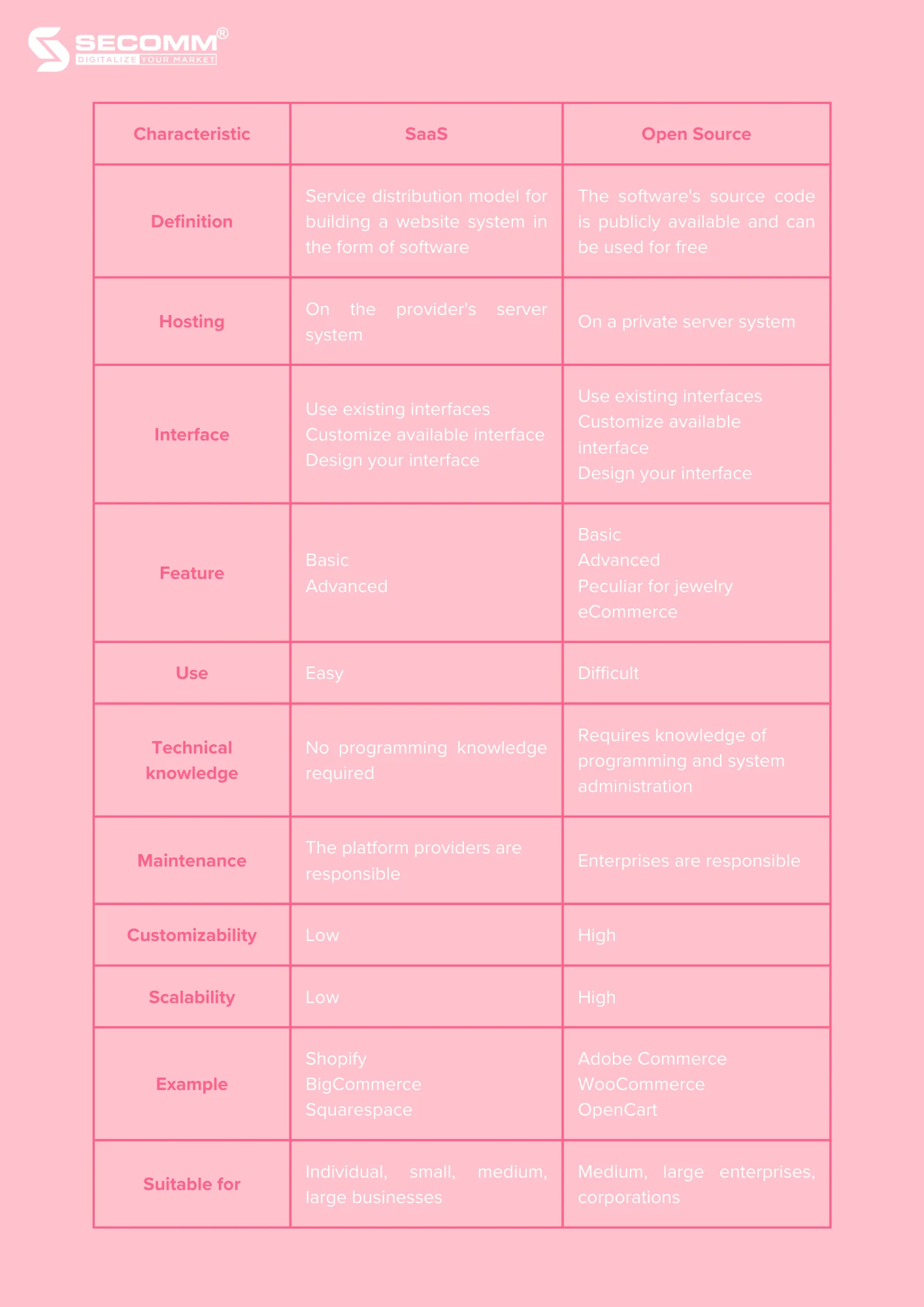
Read more:
Typically, new businesses entering the eCommerce market will choose SaaS platforms to save time and costs during the initial stage of building an eCommerce website. Subsequently, businesses may transition to open-source platforms for the development of more advanced eCommerce websites.
However, businesses can also choose an open-source platform right from the start to build a basic eCommerce website and later upgrade the system over time on the same platform to avoid the need for platform migration in later stages.
When designing the website interface, businesses need to meet basic criteria such as UI/UX standards, reflecting the brand’s characteristics, presenting products consistently, providing complete usage instructions, etc.
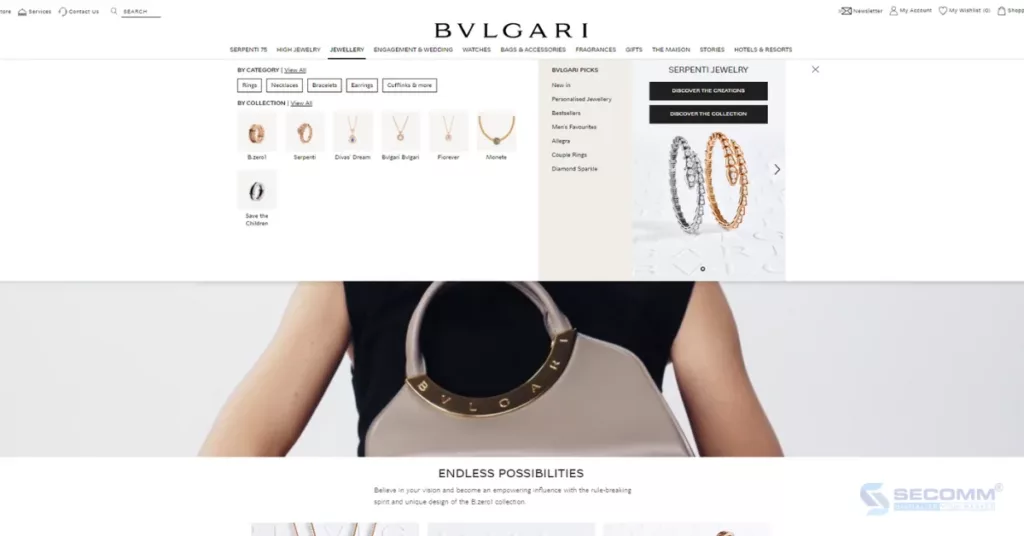
Currently, there are three ways to design the interface, including:
In this stage, businesses often choose ready-made themes to save costs, but some financially stronger businesses may opt for the other two methods to better position their brand.
In this stage, businesses can prioritize the development of basic functions to meet the most fundamental needs when operating a jewelry eCommerce website. Some essential functions that should be included in a jewelry eCommerce website are:
After successfully completing the features, testing, and launching of the website, the business needs to fulfil legal procedures related to eCommerce operations. According to Decree 52/2013/ND-CP issued by the Government of Vietnam, individuals or organizations owning eCommerce websites for sales are required to notify or register with the Ministry of Industry and Trade through the Public Service Portal of the Ministry of Industry and Trade.
Note: Websites that operate for an extended period or fail to register/notify the competent management authority within the specified time frame may be subject to administrative penalties as stipulated by the regulations.
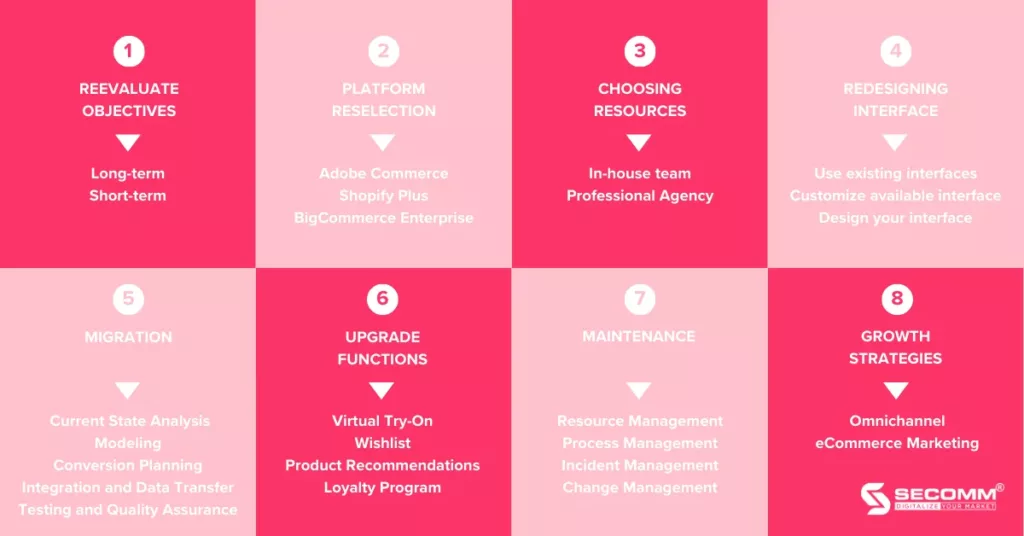
When a business is in the development phase and the market is undergoing significant changes, adjusting objectives becomes necessary. This is particularly crucial when leadership needs to review the business strategy and make decisions regarding investing in an eCommerce website, including both time and budget considerations.
In this phase, businesses often focus on setting short-term and long-term goals for the online jewelry business system. For long-term objectives, businesses may consider expanding the brand presence in the market, building a loyal customer program, and promoting the purchasing habits of jewelry and gemstone customers in the middle and upper classes. These goals lay the foundation for sustainable development and prosperity in the future.
Regarding short-term goals, businesses may concentrate on attracting additional potential customers, increasing revenue, and supporting the eCommerce marketing strategy. Tools such as Influencer Marketing may be prioritized to drive rapid growth and create immediate business opportunities.
Overall, establishing specific goals and adjusting them based on market conditions and business development is a crucial part of managing and succeeding in the eCommerce jewelry industry.
When basic SaaS platforms are no longer sufficient to support the expansion of the website system, businesses will need to transition to more specialized platforms such as Adobe Commerce, Shopify Plus, BigCommerce Enterprise to develop a more advanced eCommerce jewelry website.

Read more:
Of course, when switching platforms, businesses will face challenges such as conversion costs, time required for staff training on the new platform, and potential data loss during the platform migration.
To build a professional and complex eCommerce website, businesses need to choose suitable resources to implement the project. Generally, there are two main options: building an in-house team or partnering with a professional development partner. Regardless of the choice, specialized knowledge and experience in the chosen field are crucial.
When deciding to build an in-house team, businesses need to recruit and train IT and eCommerce personnel with knowledge and practical experience on the chosen platform. This may require a significant amount of time and financial resources to build a suitable workforce. However, this approach allows the business to have better control over resources and the ability to make adjustments, developing the website system according to specific requirements.
Another option is to collaborate with a professional development partner. In this case, businesses should seek a partner with extensive experience in eCommerce, a professional team, clear work processes, and the ability to handle complex projects. Collaborating with specialized units helps businesses learn and accumulate more experience while developing an eCommerce website that suits the specific characteristics of the jewelry industry.
Therefore, the choice between building an in-house resource and collaborating with a development partner depends on the goals, resources, and specific requirements of the business.
During the platform transition process, businesses may decide to keep the current website interface if the brand believes it still aligns with the strategy and the new platform. However, many businesses often choose to redesign the interface to ensure that the eCommerce website reflects the brand’s business strategy and the new platform accurately.
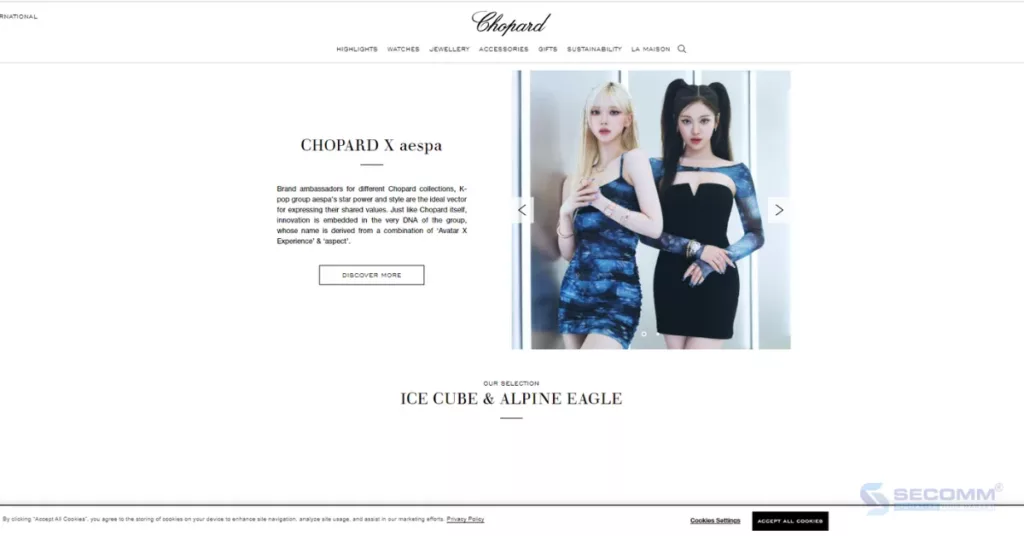
Similar to the previous stage, businesses have several options when designing the eCommerce website interface: using ready-made themes available on the market, customizing themes, and designing a unique interface.
In the jewelry industry, customizing or designing a unique interface is often prioritized to showcase the uniqueness and sophistication of the products. However, the final decision should be based on the business strategy and resources available.
After choosing a suitable conversion platform, the redesign of the system and platform conversion is crucial. This requires a high level of expertise from solution architects to design a system that can address the challenges the business is facing and align with the long-term development journey and business model of the enterprise.
In addition, the process of migrating data also needs to be carried out carefully to limit the risk of data loss or errors for the business. Typically, data conversion is automated as much as possible to avoid potential errors.
The platform conversion process includes the following steps:
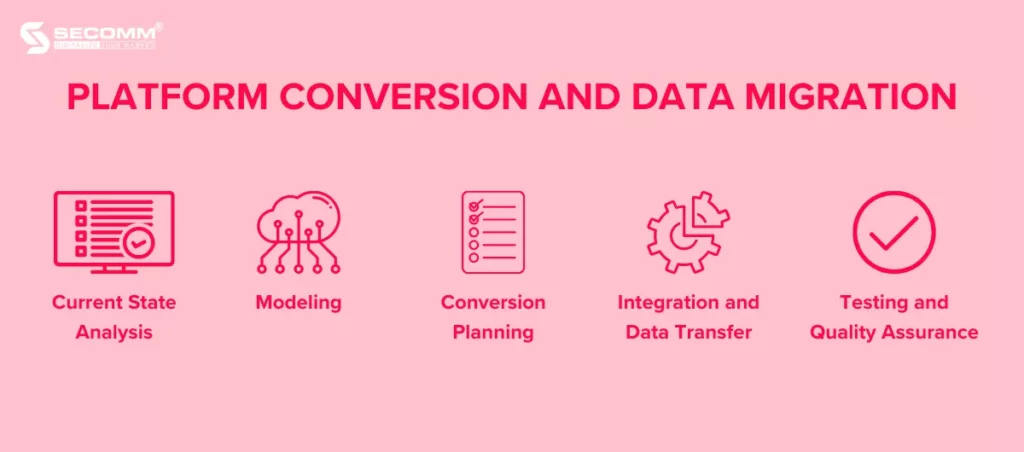
In addition to basic functions, at this stage, businesses should focus on building more sophisticated system functions, including advanced and industry-specific features for the jewelry sector.
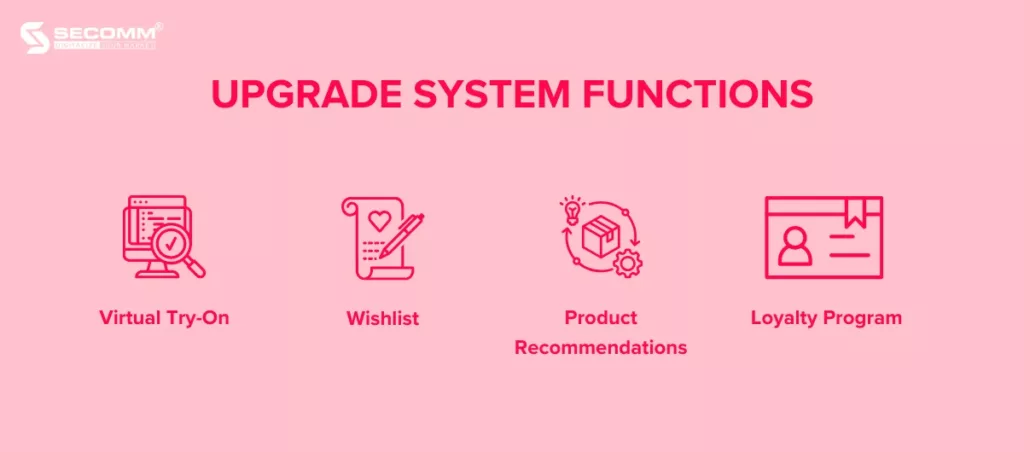
Furthermore, businesses need to continuously innovate and update to develop user-friendly functions and keep up with market trends.
Operating an eCommerce system is an ongoing process that businesses must carry out to ensure the system operates smoothly and efficiently. This process includes the following crucial tasks:
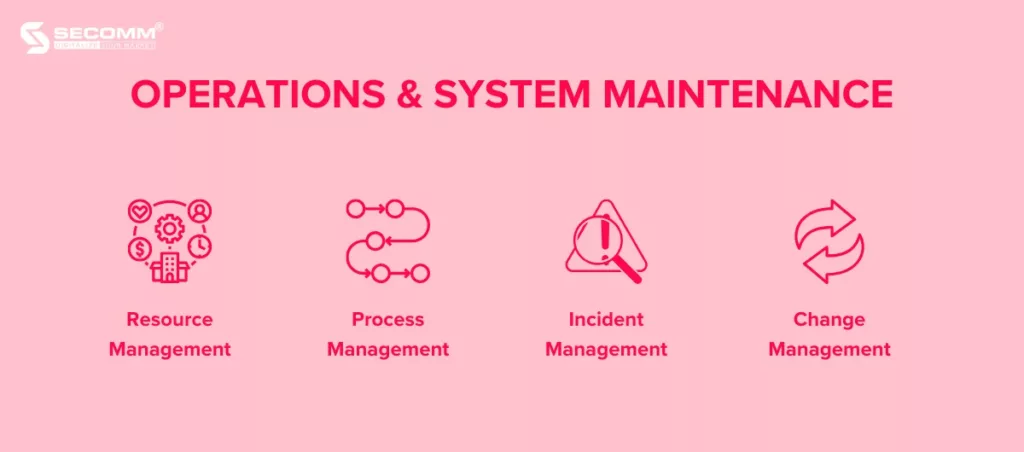
Additionally, continuous care, maintenance, updates, and upgrades of the website system are essential for businesses to sustain sustainable growth and adapt quickly to changes in the eCommerce market, especially in the jewelry and gemstone product sector.
After a period of operation, businesses should shift their focus to eCommerce marketing strategies or omnichannel strategies to boost the sales of jewelry products.
Implementing omnichannel involves setting up a seamless sales, marketing, and management system through various channels such as the website, social media platforms (Facebook, Instagram, Zalo, TikTok Shop), and eCommerce platforms (Shopee, Tiki, Lazada, Sendo) to optimize the customer experience and enhance business efficiency.
Developing a comprehensive marketing strategy and plan based on key eCommerce marketing channels such as Content Marketing, SEO/SEM, Email Marketing, and Affiliate Marketing is essential for rapid business growth.
In conclusion, the journey of building an eCommerce website for the jewelry market in Vietnam is not an easy one. This journey requires businesses to invest a significant amount of time and budget to research the most suitable eCommerce strategy for each stage of their development.
Understanding the difficulties and challenges that businesses face when building an eCommerce jewelry website, SECOMM is ready to provide free consultations and detailed solutions for the development of an eCommerce system tailored to the specific needs of each business.
Contact SECOMM today or call directly at the hotline (028 7108 9908) for a free and detailed consultation.
 2
2
 8,628
8,628
 0
0
 1
1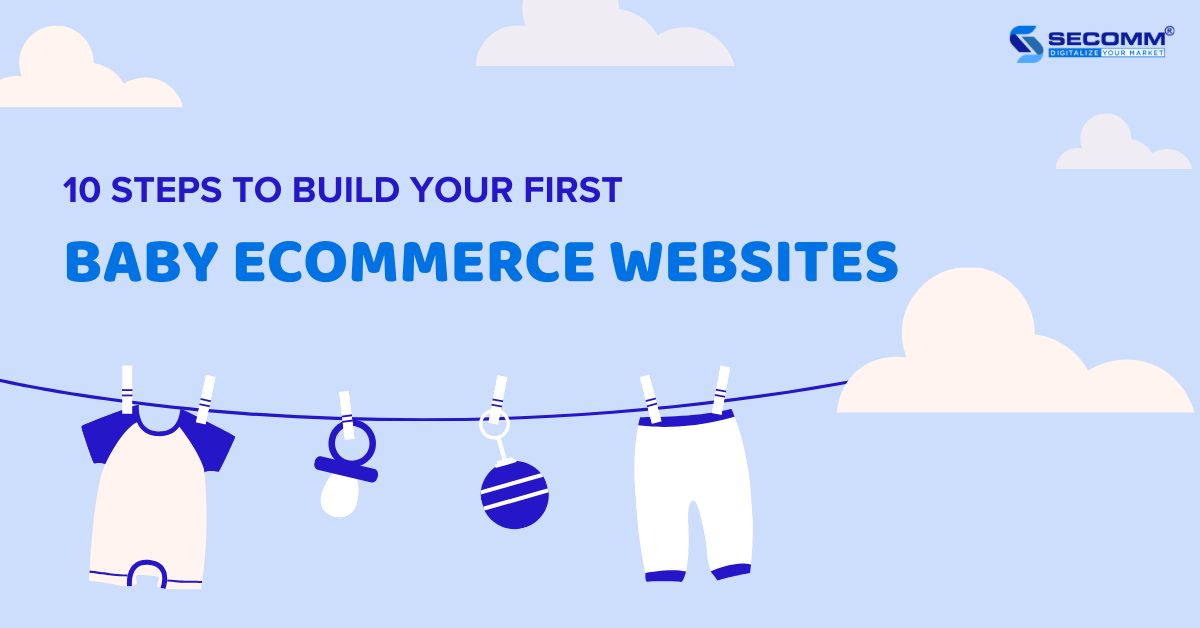
Baby eCommerce is a promising market experiencing a steady annual growth rate (CAGR 2023-2027) of 9.86%, projected to reach a market value of approximately USD 129.40 billion by 2027.
To tap into this market, you’ll need to develop a professional and efficient eCommerce website. Here are 10 steps to create an eCommerce website tailored for maternity and baby products.
The first step is to identify your business goals and prioritize them, forming a plan tailored to develop an effective Baby eCommerce website.
Concerning long-term goals, you may focus on objectives like establishing a strong brand presence, reaching potential customers, and enhancing the efficiency of both online and offline operations.
For short-term goals, businesses can give priority to activities like monitoring, analyzing customer behavior, assessing the effectiveness of marketing campaigns, and boosting revenue.
When it comes to timeline, you can decide to deploy quickly to enter the market or proceed gradually to test and adapt to this eCommerce world.
As for the budget, it depends on your business strategy and financial capacity for this Baby eCommerce development project.
Currently, there are two types of eCommerce platforms to help you build your first Baby website: SaaS (Software as a Service) and Open-Source platform.
Some popular SaaS eCommerce platforms include Shopify, BigCommerce, Squarespace, and Wix.
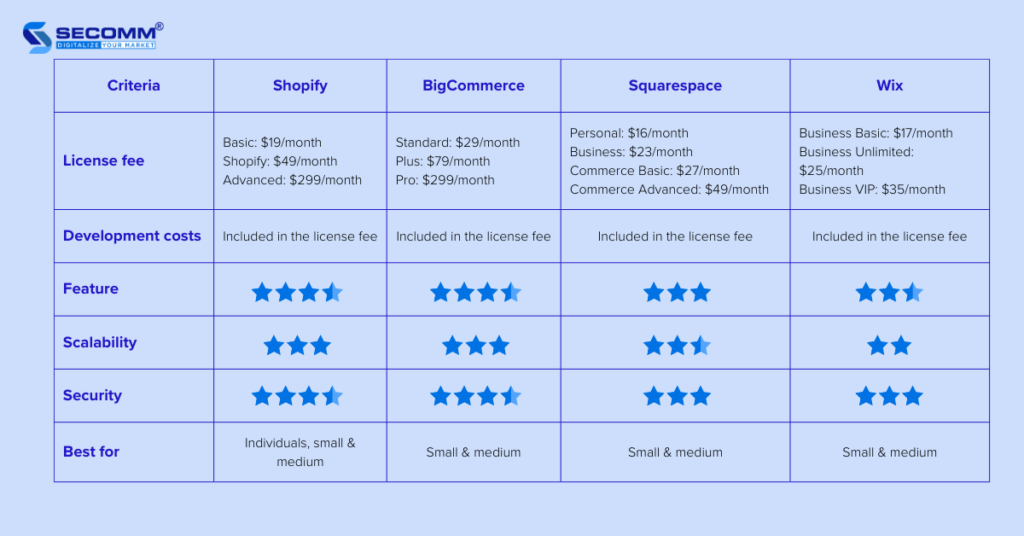
In addition, there are premium versions of these SaaS platforms such as Shopify Plus, BigCommerce Enterprise, and Goflow.

Some open-source platforms are widely used: Adobe Commerce (Magento), WooCommerce, OpenCart, and PrestaShop.
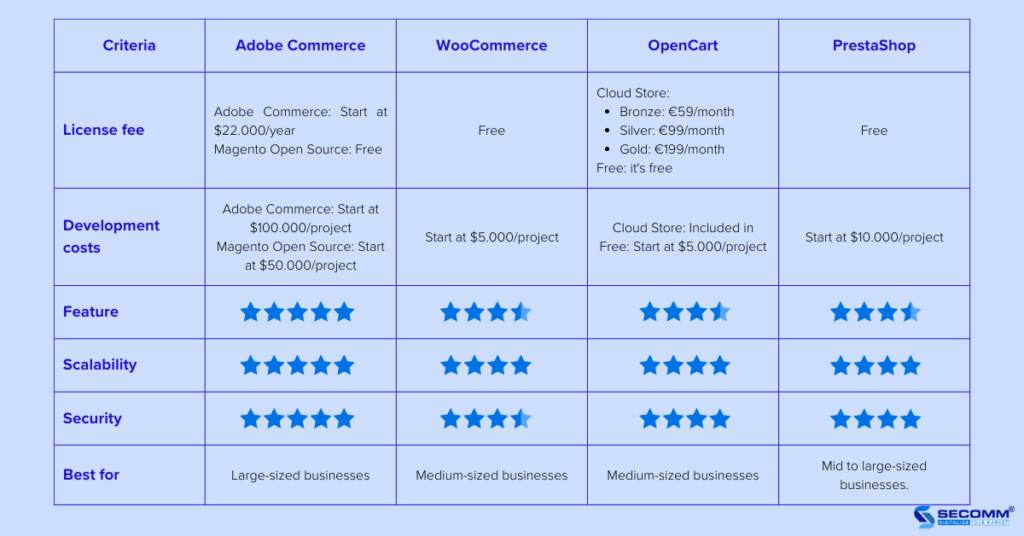
Typically, some new businesses choose basic SaaS platforms to save time and budget in the initial phase of the Baby eCommerce website development. After a while, they may switch to a premium SaaS or an open-source platform to develop their baby websites more advanced.
In another case, some businesses opt for open-source platforms to build a basic eCommerce website and then gradually upgrade the system over time to minimize the need for platform switching in later phases.
Typically, most eCommerce businesses decide to initially partner with a professional development agency and gradually build their in-house team.
For establishing an in-house team, you’ll need to recruit and train IT and eCommerce professionals for expertise on the chosen platform. It’ll take you significant time and budget but allow you to have full control over your resources. You can develop and adjust your Baby eCommerce website according to your needs and wants.
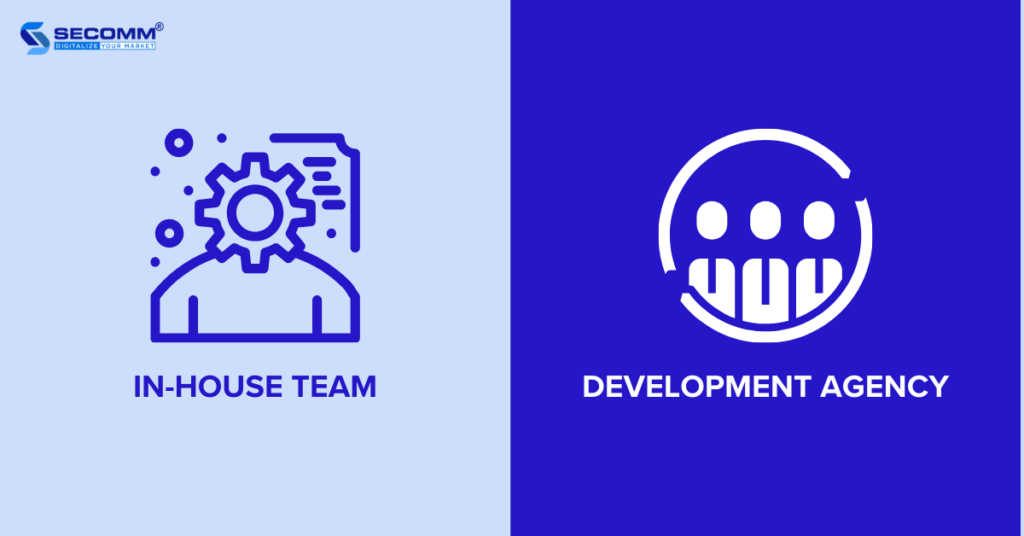
When it comes to partnering with an agency, here are some criteria you need to evaluate:
Partnering with a professional development agency gains you specialized eCommerce knowledge, enhances your technical skills, and above all, you’ll facilitate the eCommerce website exactly what you need, tailoring it to the unique features of the maternity and baby industry.
When it comes to UI/UX design, it’s important to showcase the brand image, products, user guide, etc. There are three popular ways to make your design:
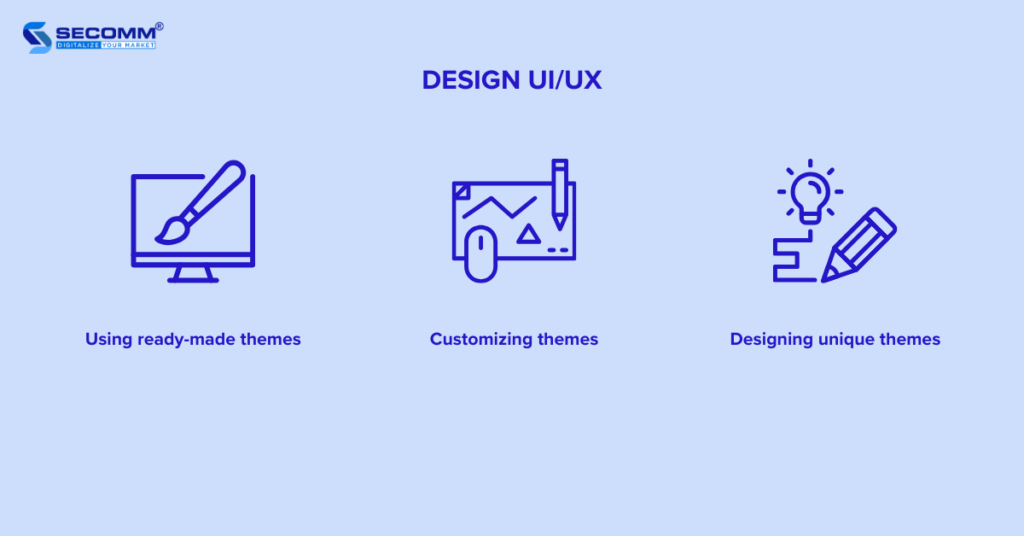
Some essential features that a Baby eCommerce website should have include
Some advanced features for the baby eCommerce industry:
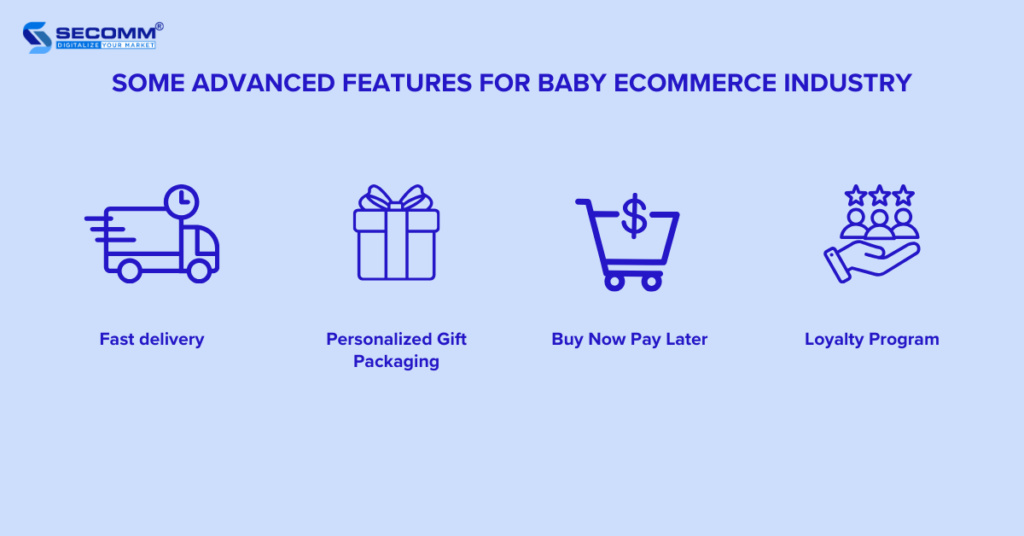
After developing features and ensuring a successful testing and website launch, you’ll need to complete the legal procedures associated with eCommerce operations.
According to Decree 52/2013/ND-CP by the Government of Vietnam, any individual or organization owning an eCommerce website for sales is required to notify or register with the Ministry of Industry and Trade through the online public service portal of the Ministry of Industry and Trade.
Note: Websites that operate beyond the specified period or fail to register/notify the authorized management agency within the designated timeframe may be subject to administrative penalties as per regulations.
When QC/testing your eCommerce website, you can leverage either the Waterfall or Agile model to test the entire system.
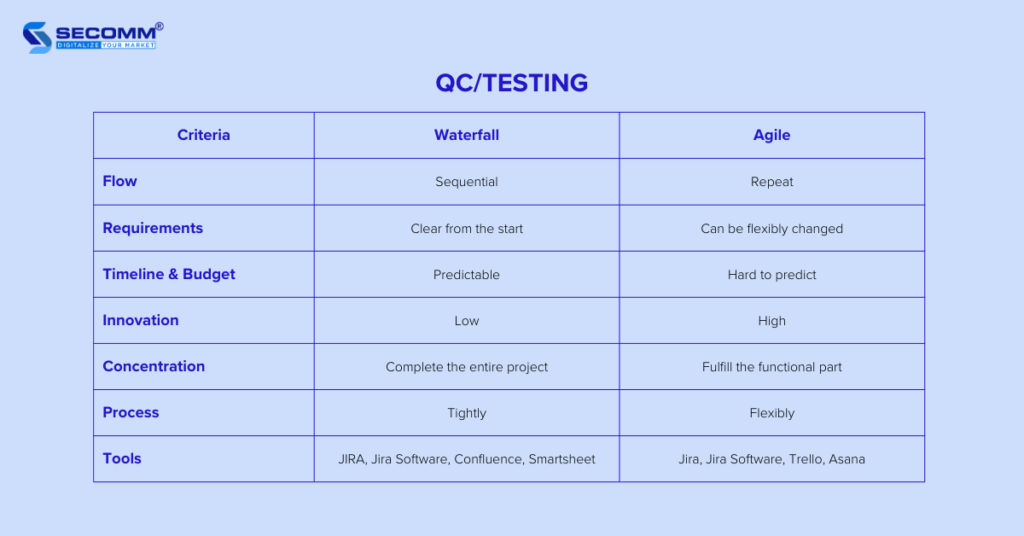
Using these models helps you review and test your entire eCommerce system, functions, and features within a specified timeframe, ensuring optimal order processing speed and overall website stability. In case of any issues, your in-house team or development partner will help you to address them before officially going live.
When the QC/testing process is done, your baby eCommerce website is ready to launch. To ensure a smooth go-live process, here are three steps you should prepare:
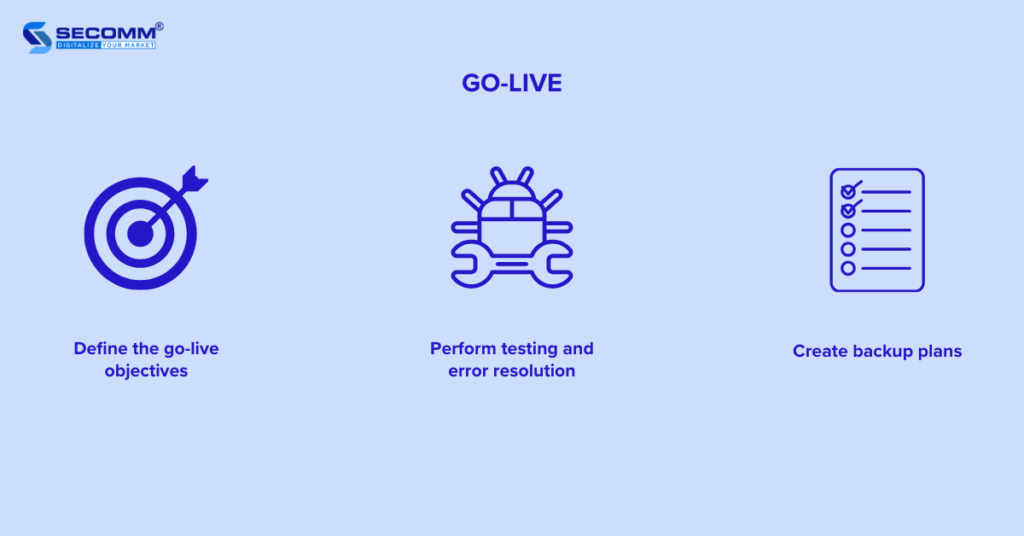
Running a baby website is an ongoing effort aimed at ensuring the steady and effective functioning of the system. This involves various activities, including:
Furthermore, you should regularly maintain, update, and upgrade the website system to achieve sustainable growth, adapting quickly to shifts in the eCommerce world or the maternity and baby products market.
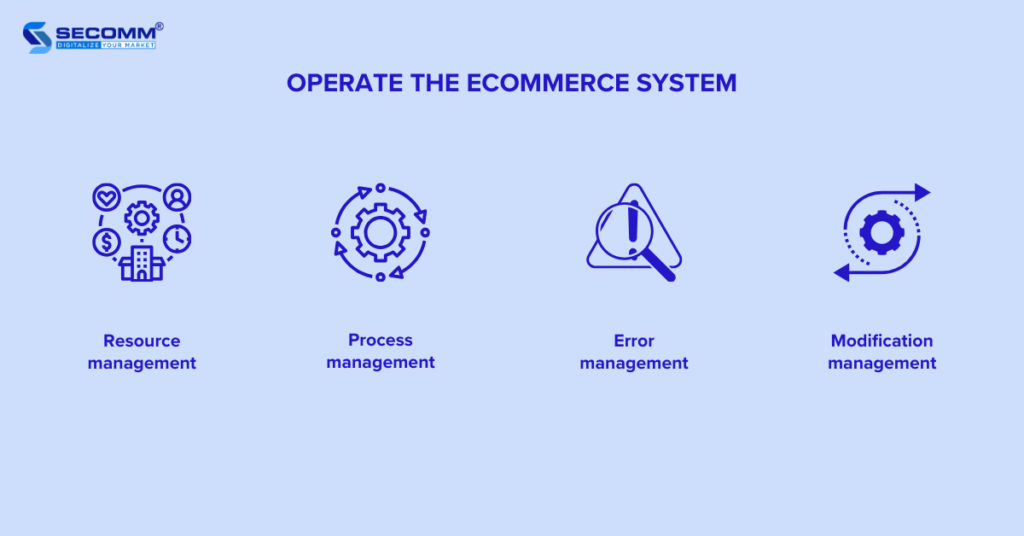
After a period of operation, you should shift your focus toward eCommerce marketing strategies or Omnichannel to expand your online presence in the market of maternity and baby products
businesses should redirect their focus toward implementing eCommerce marketing strategies or embracing Omnichannel approaches to expand their online presence in the market of mother and baby products.
Implementing Omnichannel involves setting up a seamless sales, marketing, and management system across channels such as the website, social media platforms (Facebook, Instagram, Zalo, TikTok Shop), and online marketplaces (Shopee, Tiki, Lazada, Sendo) to optimize the customer experience and boost business efficiency.
Developing a comprehensive marketing strategy, centered around key eCommerce marketing channels like Content Marketing, SEO/SEM, Email Marketing, and Affiliate Marketing, becomes crucial for achieving rapid sales growth.
The Bottom Line
In general, the journey of building a baby eCommerce website for the Vietnamese market isn’t an easy task. It requires you to invest a significant amount of time and budget in researching the most fitting strategies tailored to each phase of your eCommerce development.
Understanding the difficulties and challenges that businesses may encounter when building a baby eCommerce website, SECOMM is ready to provide free consultation on detailed eCommerce solutions.
Reach out or call the SECOMM hotline at 028 7108 9908 to get started!
 2
2
 6,052
6,052
 0
0
 1
1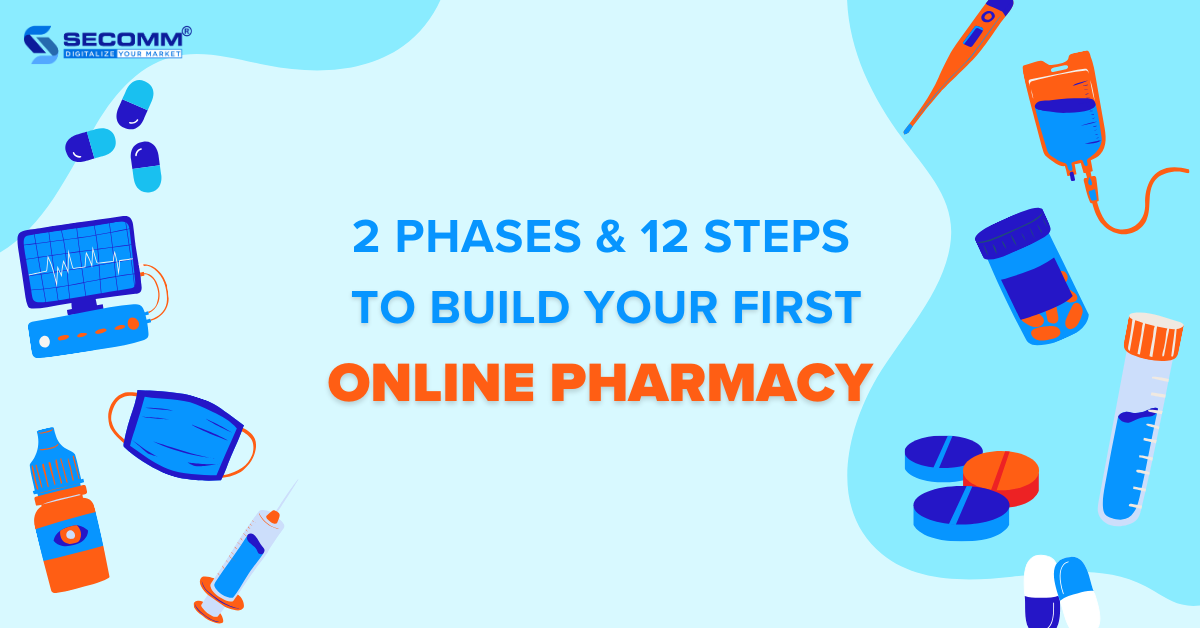
Since the advent of the COVID-19 pandemic, the pharmaceutical industry has proven the potential of transitioning from offline to online pharmacy. In the United States, the number of remote health consultations surged by 2,600% in March 2020 (during the peak of COVID-19 in the U.S.) compared to the same month in 2019. According to Statista, the global pharmaceutical eCommerce sector is projected to reach 32 billion USD by the end of 2023.
Several brands have successfully embraced eCommerce early on, achieving unexpected successes. Examples include Apollo Pharmacy (India), FPT Long Châu (Vietnam), CVS Health (USA), and Droga Raia (Brazil). The common thread among these brands lies in their comprehensive eCommerce platforms, catering to the shopping needs of customers for healthcare, pharmaceutical, and medical products.
With nearly 10 years of experience in the eCommerce sector, SECOMM has outlined the journey of building pharmaceutical eCommerce websites for the Vietnamese market.
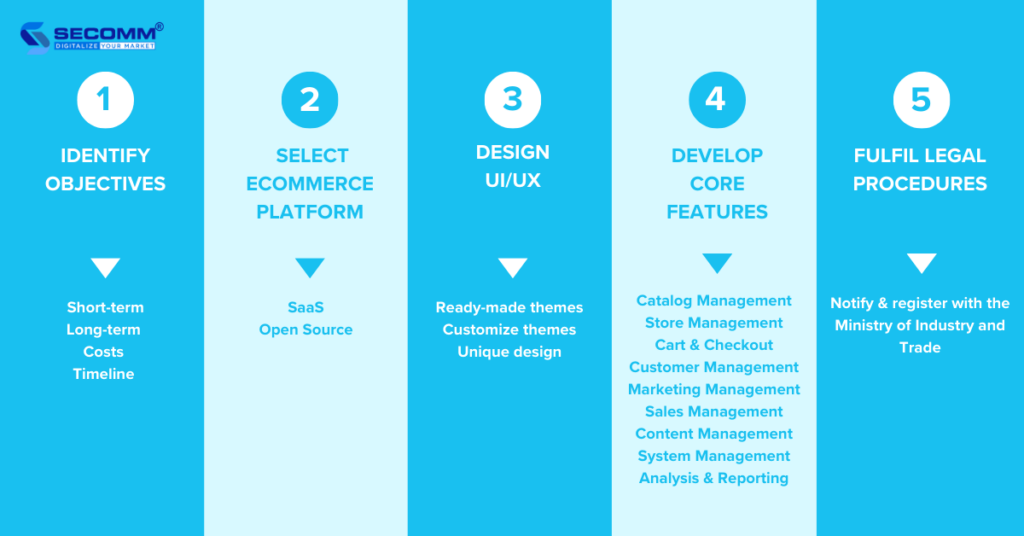
The first thing to do is identify and prioritize goals to plan the pharmacy eCommerce website development for each phase.
In the long run, businesses can consider goals like branding, generating potential customers, and optimizing online and offline operations.
For short-term goals, businesses should prioritize objectives like monitoring and analyzing customer behavior, evaluating marketing campaigns, and revenue growth.
In the first phase, businesses can decide to deploy quickly to enter the market or proceed gradually to test and adapt to this eCommerce world.
There are two types of platforms to help businesses facilitate pharmacy eCommerce websites: SaaS (Software as a Service) and open source.
Some popular SaaS eCommerce platforms include
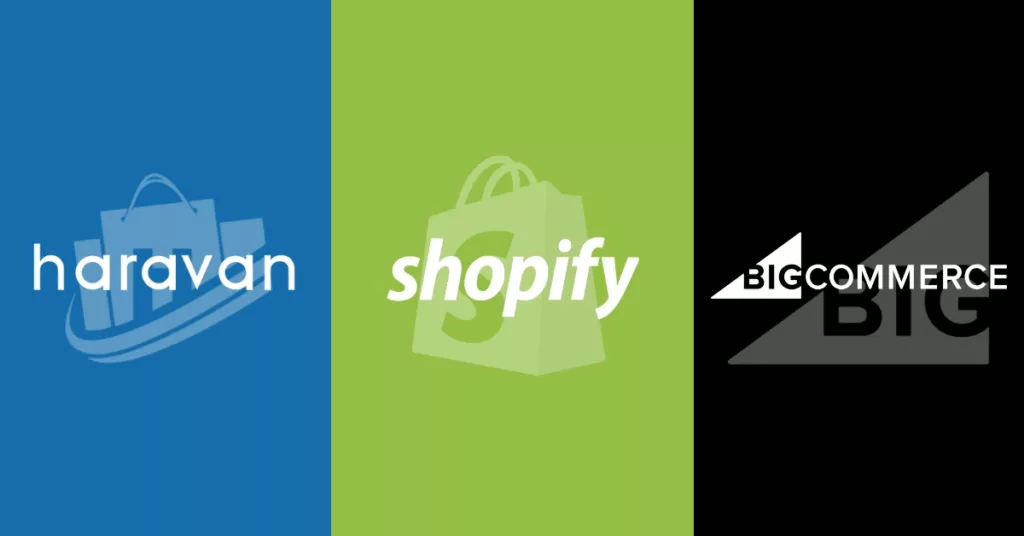
Some outstanding open-source eCommerce platforms include
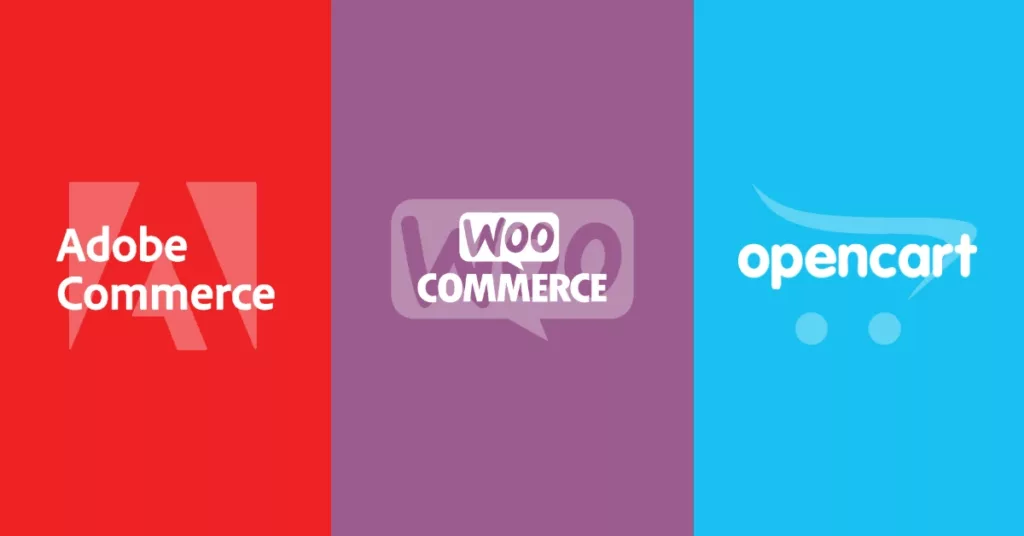
Typically, new eCommerce businesses will choose SaaS platforms to save time and budget in the initial phase of building a basic eCommerce website or an online pharmacy. Then, businesses will re-platform to an open-source platform to develop more advanced eCommerce systems.
However, some businesses decide to build their eCommerce websites in the basic phase on an open-source platform and then upgrade the system over time to remove the re-platforming step in the later phase.
When designing the interface, businesses need to meet basic criteria such as UI/UX standards, showcasing the brand’s characteristics, maintaining consistent product presentation, providing sufficient user guidance, etc.
When it comes to UI/UX design, it’s important to showcase the brand image, products, user guide, etc.
There are three ways to design UI/UX:
In this phase, businesses often choose ready-made themes to minimize costs, but some financially robust businesses may opt for the other two methods to better position their brand.
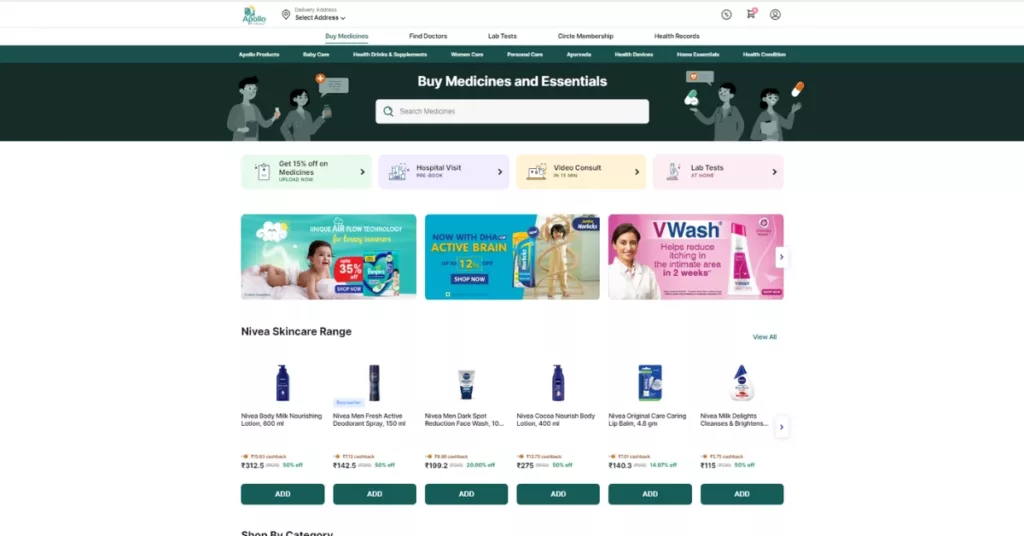
In the basic development phase, businesses should prioritize developing core features for an online pharmacy.
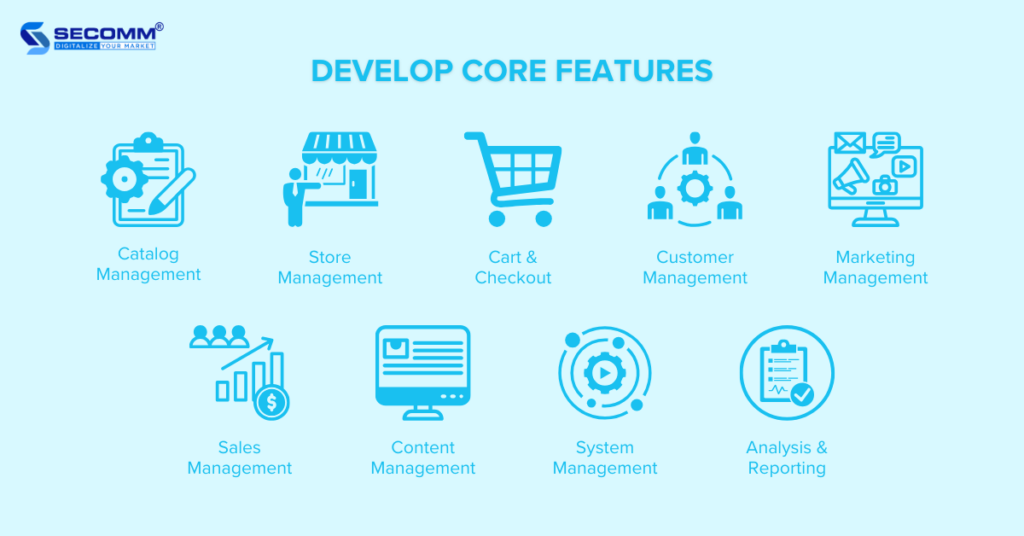
Some essential features that a pharmacy eCommerce website should have include
After developing features and ensuring a successful testing and website launch, businesses are obligated to complete the legal procedures associated with eCommerce operations.
According to Decree 52/2013/ND-CP by the Government of Vietnam, any individual or organization owning an e-commerce website for sales is required to notify or register with the Ministry of Industry and Trade through the online public service portal of the Ministry of Industry and Trade.
Note: Websites that operate beyond the specified period or fail to register/notify the authorized management agency within the designated timeframe may be subject to administrative penalties as per regulations.
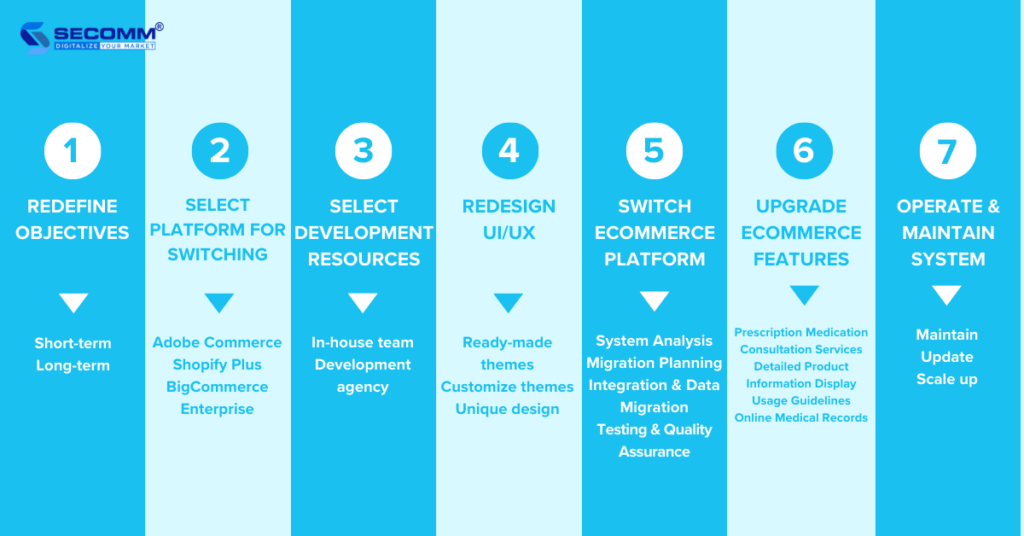
In the process of business development and amidst significant market changes, it’s important to realign goals to suit the evolving landscape. This time for business leaders to redefine objectives regarding the overall strategy, timeline, and budget for investing in the pharmacy eCommerce website.
During this phase, businesses often focus on short-term and long-term goals related to expanding the online pharmacy
For long-term goals, businesses may consider goals such as expanding market segments, establishing a loyalty program, and cultivating shopping habits for healthcare products, pharmaceuticals, and medical equipment.
For long-term goals, businesses may prioritize goals related to tapping into new potential customers, revenue growth, and supporting eCommerce marketing strategies such as livestreaming, gamification, affiliate marketing, and influencer marketing.
When SaaS platforms can’t support businesses to expand the system anymore, re-platforming to another robust platform is a top choice. Platforms like Adobe Commerce, Shopify Plus, and BigCommerce Enterprise can help businesses facilitate a deeply custom pharmacy eCommerce website.

When re-platforming, businesses have challenges such as switching costs, time to train personnel, and data loss throughout the platform migration process.
To build a high-complexity online pharmacy on a professional platform, businesses need resources to facilitate it effectively.
Businesses can decide to build an in-house team or seek a development agency. Regardless of the choice, it requires businesses to have practical experience on the selected platform.
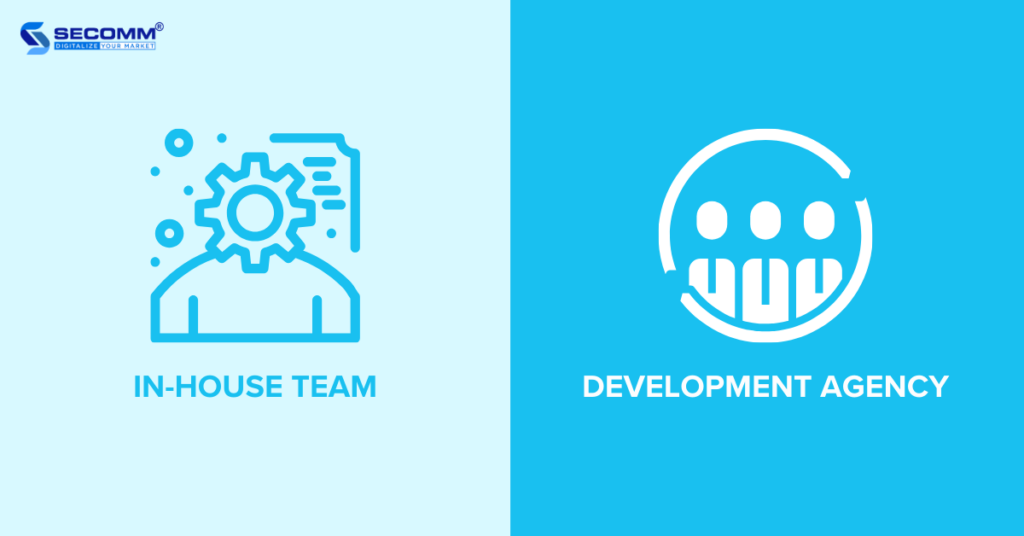
For building an in-house team, businesses need to recruit and train IT and eCommerce personnel to develop on the selected platform. This option may take time and budget to establish a high-performing team but it allows the business to have better control over resources and actively adjust or develop the website system.
In case businesses hire a development agency, here are some criteria to consider:
Partnering with a professional development agency will help businesses gain specialized knowledge, enhance experience, and create an online pharmacy tailored to the specific needs of the industry.
During the platform migration process, businesses can keep the current website design without making any changes. However, some businesses tend to redesign their websites to align with new strategies and the new platform.
Similar to the previous phase, businesses have three options to design their pharmacy eCommerce websites: using ready-made themes, customizing themes, or designing a unique interface.
However, in phase 2, businesses often decide to customize themes or design a unique interface to express the brand image and the pharmaceutical eCommerce industry.
After the right eCommerce platform for migrating, businesses should carry out the process to minimize the risk of data loss or errors. Typically, the migration process is automated as much as possible to avoid potential issues.
The migration process includes the following steps:
After re-platforming, the business needs to perform thorough checks to ensure that the data has been migrated completely and accurately according to the plan.
Beyond core features, businesses should focus on building a system with more complex features, including advanced and industry-specific functionalities for pharmaceutical eCommerce.
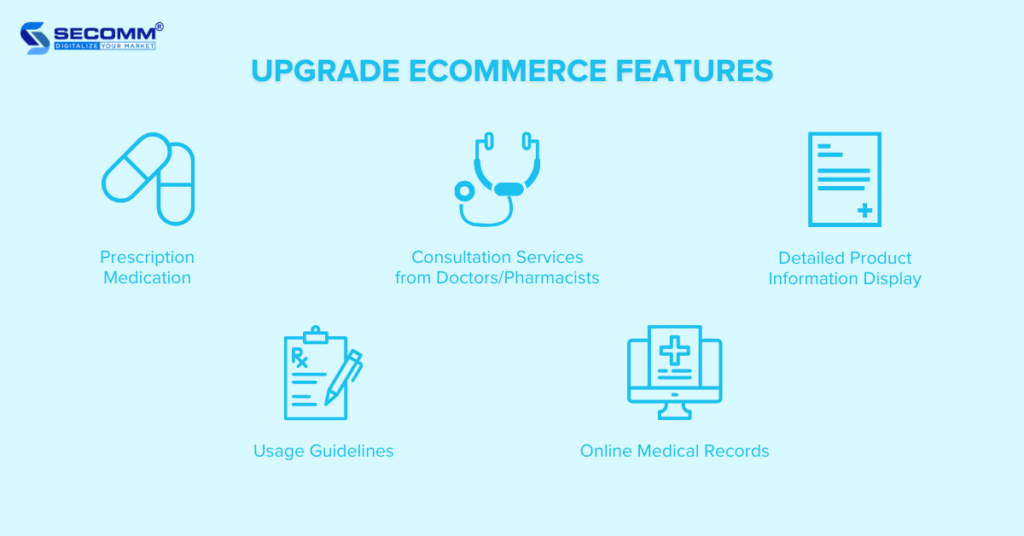
In addition, businesses need to consistently update and enhance these features to meet user needs and keep pace with market trends.
When testing the eCommerce system, businesses need to thoroughly check the entire website and its features over a specific period to ensure order processing speed and website stability. If any issues arise, businesses should immediately contact the in-house team or development partner to adjust and improve the website accordingly before officially going live.
Once the pharmacy eCommerce website system is stable, businesses should focus on eCommerce marketing strategies or Omnichannel approaches to enhance their online pharmacy.
Additionally, regular maintenance, updates, and continuous system upgrades are essential to sustain growth and quickly adapt to changes in the eCommerce market in general and the healthcare market in particular.
The Bottom Line
In general, the journey of building a pharmacy eCommerce website in Vietnam is not an easy task. This work demands substantial investments of time and budget from businesses to research the most suitable eCommerce strategy for each stage of their development.
Understanding the challenges that businesses may encounter when building an online pharmacy, SECOMM is ready to provide custom solutions for developing an eCommerce system.
Contact SECOMM or call the hotline at 028 7108 9908 for a free consultation.
 2
2
 6,648
6,648
 0
0
 1
1Subscribe to get the latest eBook!
Hotline